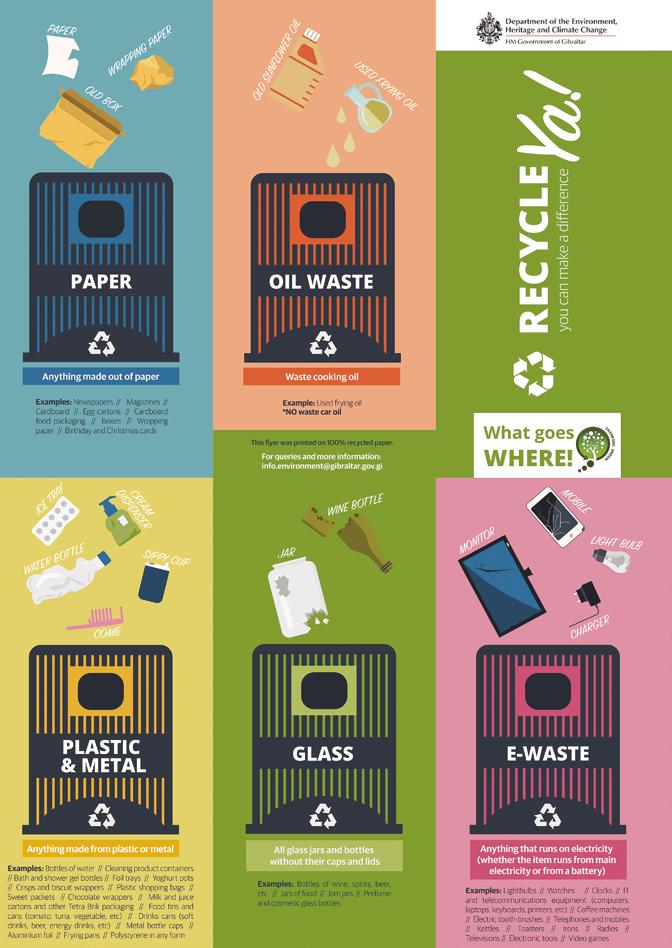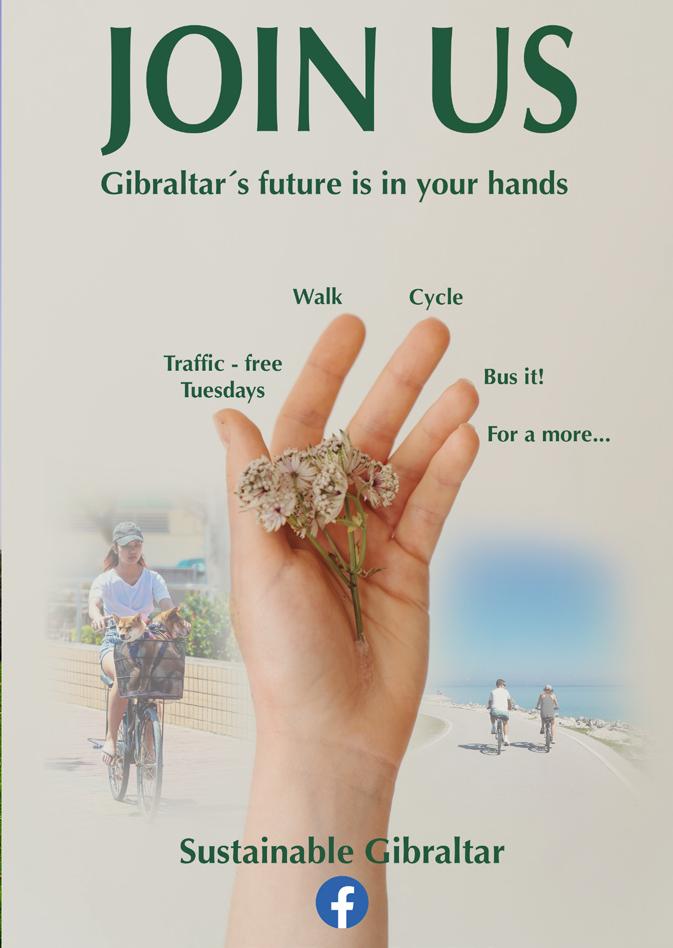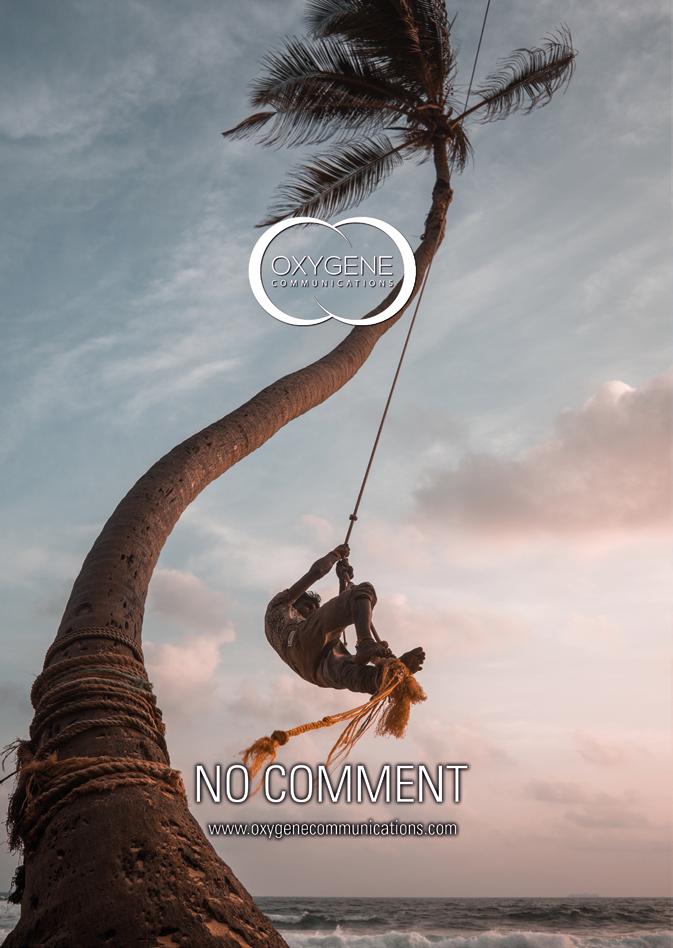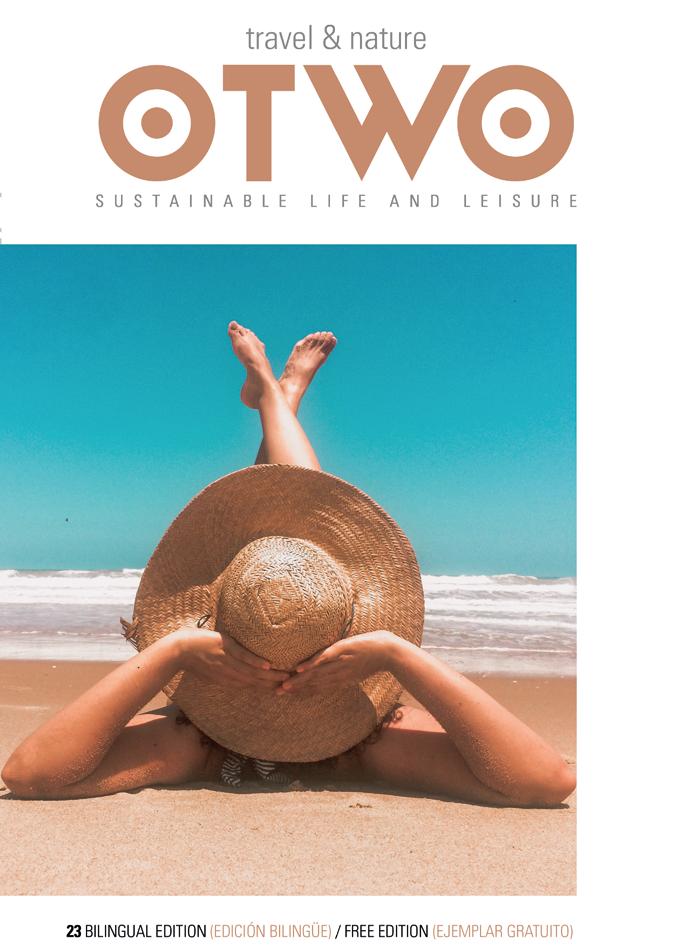
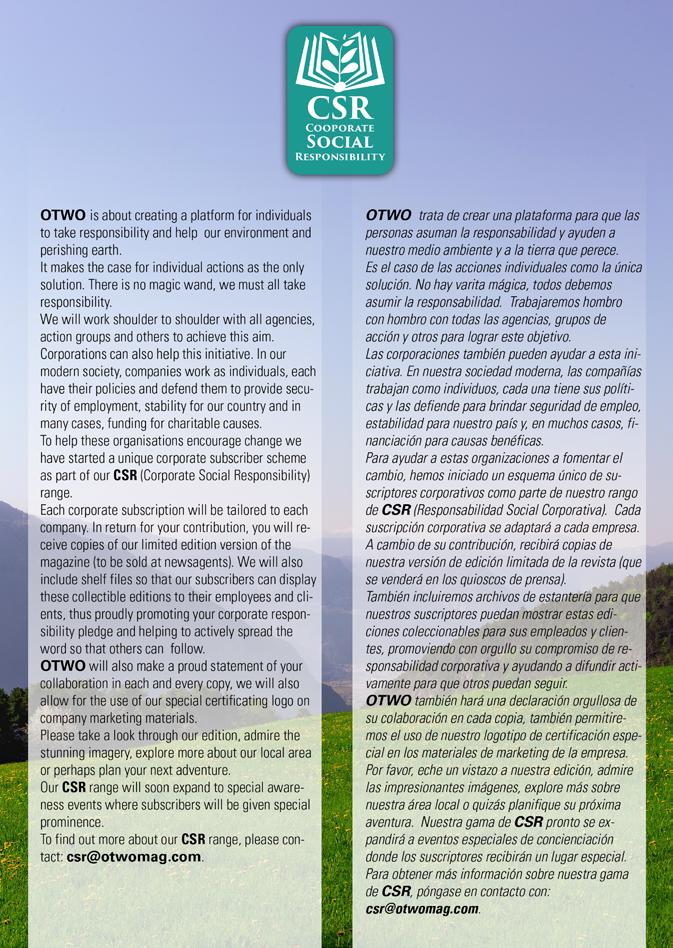
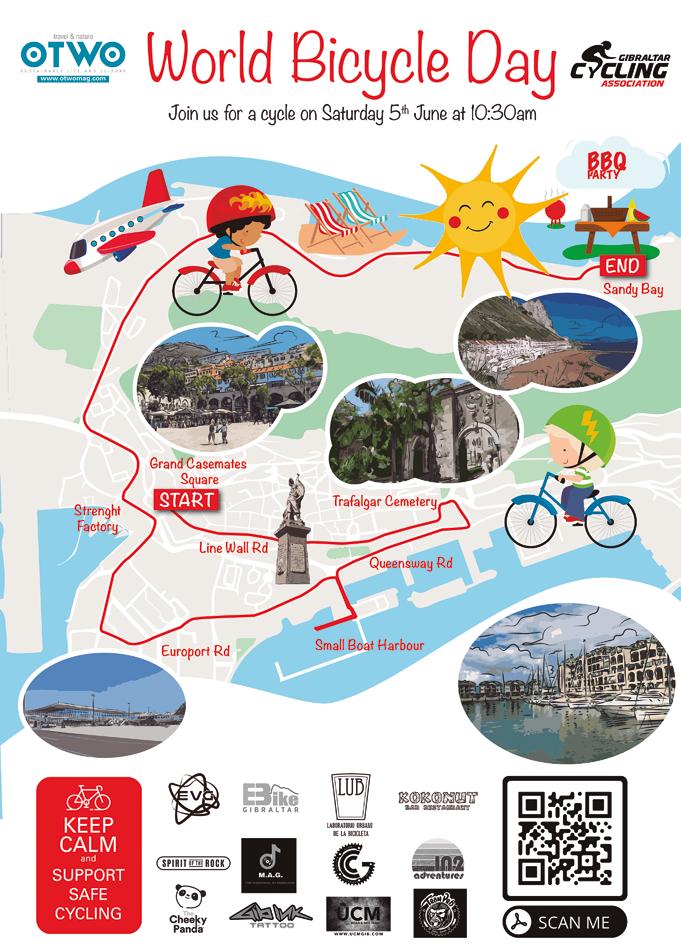
“Be patient and calm; no one can catch fish in anger”
Herbert Hoover
«Sea
paciente y tranquilo, nadie puede pescar con ira»
Herbert Hoover.
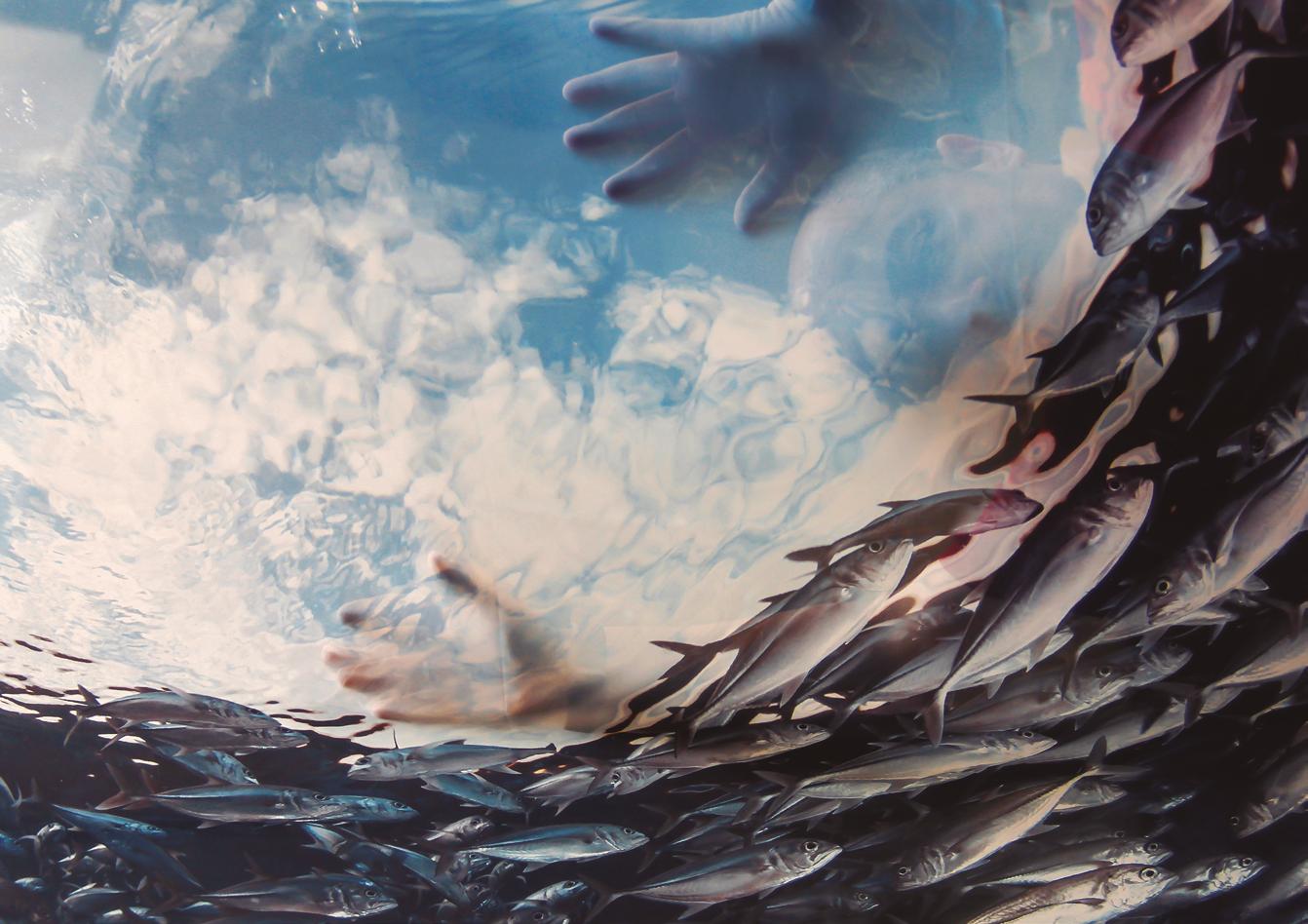
PHOTOGRAPHY: PEXELS.COM
“The more you adapt, the more interesting you are”
Martha Stewart
«Cuanto más te adaptas, más interesante eres»
Martha Stewart

“Isn’t life a waste of infinite deaths?”
Walt Whitman, Song of Myself
«¿No es la vida el desperdicio de muertes infinitas?»
Walt Whitman, Song of Myself


This volume was published in June 2021 by Oxygene Ltd.
OTWO Issue 23
Oxygene Ltd.Business Centre.
19 George´s Lane.
GX11 1AA, Gibraltar
Tel. +00350 54080331
www.oxygenecommunications.com
© Publishing: Oxygene Ltd.
Vanessa Byrne

Managing & Commercial Director
Juanjo Trujillo
Creative Director & Chief Designer
Sarah Birch
Columnist & Translation
Photographer:
Peter A. Mansfeld, Nautilus Project, Pexels, HMGOG, Office for Sustainable Development and Future
Generations, Sarah Birch, Hugo A. Mira Perales, Marina López, Juan Luis González, Yvette De la Rosa, David Rico, Gene Taylor, Pixabay, EBike Gibraltar, Proema.
Translations:
Sarah Birch, Ana Villata and Merlin Gutherless.
Cover photo: Rebeca Gonçalves.
Back Cover photo: Alex Azabache.
Printing: Santa Teresa Industrias Graficas SA
All rights reserved. No part of this publication may be reproduced, stored in a retrieval system or transmitted in any form or by any means, electronic, mechanical, photocopying, recording or otherwise, without the prior permission in writing from the publishers.
All rights reserved. ISSN 2633-7401



The flower of the month. La flor del mes.
Shorts
Eco Passion: 10 simple steps to a more sustainable lifestyle.
Eco Passion: 10 sencillos pasos para un estilo de vida más sostenible.
Learning for Sustainability. Aprendizaje para la sostenibilidad.
Restoration of Lord Airey’s. Restauración de Lord Airey’s.
Boats on the walls. Barcos en las paredes.
An innovative initiative for large-scale landscape restoration. Una iniciativa innovadora para la restauración a gran escala del paisaje.

Narrowing the Strait, Volume 2. Estrechando el Estrecho. Volumen 2.
Nature´s Way. Camino de naturaleza. Experiences
Nosha´s Corner

Quick Guide


OTWO 23
2021 001
Editorial 20 28 38 50 64 72 88 90 92 95 12 DejademirarmeysuscríbeteEsgratis
It’s free www.otwomag.com
looking atme
Vanessa Byrne / Managing Director
Welcome to our June 2021 edition. June has many special days focused on our world and how we are taking on the challenge of looking after it. World Bicycle Day (3rd June), World Environment Day (5th June), World Oceans Day (8th June). A very busy month of events…
World Bicycle Day falls this year on Thursday 3rd June, the OTWO team have joined with the Gibraltar Cycling Association to create an event to highlight this sustainable transport. Join us on Saturday 5th June at 10:30 in Casemates for a light cycle around Gibraltar, very family friendly. For those who want to extend your day we have arrange for a BBQ set menu at Kokonut Chiringuito priced £15. Join us for 3 hours of live acoustic music and even enjoy a monster paddle board free for all cyclists joining us on the day. Perfect day out with the family.
Mi Moana beach and underwater clean up event is set up in Playa de la Venus, Marbella. This will be to create awareness for World Oceans Day. For more information go to page 24/25 or contact Rotary Club Marbella-Guadalmina: www.marbella-guadalmina-rotary.club/. Mi Moana: www.mimoana.org/. Diving with Nic: www.divingwithnic.com.
The Nautilus Project have beach clean-up activities set up for Saturday 5th June for World Environment Day, for more information on this please contact them on info@thenautilusproject.co.
It will be great to so to see many of you join up to celebrate these very special yearly events. After all, we need to take care of our mother earth as she takes care of us.
This month we share with you an amazing article describing the spectacular work done by the Gibraltar Heritage and volunteers on the Restoration of Lord Airey’s. So much hard work has been put into this project and they have a lot more ahead of them. We are very grateful for the opportunity to have Pete show us around the area. The views are astounding and the engineering and history in these areas are beyond imagination. This is surely going to be a main tourist attraction once restored, it is quite the place. Pete and
Bienvenidos a nuestra edición de junio de 2021. Este mes tiene muchos días especiales centrados en nuestro mundo y en cómo asumimos el reto de cuidarlo. Día Mundial de la Bicicleta (3 de junio), Día Mundial del Medio Ambiente (5 de junio), Día Mundial de los Océanos (8 de junio). Un mes muy cargado de acontecimientos…
El Día Mundial de la Bicicleta cae este año el jueves 3 de junio, el equipo de OTWO se ha unido a la Asociación Ciclista de Gibraltar para crear un evento que destaque este transporte sostenible. Únase a nosotros el sábado 5 de junio a las 10:30 en Casemates para una ruta ligera alrededor de Gibraltar, muy familiar. Para los que quieran alargar el día hemos organizado un menú de barbacoa en el Chiringuito Kokonut con un precio de 15 libras. Únase a nosotros para tres horas de música acústica en vivo e incluso disfrutar de una tabla de «paddle monstruo» libre para todos los ciclistas que se unen a nosotros en el día. Un día perfecto con la familia.
Mi Moana playa y el evento de limpieza bajo el agua se desarrolla en la Playa de la Venus, Marbella. Esto será para crear conciencia para el Día Mundial de los Océanos. Para más información vaya a la página 24/25 o contacte con el Rotary Club Marbella-Guadalmina: www. marbella-guadalmina-rotary.club/. Mi Moana: www. mimoana.org. Diving with Nic: www.divingwithnic.com.
El Proyecto Nautilus ha organizado actividades de limpieza de playas para el sábado 5 de junio con motivo del Día Mundial del Medio Ambiente. Para más información, póngase en contacto con ellos en info@ thenautilusproject.co.
Será estupendo que muchos de vosotros os unáis para celebrar estos eventos anuales tan especiales. Al fin y al cabo, tenemos que cuidar de nuestra madre tierra como ella cuida de nosotros.
Este mes compartimos con ustedes un increíble artículo que describe el espectacular trabajo realizado por el Patrimonio de Gibraltar y los voluntarios en la restauración de Lord Airey’s. Se ha invertido mucho trabajo en este proyecto y tienen mucho más por delante. Estamos muy agradecidos por la oportunidad de que Pete nos enseñe la zona. Las vistas son asombrosas y la ingeniería y la historia de este lugar
the Gibraltar Heritage Trust are always looking for more volunteers to help. If you would like to get involved, please contact the Heritage Trust directly.
In this month’s COAMBA collaboration they share the incredible work done by the AlVelAl association. They have been around since 2016 and focus on large-scale landscape restoration. The main area they are focused on in is a territory that covers around 1,000,000 hectares between the regions of the Altiplano de Granada and Guadix, in the province of Granada; Los Vélez and Alto Almanzora, in Almería; and the Northwest of Murcia; in the Region of Murcia. Since they started AlVelAl has restored an area of 137 hectares, planted 140,000 trees and shrubs, sown 204,000 seeds, developed 60 kilometres of hedges and built 109 rainwater retention ponds. Absolutely amazing work!! Check them out on 64. Our monthly collaborator Juanlu González has this month written a piece adding his experience and knowledge to the Hemp debate. Very informative and well researched piece as one would expect from the excellent columnist. Find it on page 76 of this month’s edition.
As always, I would like to express our heartfelt gratitude to all our readers, collaborators, contributors and supporters. Please remember to be kind to each other and our world, respect all Peace & Love

van más allá de la imaginación. Seguramente será una de las principales atracciones turísticas una vez que se restaure, es todo un lugar. Pete y el Gibraltar Heritage Trust siempre están buscando más voluntarios para ayudar. Si desea participar, póngase en contacto directamente con el Heritage Trust.
En la colaboración del COAMBA de este mes comparten el increíble trabajo realizado por la asociación AlVelAl. Existen desde 2016 y se centran en la restauración del paisaje a gran escala. La zona principal en la que se centran es un territorio que abarca alrededor de 1.000.000 de hectáreas entre las comarcas del Altiplano de Granada y Guadix, en la provincia de Granada; Los Vélez y Alto Almanzora, en Almería; y el Noroeste de Murcia; en la Región de Murcia. Desde que comenzó, AlVelAl ha restaurado una superficie de 137 hectáreas, ha plantado 140.000 árboles y arbustos, ha sembrado 204.000 semillas, ha desarrollado 60 kilómetros de setos y ha construido 109 estanques de retención de aguas pluviales. ¡Un trabajo absolutamente increíble! Compruébelo en la página 64.
Nuestro colaborador mensual Juanlu González ha escrito este mes un artículo en el que añade su experiencia y conocimientos al debate sobre el cáñamo. Un artículo muy informativo y bien investigado, como cabe esperar del excelente columnista. Se encuentra en la página 76 de la edición de este mes. Como siempre, me gustaría expresar nuestra más sincera gratitud a todos nuestros lectores, colaboradores, ayudantes y simpatizantes. Por favor, recuerden ser amables con los demás y con nuestro mundo, respeten todos.
Paz y amor.
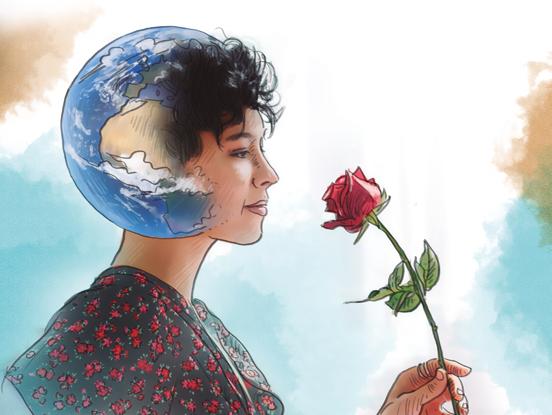
10
OTWO 23 / JUNE 2021
ILLUSTRATION: JUANJO TRUJILLO
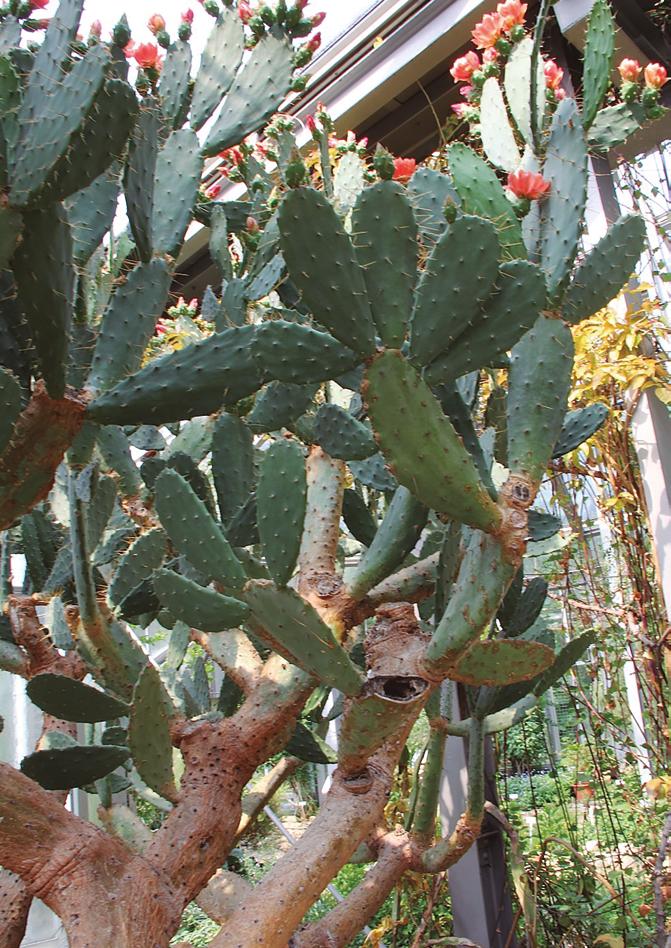

JUNE / Junio
Opuntia elatior
Dr Keith Bensusan Director Gibraltar Botanic Gardens, The Alameda.
The genus Opuntia is a large group of around two hundred cactus species, all of which are native to the Americas. It has an extremely extensive distribution, from Canada to Argentina. In fact, some species are so well adapted to cool conditions at the extremes of this range that they struggle in a Mediterranean climate. The best-known example is the Prickly Pear of Barbary Fig Opuntia ficus-indica, or ‘Chumbo’ as it is known locally, where its fleshy, juicy fruit are well-known and considered a delicacy during the summer months. This species is unknown in the wild and is in fact thought to be a hybrid, cultivated long ago for its fruit. It is also widely used to create spiny fences, as is often seen in Spain. But there are other species of Opuntia too and some of these produce beautiful flowers. Those of the Prickly Pear are yellow but the Red-flower Prickly Pear Opuntia elatior, a species from the northern half of South America, has very beautiful, deep pink flowers with a yellow centre. The species grows well at the Gibraltar Botanic Gardens, in the ‘Two Continents’ bed close to the George Don Gates and Healthfield Steps, at the gardens’ main entrance.
El género Opuntia es un gran grupo de unas doscientas especies de cactus, todas ellas nativas de América. Su distribución es muy amplia, desde Canadá hasta Argentina. De hecho, algunas especies están tan bien adaptadas a las condiciones de frío en los extremos de esta área de distribución que tienen dificultades en un clima mediterráneo. El ejemplo más conocido es la chumbera de Berbería Opuntia ficus-indica, o «Chumbo» como se la conoce localmente, donde sus carnosos y jugosos frutos son muy conocidos y se consideran un manjar durante los meses de verano. Esta especie es desconocida en la naturaleza y, de hecho, se cree que es un híbrido, cultivado hace tiempo por sus frutos. También se utiliza mucho para crear vallas espinosas, como se ve a menudo en España. Pero también hay otras especies de Opuntia y algunas de ellas producen hermosas flores. Las de la chumbera son amarillas, pero la chumbera de flor roja Opuntia elatior, una especie de la mitad norte de Sudamérica, tiene unas flores muy bonitas, de color rosa intenso con el centro amarillo. Esta especie crece bien en el Jardín Botánico de Gibraltar, en el parterre «Dos Continentes», cerca de las puertas de George Don y de la escalinata de Healthfield, en la entrada principal de los jardines.
12
Collection “The flower of the month”
13
OTWO 23 / JUNE 2021 OTWO 23 / JUNE 2021
Photography: Peter A. Mansfeld

GIBRALTAR’S YOUTH TAKE PART IN THE 61ST AND 62ND GREAT BEACH CLEAN
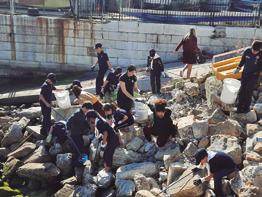
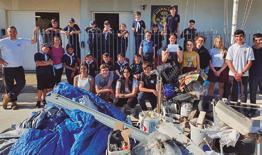
The 61st and 62nd Great Gibraltar Beach Cleans took place in May, with various groups of young people and local organisations getting involved. The Great Gibraltar Beach Clean initiative was started by the Nautilus Project back in February 2017, since then volunteers have removed over 3 tonnes of refuse from Gibraltar’s coastline.
The Ark Royal Sea Scouts and The Duke of Edinburgh Nautilus bronze participants took part in the 61st beach clean and tackled the slipway and revetments areas surrounding their headquarters. In just under an hour, the youth groups removed a massive 120kg of refuse.
JP Haulage volunteered their services by collecting all of the refuse to ensure it did not go to landfill or end up back in the sea. Metalrok Ltd. assisted by weighing the collected debris.
The 62nd Beach Clean saw the Hebrew Primary School students and the silver Duke of Edinburgh International Award participants join together to remove waste from Western Beach. All in all, they removed 44kg of plastic waste from the shoreline in just under an hour. Metalrok Ltd. collected, weighed
and sorted the refuse to ensure it was recycled and did not end up in landfill.
The Nautilus Project thanked the participants and said, “A massive, joint effort saw huge amounts of debris being retrieved. Truly heartwarming to see our youth actively involved and taking the lead”.
Los jóvenes de Gibraltar participan en la 61ª y 62ª Gran Limpieza de Playas
La 61ª y 62ª edición de la Gran Limpieza de Playas de Gibraltar tuvo lugar en mayo, con la participación de varios grupos de jóvenes y organizaciones locales. La iniciativa de la Gran Limpieza de Playas de Gibraltar fue iniciada por el Proyecto Nautilus en febrero de 2017, y desde entonces los voluntarios han retirado más de 3 toneladas de residuos de la costa de Gibraltar.
Los participantes de bronce de Ark Royal Sea Scouts y The Duke of Edinburgh Nautilus tomaron parte en la 61ª limpieza de playas y abordaron las zonas del varadero y los revestimientos que rodean su sede. En poco menos de una hora, los grupos de jóvenes retiraron 120 kg de basura.
JP Haulage se ofreció a recoger todos los residuos para evitar que fueran a parar al vertedero o al mar. Metalrok Ltd. ayudó a pesar los residuos recogidos.
En la 62ª edición de la limpieza de playas, los alumnos de la Escuela Primaria Hebrea y los participantes en el Premio Internacional Duque de Edimburgo de plata se unieron para retirar los residuos de la Playa Occidental. En total, retiraron 44 kg de residuos de plástico de la costa en poco menos de una hora. Metalrok Ltd. recogió, pesó y clasificó los residuos para asegurarse de que fueran reciclados y no acabaran en el vertedero.
El Proyecto Nautilus dio las gracias a los participantes y declaró: «En un esfuerzo masivo y conjunto se recuperaron enormes cantidades de desechos. Es realmente reconfortante ver a nuestros jóvenes participando activamente y tomando la iniciativa».
SECOND OIL SPILL OF THE YEAR HITS ROSIA & CAMP BAY
The origin of an oil spill found accumulating on the shores of Rosia Bay, Camp Bay and Little Bay on Monday 10th May is yet to be determined. An
investigation into the cause is underway. However, local environmental groups have expressed their deep concern that this is the second spill in the area in the last few months.
A statement issued by the Government of Gibraltar said that at the time the oil spill was reported, the tide and wind were coming from a northwesterly direction. Initial inspections of vessels anchored in Gibraltar found no potential source.
Brightside, the Port Authority RHIB, the Bunker Superintendent and technical officers from the Department for the Environment were dispatched to access the area and begin the clean-up operations. Salvamento Maritimo was also informed of the situation.
The worst affected areas were mostly cleaned up by the following day, the GPA and Dept. of the Environment are regularly assessing the affected areas and will continue to do so in the coming days.
The Environmental Safety Group also issued a statement expressing its concern that, yet another spill has hit Gibraltar’s shores this year. “The thick black sludge was present in worrying levels at Rosia Bay and reports were made with the Department of the Environment responding promptly to establish immediate clean-up operations with the help from Brightside. This oil spill could have originated elsewhere and is the subject of yet another investigation following the spill seen within our harbour wa-
ters over the weekend. Large or small, these spills are becoming all too frequent and are damaging our natural environment and are unacceptable. The Port is called upon to fully apply its resources to ensure standards are being followed and identify and fine polluters”.
El segundo derrame de petróleo del año afecta a la Bahía de Rosia y Campamento
Todavía no se ha determinado el origen de un vertido de petróleo que se acumuló en las costas de la bahía de Rosia, la bahía de Camp y la bahía pequeña el lunes 10 de mayo. Se está investigando la causa. Sin embargo, los grupos ecologistas locales han expresado su profunda preocupación por tratarse del segundo vertido en la zona en los últimos meses.
En un comunicado emitido por el Gobierno de Gibraltar se afirma que en el momento en que se produjo el vertido de petróleo, la marea y el viento procedían de la dirección noroeste. Las primeras inspecciones de los barcos anclados en Gibraltar no encontraron ninguna fuente potencial.
El Brightside, el RHIB de la Autoridad Portuaria, el Superintendente de Búnkeres y funcionarios técnicos del Departamento de Medio Ambiente fueron enviados para acceder a la zona y comenzar las operaciones de limpieza. También se informó a Salvamento Marítimo de la situación.
Las zonas más afectadas se limpiaron en su ma-

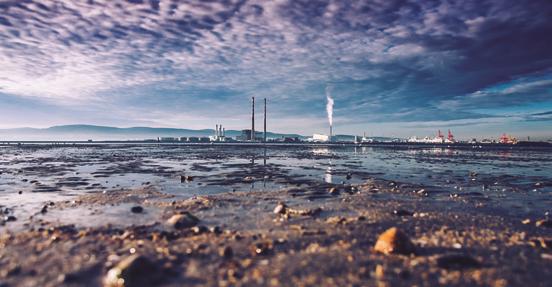
14 OTWO 23 / JUNE 2021 OTWO 23 / JUNE 2021 15
23

yor parte al día siguiente; el GPA y el Departamento de Medio Ambiente están evaluando periódicamente las zonas afectadas y seguirán haciéndolo en los próximos días.
El Grupo de Seguridad Medioambiental también emitió un comunicado en el que expresaba su preocupación por el hecho de que un nuevo vertido haya llegado a las costas de Gibraltar este año. «El lodo negro y espeso estaba presente en niveles preocupantes en la Bahía de Rosia y se hicieron informes con el Departamento de Medio Ambiente respondiendo rápidamente para establecer operaciones de limpieza inmediatas con la ayuda de Brightside. Este vertido de petróleo podría haberse originado en otro lugar y es objeto de otra investigación tras el vertido observado en las aguas de nuestro puerto el fin de semana. Grandes o pequeños, estos vertidos se están volviendo demasiado frecuentes y están dañando nuestro entorno natural y son inaceptables. Se pide al puerto que aplique plenamente sus recursos para garantizar el cumplimiento de las normas e identificar y multar a los contaminadores».
FRANCE COULD SOON INTRODUCE SCHEME TO SWAP OLD CARS FOR E-BIKES
A new scheme to offer people in France the chance to exchange their old vehicle for an electric or folding bike was approved by lawmakers in a preliminary vote held at the National Assembly.
The vote was an amendment to a draft climate bill that aims to reduce greenhouse emissions by 40% in 2030 from 1990 levels.
If the measure is fully passed, vehicle owners will be able to hand their old cars in for scrap in exchange for a €2500 grant (£2150) to purchase an E-Bike.
The new legislation will help France reach its greenhouse gas emissions goals by significantly reducing transport-based carbon emissions. It will also have a positive impact on citizens health, air quality and reducing traffic and congestion.
The generous grant would allow individuals to either purchase a top of the range French-made E-Bike or a pair of more economical imported E-bikes for families.
A similar scheme was rolled out in Lithuania last year. Citizens receive €1000 to purchase a new elec-
tric bicycle, bicycle, e-scooter, e-moped, e-motorcycle or even public transportation credits after handing in their old car. The schemes initial budget was €8 million. However, the initiative proved so popular it was increased by an additional $3 million.
Francia podría introducir pronto un plan para cambiar los coches viejos por bicicletas eléctricas
Los legisladores aprobaron, en una votación preliminar celebrada en la Asamblea Nacional, un nuevo plan para ofrecer a los franceses la posibilidad de cambiar su viejo vehículo por una bicicleta eléctrica o plegable.
La votación fue una enmienda a un proyecto de ley sobre el clima que pretende reducir las emisiones de efecto invernadero en un 40% en 2030 con respecto a los niveles de 1990.
Si la medida se aprueba en su totalidad, los propietarios de vehículos podrán entregar sus viejos coches para su desguace a cambio de una subvención de 2500 euros (2150 libras) para comprar una bicicleta eléctrica.
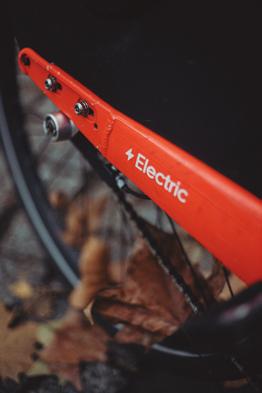
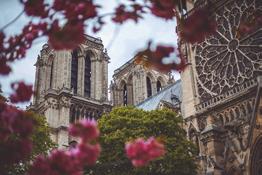
La nueva legislación ayudará a Francia a alcanzar sus objetivos en materia de emisiones de gases de efecto invernadero al reducir de forma significativa las emisiones de carbono procedentes del transporte. También tendrá un impacto positivo en la salud de los ciudadanos, la calidad del aire y la reducción del tráfico y la congestión.
La generosa subvención permitirá a los particulares adquirir una bicicleta eléctrica de alta gama fabricada en Francia o un par de bicicletas eléctricas importadas más económicas para las familias.
El año pasado se puso en marcha un plan similar en Lituania. Los ciudadanos reciben 1.000 euros para comprar una nueva bicicleta eléctrica, una moto eléctrica, un ciclomotor eléctrico o incluso créditos para el transporte público tras entregar su viejo coche. El presupuesto inicial del programa era de 8 millones de euros. Sin embargo, la iniciativa resultó ser tan popular que se incrementó en 3 millones más.

THIRD OF GLOBAL FOOD PRODUCTION THREATENED BY CLIMATE CRISIS.
New research by scientists at the Aalto University in Finland suggests that if greenhouse gas emissions continue to rise, causing global average temperatures to go up by the forecast increase of 3.7C, a third of global food production will be at risk.
The researchers found that 95% of current crop production is in areas they define as “safe climatic space”, regions where temperature, rainfall and aridity fall within specific parameters.
Global food production is already stretched to maximum capacity, with no more space to accommodate demand. But as temperatures go up and
weather patterns change, many of these important food growing areas will be negatively impacted by a loss of viable land, water shortages and decreased crop productivity. Livestock farming will also be affected.
Areas most at risk of leaving these safe climatic conditions if global temperature increase by 3.7C are south and south-eastern Asia and Africa’s Sudano-Sahelian zone. Some areas like the Nordic regions would see increased food production, but this growth would be nowhere near enough to compensate for the loss of vital food production areas further south.
The research found that in a high-emissions scenario, by the end of the century there could be as much as 4 million sq. km of new desert around the world.
However, if emissions are reduced drastically and global temperatures are limited to a rise of 1.5C or 2C as per the goals set out in the Paris Agreement, only about 5%–8% of global food production would be at risk.
Un tercio de la producción mundial de alimentos se ve amenazada por la crisis climática
Una nueva investigación realizada por científicos de la Universidad de Aalto (Finlandia) sugiere que, si las emisiones de gases de efecto invernadero siguen aumentando, provocando un incremento de la temperatura media mundial de 3,7C, un tercio de la producción mundial de alimentos estará en peligro.
Los investigadores descubrieron que el 95% de la producción actual de cultivos se encuentra en zonas que definen como «espacio climático seguro», regiones en las que la temperatura, las precipitaciones y la aridez se encuentran dentro de unos parámetros específicos.
La producción mundial de alimentos ya está al límite de su capacidad, sin más espacio para acomodar la demanda. Sin embargo, a medida que aumenten las temperaturas y cambien los patrones climáticos, muchas de estas importantes zonas de cultivo de alimentos se verán afectadas negativamente por la pérdida de tierras viables, la escasez de agua y la disminución de la productividad de los cultivos. La ganadería también se verá afectada.
Las zonas que corren más riesgo de abandonar es-
17 16
OTWO 23 / JUNE 2021 OTWO 23 / JUNE 2021

tas condiciones climáticas seguras si la temperatura global aumenta en 3,7C son el sur y el sureste de Asia y la zona sudanosaheliana de África. Algunas zonas, como las regiones nórdicas, experimentarían un aumento de la producción de alimentos, pero este crecimiento no sería ni mucho menos suficiente para compensar la pérdida de zonas vitales de producción de alimentos más al sur.
La investigación ha descubierto que, en un escenario de altas emisiones, a finales de siglo podría haber hasta 4 millones de kilómetros cuadrados de nuevos desiertos en todo el mundo.

Sin embargo, si las emisiones se reducen drásticamente y las temperaturas globales se limitan a un aumento de 1,5C o 2C, según los objetivos establecidos en el Acuerdo de París, sólo estaría en riesgo entre el 5% y el 8% de la producción mundial de alimentos.
IBERIAN BISON, RECOVERING WHAT IS FREE
14,000 years ago, the Spanish venerated the bison. In the Paleolithic sites they painted this bovid with more care and detail than the aurochs and tarpanes. This book proposes to recover it.
Now that, in certain marginal areas of Spain, extensive livestock farming is coming to an end due to lack of profitability, it is known that cows, horses and donkeys must be de-domesticated and given back their freedom.
Rewilding advocates throughout Europe the recovery of wildlife, including extinct wildlife, in order to maintain the ecological balance of ecosystems.
Rewilding with bison, aurochs and tarpanes to attract a vanguard of the Information Society to help develop a profitable digital economy. A population reinforcement of the rural environment with neighbors who do not need to exploit the environment to survive, nor depend on the public budget; who obtain their income from teleworking and digital production.
A magnificent book by Benigno Varillas, a pioneer and seminal naturalist of international prestige, to whom we dedicated an extensive interview in OTWO 21.
Book “Iberian Bison, Recovering the Free” self edited by Benigno Varillas. May 2021. 200 pages.
And at an affordable price of € 15. You can purchase it at:
https://elcarabo.com/producto/recuperar-lo-libre/
Bisonte ibérico, recuperar lo libre
Hace 14.000 años los españoles venerában al bisonte. En los yacimientos del Paleolítico pintaban a este bóvido con más esmero y detalle que a los uros y a los tarpanes. Este libro plantea recuperarlo. Hoy que en ciertas zonas marginales de España, la ganadería extensiva toca a su fin por falta de rentabilidad, es conocido que se ha de de-domesticar y devolver la libertad a vacas, caballos y asnos. El Rewilding propugna en toda Europa recuperar la fauna salvaje, incluida la extinta, para mantener el equilibrio ecológico de los ecosistemas.
Resilvestrar con bisontes, uros y tarpanes para atraer a una vanguardia de la Sociedad de la Información que ayude a desarrollar una economía digital rentable. Un refuerzo poblacional del medio rural con vecinos que no necesiten explotar el medio para sobrevivir, ni dependan de presupuesto público; que obtengan sus ingresos del teletrabajo y de la producción digital.
Un magnífico libro de Benigno Varillas, un pionero y seminal naturalista de reconocido prestigio internacional y al que le dedicamos una extensa entrevista en OTWO 21.
Libro “Bisonte ibérico, Recuperar Lo Libre” autoeditado por Benigno Varillas. Mayo de 2021. 200 páginas. Y a un asequible precio de 15 €.
Pueden adquirirlo en:
https://elcarabo.com/producto/recuperar-lo-libre/
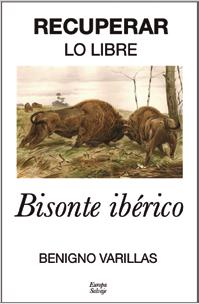
19 18
OTWO 23 / JUNE 2021 OTWO 23 / JUNE 2021





RECYCLE: GET TO KNOW HOW TO DO IT RIGHT AND MAKE SURE YOUR WASTE DOESN’T GO INTO LANDFILL
Recicla: aprende cómo hacerlo correctamente. Y asegúrate de que tus desechos no vayan a parar al vertedero
Recycling is very important as waste has a huge negative impact on the natural environment. We’re generating more non-biodegradable waste all the time, landfill sites are filling up fast and the rubbish is releasing harmful chemicals andgreenhouse gases.
By recycling all your waste, you’re reducing the pollution caused by waste, but remember it’s even better to not create the waste in the first place!
Recycling requires much less energy than making products from raw materials and therefore helps to preserve natural resources.
Make sure you understand what can be recycled, how you have to separate elements from packaging to make them suitable for recycling and how the process works in your area, so you’re putting the correct things in the correct bins to ensure your waste does not end up in landfill.
Reciclar es muy importante ya que los desechos tienen un gran impacto negativo en el medio ambiente. Generamos residuos no biodegradables continuamente, los vertederos están llenándose rápidamente y la basura está liberando productos químicos dañinos y gases de efecto invernadero.
¡Al reciclar todos tus residuos, estás reduciendo la contaminación causada por los residuos, pero recuerda que es incluso mejor no generar tales residuos!
El reciclaje consume mucha menos energía que la fabricación de productos a partir de materias primas y además ayuda a conservar los recursos naturales.
Asegúrate de que entiendes qué es lo que se puede reciclar, cómo tienes que separar cada artículo de su envase para poder reciclarlos por separado y cómo funciona el proceso en tu zona, de manera que coloques cada cosa en el contenedor adecuado para asegurarte de que tus residuos no acaben en el vertedero.

21 20
OTWO 23 / JUNE 2021 OTWO 23 / JUNE 2021


“Gibraltar’s rich heritage is one of its greatest assets and it is imperative that it is preserved and managed in a sustainable way to continue to benefit future generations”

The Gibraltar Heritage Trust
The Gibraltar Heritage Trust is an independent statutory body entrusted with the preservation of Gibraltar’s heritage. It aims to work in partnership with all like-minded bodies, both locally and internationally. The Trust is responsible to the people of Gibraltar for the preservation and enhancements of all aspects of Gibraltar’s heritage, which includes promotion culturally, educationally and in terms of tourism both for our local population and internationally. It works closely with the Government of Gibraltar and the private sector in fulfilling its aims. Operating on a not for profit basis all funding for Trust projects are raised through our annual membership drive, our commercial activities or through specific project targeted fundraising. All funds generated are applied to achieving the aims and objectives of the Trust.

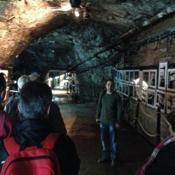
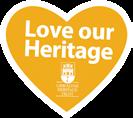
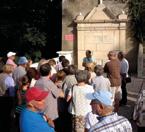
“The events that the Trust organises allow me and my partner to explore places that we simply would not have seen without the help and knowledge of the Trust”
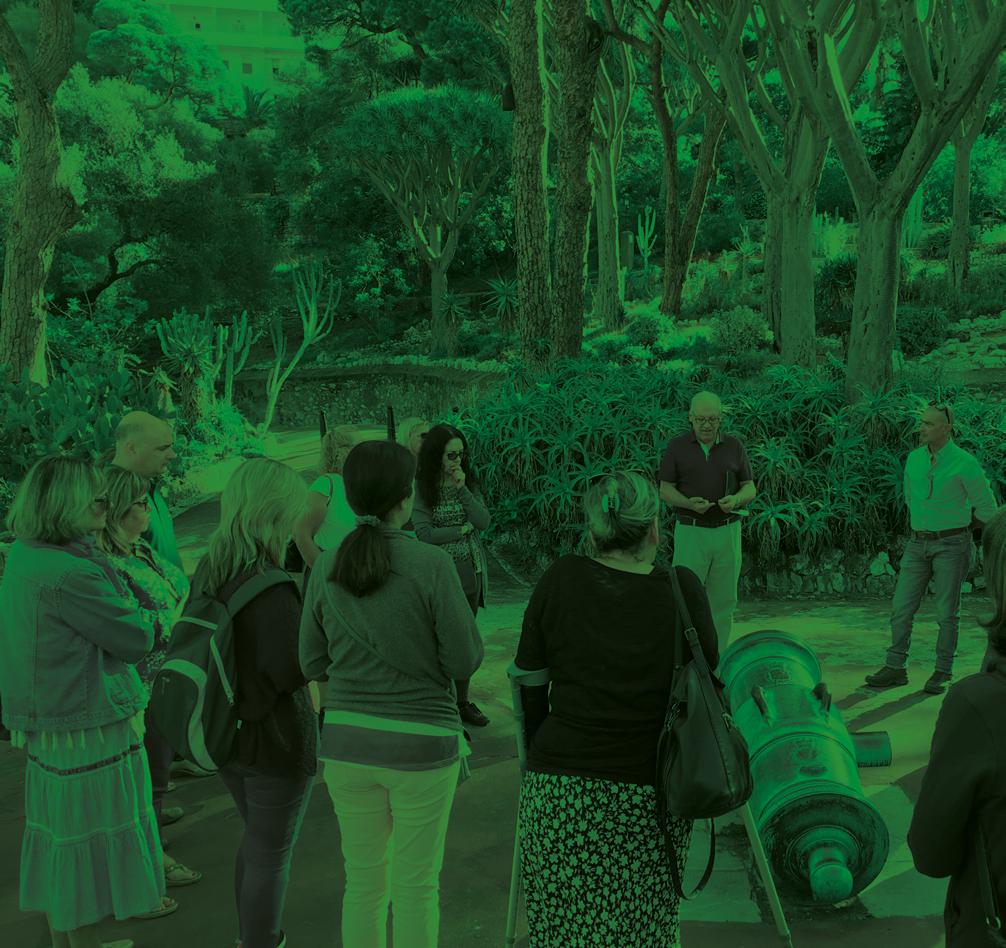
The Trust has a number of statutory and strategic functions to:
1.- Safeguard and enhance the quality and condition of Gibraltar’s historic environment.
2.- Promote wider understanding, enjoyment and appreciation of Gibraltar’s historic environment.
3.- Enhance Gibraltar’s Sense of Place.
4.- Encourage relevant bodies to make Gibraltar’s historic areas better places to live, visit and to invest in.
5.- Work with others to amplify the impact of the wider initiatives to improve the city and make Gibraltar a better place to live, visit and invest in.
6.- Work towards the implementation and enforcement of new heritage legislation, policies and guidelines.
7.- Be open, responsive, transparent, effective and efficient in our work.
By investing in the Trust you are investing in Gibraltar’s past, its present and its future.
With your annual membership, you support Gibraltar and the work that the Trust does to protect and enhance it, however, your membership also entitles you to:
• Access to the Trust’s monthly programme of events, including trips and organised excursions.
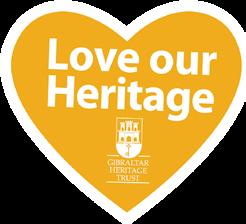
• Access, by appointment, to the Trust’s reference library of books related to Gibraltar and its past. (The Trust is accepting donations of books on Gibraltar to add to this resource).
• Free entry to the Gibraltar Museum.
• Free entry to the Upper Rock Nature Reserve, St Michael’s Cave, Great Siege Tunnels, Military Heritage Centre, Tower of Homage, Ape’s Den, Windsor Suspension Bridge and WWII Tunnels.
• Annual report, our regular e-newsletter direct to your inbox, updates and information on what’s happening on the Gibraltar heritage scene.
• Discounts and deals from local businesses added throughout the year.
• Discounts on all Gibraltar Heritage Trust Publications in our shop.

Gibraltar Heritage Trust
The Main Guard
13 John Mackintosh Square PO Box 683, Gibraltar t. (+350) 200 42844 admin@gibraltarheritagetrust.org.gi www.gibraltarheritagetrust.org.gi
23
JOIN US NOW VIA OUR WEBSITE OR POP INTO OUR SHOP

We Are People of Action
ROTARY ENDPLASTICSOUP INTERNATIONAL ACTION DAY WITH MI MOANA
5th June 2021
Somos gente de acción
ROTARY ENDPLASTICSOUP, DÍA INTERNACIONAL DE ACCIÓN CON MI MOANA 5 de junio de 2021
Rotary Club Marbella-Guadalmina and Mi Moana are organising a special event as part of the EndPlasticSoup, International Action Day to be held at the Plaza de Puerto Deportivo, Marbella, from 10.00 – 15.00.
Rotary Club Marbella-Guadalmina who is the Ambassador Club for the End Plastic Soup movement in Southern Spain together with the Rotary Clubs of Mijas, Marbella International and Estepona Sotogrande are actively promoting awareness and education. They have also helped sponsor an educational video created by Mi Moana Mi Moana, a registered association and the company Diving with Nic are committed to protecting the ocean and the environment by organising regular beach and ocean clean ups and educating the next generation to help them to reduce their impact on the environment.
The aim of the Action Day is to increase awareness of the challenges we face with plastic waste that, now more than ever with the Corona pandemic, has got worse. So we are challenging everyone to clean up the plastic waste, at home, on the street, in the park and on the beaches and in the rivers and sea. Every little bit helps. You might be shocked to see just how much plastic waste one household produces!!!
As part of this Action Day we will be showing videos of exciting new innovations in cleaning up plastic soup, downloading information on plastic pollution and recycling. We will be looking at the
El Rotary Club Marbella-Guadalmina y Mi Moana están organizando un evento especial como parte del EndPlasticSoup, Día de Acción Internacional que se celebrará en la Plaza de Puerto Deportivo, Marbella, de 10.00 - 15.00.
El Rotary Club Marbella-Guadalmina, que es el Club Embajador del movimiento End Plastic Soup en el sur de España, junto con los Clubes Rotarios de Mijas, Marbella International y Estepona Sotogrande, están promoviendo activamente la concienciación y la educación. También han ayudado a patrocinar un vídeo educativo creado por Mi Moana Mi Moana, una asociación registrada, y la empresa Diving with Nic se han comprometido a proteger el océano y el medio ambiente organizando limpiezas periódicas de playas y océanos y educando a las nuevas generaciones para ayudarles a reducir su impacto en el medio ambiente.
El objetivo del Día de Acción es aumentar la concienciación sobre los retos a los que nos enfrentamos con los residuos plásticos que, ahora más que nunca con la pandemia de la Corona, han empeorado. Por ello, desafiamos a todo el mundo a limpiar los residuos de plástico, en casa, en la calle, en el parque y en las playas y en los ríos y el mar. Cada pequeña cantidad ayuda. Te sorprenderá ver la cantidad de residuos de plástico que produce un hogar.
En el marco de este Día de Acción, proyectaremos vídeos de interesantes innovaciones en la limpieza de la sopa de plástico, y descargaremos información sobre la contaminación por plástico y el reciclaje.
OTWO 23 / JUNE 2021 25
beach clean-up and divers via a drone, demonstrating the work being done on the beaches and lots more.
There will be various activities for children that will include making their own drawings and statements for the world, colouring pictures, as well as demonstrating what pollution can be found on the beach and in the sea.
Mi Moana and Diving with Nic will be organising many activities on the beach. Go hunting for Plastic. Grab a rubber bucket from team members on the beach and collect as much plastic as possible. They will also be an educational table in their tent on the paseo.
Have a go to guess how many shells are in a jar and pay 2 Euros to help the cause. The winner gets a Mi Moana reusable water bottle.
Paint a shell at home and bring it along and get a sticker.
There will also be a “pop up” shop where you will be able to purchase Mi Moana t-shirts, keyholders and caps. With every purchase you will help us continue with our activities. You will also have a chance of signing up to become a member and receive our monthly Newsletter.
Diving with Nic was started in 2015 in response to Nic’s desire to operate a dive centre with a difference. They are the only dive centre in mainland Spain to be both a PADI Dive Centre and a BSAC Training Facility. There will also be information on the diving courses they give.
If you wish to wish to dive on the day, you must pre-register with Nic at www.divingwithnic.com
Please join us with your family, friends and dogs Dogs are only allowed on the paseo with leads.
It will be fun and educational!!!!!!!
For more information on the event please contact:
Rotary Club Marbella-Guadalmina - www.marbella-guadalmina-rotary.club
Mi Moana - www.mimoana.org
Diving with Nic - www.divingwithnic.com
Veremos la limpieza de las playas y los buzos a través de un dron, demostrando el trabajo que se realiza en las playas y mucho más.
Habrá varias actividades para los niños que incluirán hacer sus propios dibujos y declaraciones para el mundo, colorear dibujos, así como demostrar qué contaminación se puede encontrar en la playa y en el mar.
Mi Moana y Diving with Nic organizarán muchas actividades en la playa. Ve a la caza del plástico. Coge un cubo de goma de los miembros del equipo en la playa y recoge todo el plástico posible. También habrá una mesa educativa en su carpa del paseo.
Intenta adivinar cuántas caracolas hay en un tarro y paga 2 euros para ayudar a la causa. El ganador se llevará una botella de agua reutilizable Mi Moana.
Pinta una caracola en casa, llévala y consigue una pegatina.
También habrá una tienda “pop up” donde podrás adquirir camisetas, llaveros y gorras de Mi Moana. Con cada compra, nos ayudarás a continuar con nuestras actividades. También tendrás la oportunidad de inscribirte para hacerte socio y recibir nuestro boletín mensual.
Diving with Nic se inició en 2015 en respuesta al deseo de Nic de operar un centro de buceo con una diferencia. Son el único centro de buceo en España continental que es tanto un centro de buceo PADI como una instalación de formación BSAC. También habrá información sobre los cursos de buceo que imparten.
Si desea bucear ese día, debe inscribirse previamente con Nic en www.divingwithnic.com
Por favor, acompáñanos con tu familia, amigos y perros
Los perros sólo pueden entrar en el paseo con correa.
Será divertido y educativo!!!!!!
Para más información sobre el evento, ponte en contacto con:
Rotary Club Marbella-Guadalmina - www.marbella-guadalmina-rotary.club
Mi Moana - www.mimoana.org
Diving with Nic - www.divingwithnic.com

26 OTWO 23 / JUNE 2021 OTWO 23 / JUNE 2021 27

Learning for Sustainability
Prof Daniella Tilbury.
HMGOG Commissioner for Sustainable Development and Future Generations. Photographs: HMGOG, Office for Sustainable Development and Future Generations.
Aprendizaje para la sostenibilidad
Prof Daniella Tilbury, HMGOG Commissioner for Sustainable Development and Future Generations.
Fotógrafías: HMGOG, Office for Sustainable Development and Future Generations.
OTWO 23 / JUNE 2021 29 28 OTWO 23 / JUNE 2021
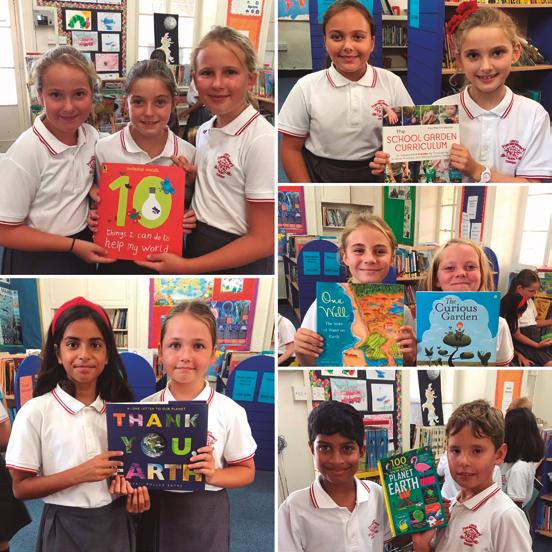
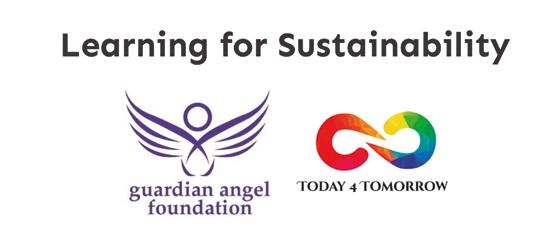
Sustainability can be fun, engaging and help build confidence in young learners. It promotes the development of capabilities associated with the ‘head’, ‘heart’ and ‘hand’ as children and teenagers learn about key issues that have an impact on people and planet.
Books, school gardens and other educational resources often inspire learners to engage with taking action for a better world. Many present real and relevant themes of interest to young minds. There are, however, many books in the market; some informed by educational experts who draw out learning outcomes and others produced by interest groups seeking to promote particular views of the world. To a parent, guardian or educator it can be difficult to choose amongst these resources as they are often packaged in similar ways with attractive images and themes that appeal to young and old.
Often a good indicator is to find the resources making explicit references to the UN Sustainable Development Goals or the SDGs. These provide a framework for identifying the areas or issues that underpin learning for sustainability. The SDGs address global challenges including: poverty; inequality; climate change; environmental degradation; peace and justice. They seek big changes in the way we live, organise and govern ourselves and involve children and young people in considering alterative futures to the ones we are currently destined for.
I am often asked if ‘sustainability’ is about the environment. Environmental issues do feature as part of the SDGs as they have and will continue to have an effect on our health, economic and social wellbeing. However, there is a difference between resources that support learning for sustainability and environmental education. Both provide important learning opportunities, especially for the young, but they are quite different in their intention and approaches. It has been suggested that environmentalism (and environmental education) is a movement against things – for example stopping pollution and other harmful activities. It is mostly concerned with engaging learners in action to improve the environment and challenge their own behaviours. Sustainability, on the other hand,
La sostenibilidad puede ser divertida, atractiva y ayudar a crear confianza en los jóvenes estudiantes. Fomenta el desarrollo de las capacidades asociadas a la “cabeza”, el “corazón” y la “mano”, ya que los niños y los adolescentes aprenden sobre cuestiones clave que tienen un impacto en las personas y el planeta. Los libros, los huertos escolares y otros recursos educativos suelen inspirar a los alumnos para que se comprometan a actuar por un mundo mejor. Muchos presentan temas reales y relevantes de interés para las mentes jóvenes. Sin embargo, hay muchos libros en el mercado; algunos informados por expertos en educación que extraen resultados de aprendizaje y otros producidos por grupos de interés que buscan promover visiones particulares del mundo. Para un padre, tutor o educador puede ser difícil elegir entre estos recursos, ya que a menudo están empaquetados de forma similar con imágenes y temas atractivos que atraen a jóvenes y mayores.
A menudo, un buen indicador es encontrar los recursos que hacen referencia explícita a los Objetivos de Desarrollo Sostenible de la ONU o los ODS. Éstos proporcionan un marco para identificar las áreas o temas que sustentan el aprendizaje para la sostenibilidad. Los ODS abordan desafíos globales como la pobreza, la desigualdad, el cambio climático, la degradación del medio ambiente, la paz y la justicia. Buscan grandes cambios en la forma en que vivimos, nos organizamos y nos gobernamos, e implican a los niños y a los jóvenes en la consideración de futuros alternativos a los que estamos destinados actualmente. A menudo me preguntan si la “sostenibilidad” tiene que ver con el medio ambiente. Las cuestiones medioambientales forman parte de los ODS, ya que tienen y seguirán teniendo un efecto sobre nuestra salud y nuestro bienestar económico y social. Sin embargo, hay una diferencia entre los recursos que apoyan el aprendizaje para la sostenibilidad y la educación medioambiental. Ambos proporcionan importantes oportunidades de aprendizaje, especialmente para los jóvenes, pero son muy diferentes en su intención y enfoques. Se ha sugerido que el ecologismo (y la educación ambiental) es un movimiento en contra de las cosas - por ejemplo, detener la contaminación y otras actividades dañinas. Se trata sobre todo de implicar a los alumnos en la acción para mejorar el medio ambiente y cuestionar sus propios comportamientos. La
30 OTWO 23 / JUNE 2021 OTWO 23 / JUNE 2021 31
is concerned with change for the longer term and deals with the socio-economic contexts that create environmental issues in the first place. It avoids ‘doom and gloom’ approaches and recognizes that individual actions by themselves cannot change the world. They both approach the same issues but in different ways. If you would like to learn more about the difference do check out: WWF’s ‘Weathercocks and Signposts’ (2008).
Another common misunderstanding, is that sustainability refers to ‘retaining what we have’ or ‘sustaining the current situations’, when in fact sustainability is about change and creating a fairer and safer future. It reframes relationships whether it be between producers and environments; consumers and suppliers; or, young people and decision-makers.
As parents and guardians, it is important that we involve our children and young adults in learning about sustainability: challenging misconceptions; encouraging them to question; and, helping them find their own way through this complex area. Our young people will, in future, need to anticipate, become involved, and in some cases address sustainability issues that we are only just beginning to comprehend.
Recognizing these challenges, the Office of the Commissioner for Sustainable Development and Future Generations partnered with the Guardian Angel Foundation and the Department of Education to support learning for sustainability in local educational establishments and the community. Resources were purchased that avoided treating environmental and conservation issues in isolation of the economic and social considerations that underpin them. Equally, textbooks and reading books were chosen that encouraged children and young people to envision how the world could be rather than how it is and to identify ways in which we can work towards shaping the future. It was important that texts that preached particular ‘behaviours’ in children and young people were avoided as well as resources that promote alarmist concerns for the future. Our young do need to know that we face significant challenges but we also have a duty to empower them, through learning, with the tools to process, decide and respond in their own way.
sostenibilidad, en cambio, se ocupa del cambio a largo plazo y se ocupa de los contextos socioeconómicos que crean los problemas medioambientales en primer lugar. Evita los enfoques catastrofistas y reconoce que las acciones individuales por sí solas no pueden cambiar el mundo. Ambos abordan los mismos problemas, pero de forma diferente. Si quieres saber más sobre la diferencia, consulta: WWF’s ‘Weathercocks and Signposts’ (2008).
Otro malentendido común es que la sostenibilidad se refiere a “conservar lo que tenemos” o “mantener las situaciones actuales”, cuando en realidad la sostenibilidad tiene que ver con el cambio y la creación de un futuro más justo y seguro. La sostenibilidad replantea las relaciones entre los productores y el medio ambiente, los consumidores y los proveedores, y los jóvenes y los responsables de la toma de decisiones. Como padres y tutores, es importante que impliquemos a nuestros hijos y jóvenes en el aprendizaje de la sostenibilidad: desafiando los conceptos erróneos, animándoles a cuestionar y ayudándoles a encontrar su propio camino en esta compleja área. En el futuro, nuestros jóvenes tendrán que anticiparse, implicarse y, en algunos casos, abordar cuestiones de sostenibilidad que apenas estamos empezando a comprender. Reconociendo estos retos, la Oficina del Comisionado para el Desarrollo Sostenible y las Generaciones Futuras se asoció con la Fundación Ángel de la Guarda y el Departamento de Educación para apoyar el aprendizaje para la sostenibilidad en los centros educativos locales y en la comunidad. Se adquirieron recursos que evitaban tratar las cuestiones medioambientales y de conservación al margen de las consideraciones económicas y sociales que las sustentan. Asimismo, se eligieron libros de texto y de lectura que animaran a los niños y a los jóvenes a imaginar cómo podría ser el mundo en lugar de como es, y a identificar las formas en que podemos trabajar para dar forma al futuro. Era importante que se evitaran los textos que predicaban determinados “comportamientos” en los niños y jóvenes, así como los recursos que promueven preocupaciones alarmistas para el futuro. Nuestros jóvenes necesitan saber que nos enfrentamos a retos importantes, pero también tenemos el deber de dotarles, a través del aprendizaje, de las herramientas necesarias para procesar, decidir y responder a su manera. De lo contrario, tendremos niños que actúan
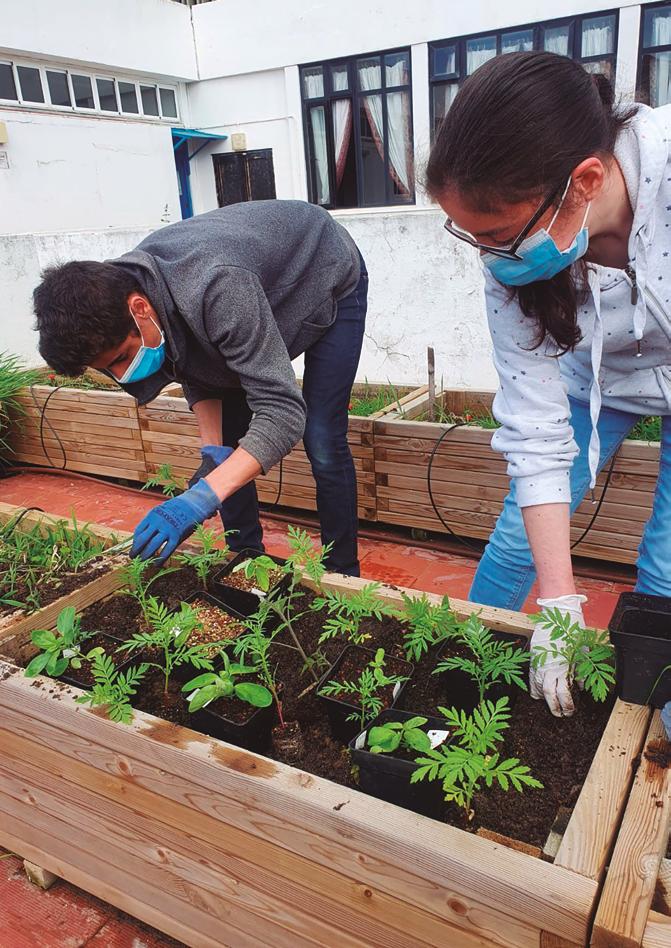
32 OTWO 23 / JUNE 2021 OTWO 23 / JUNE 2021 33
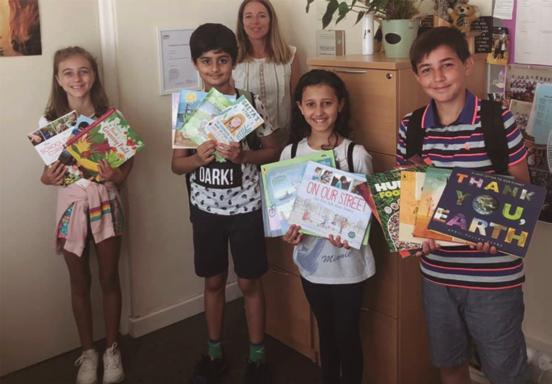
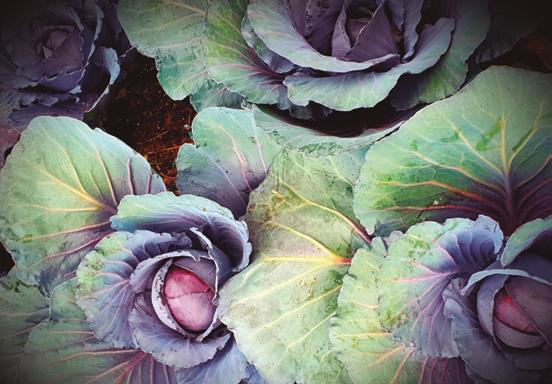
Otherwise, we have children who act without understanding or who believe that single actions will make a difference.
The resources for this initiative chosen aligned with the priority themes and topics taught in local schools through the national curriculum and encouraged active learning approaches as well as futures, creative and critical thinking – key tenets of Education for Sustainability.
The partnership purchased storybooks, readers, fact-finding texts, and growing food manuals that can bring sustainability topics such as biodiversity, carbon footprints, poverty, privilege, cultural diversity, equal rights and justice alive in classrooms. Included in the purchases were resources that enable learners to engage practically in growing food in schools, looking after green areas, and making a positive contribution to people in our local community. The books were distributed across schools including Bayside and Westside Schools, Bishop Fitzgerald School, St Anne’s School, St Bernard’s Lower Primary School, St Joseph’s Lower and Upper Primary Schools, the Hebrew Primary School, Governors Meadow School, Notre Dame School, St Paul’s Lower Primary School. Book displays exhibiting these new resources can be found across our schools. The Gibraltar Cultural Services also participated in the initiative by purchasing books for the John Mackintosh Library. The Gibraltar College and a handful of schools requested resources to support the development of a food growing area on their grounds. Funds were also generously provided by the Guardian Angel Foundation for these purposes. Many schools will be giving a spotlight to these resources on World Environment Day, June 5th, to engage students in learning for sustainability. If you have children or young adults in your life, do consider borrowing the books from the library or asking your school about these resources. If you are considering a birthday gift for a child or young adult, give some thought to purchasing learning resources that can inspire and challenge our next generation to think about the future in different ways. More information about the initiative can be found at www.futuregenerations.gi.
sin comprender o que creen que sus acciones aisladas marcarán la diferencia.
Los recursos para esta iniciativa elegida se alinearon con los temas prioritarios y las materias que se enseñan en las escuelas locales a través del plan de estudios nacional y fomentaron los enfoques de aprendizaje activo, así como el pensamiento futuro, creativo y crítico, principios clave de la Educación para la Sostenibilidad.
La asociación adquirió libros de cuentos, libros de lectura, textos informativos y manuales de cultivo de alimentos que pueden dar vida en las aulas a temas de sostenibilidad como la biodiversidad, la huella de carbono, la pobreza, los privilegios, la diversidad cultural, la igualdad de derechos y la justicia. Las compras incluían recursos que permiten a los alumnos participar de forma práctica en el cultivo de alimentos en las escuelas, en el cuidado de las zonas verdes y en la contribución positiva a las personas de nuestra comunidad local. Los libros se distribuyeron en las escuelas Bayside y Westside, Bishop Fitzgerald School, St Anne’s School, St Bernard’s Lower Primary School, St Joseph’s Lower y Upper Primary School, Hebrew Primary School, Governors Meadow School, Notre Dame School, St Paul’s Lower Primary School. Los expositores de libros que exhiben estos nuevos recursos pueden encontrarse en todas nuestras escuelas. Los Servicios Culturales de Gibraltar también participaron en la iniciativa comprando libros para la Biblioteca John Mackintosh. El Gibraltar College y un puñado de escuelas solicitaron recursos para apoyar el desarrollo de una zona de cultivo de alimentos en sus terrenos. La Fundación Ángel de la Guarda también aportó generosamente fondos para estos fines.
Muchas escuelas darán protagonismo a estos recursos en el Día Mundial del Medio Ambiente, el 5 de junio, para que los alumnos se comprometan a aprender sobre la sostenibilidad. Si tiene niños o jóvenes en su vida, considere la posibilidad de tomar prestados los libros de la biblioteca o de preguntar a su escuela sobre estos recursos. Si está pensando en hacer un regalo de cumpleaños a un niño o un joven, piense en comprar recursos de aprendizaje que puedan inspirar y desafiar a nuestra próxima generación a pensar en el futuro de manera diferente. Puede encontrar más información sobre la iniciativa en www.futuregenerations.gi.
34 OTWO 23 / JUNE 2021 OTWO 23 / JUNE 2021 35
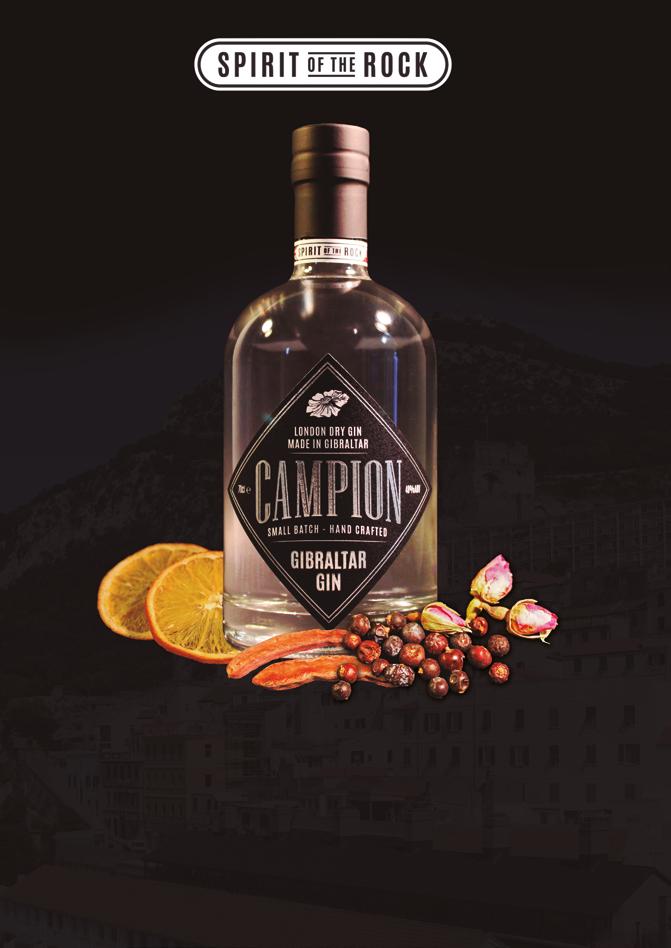



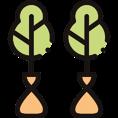


Going Plastic Free
Here at The Cheeky Panda, we’re striving to make the world a better, greener pla ce. How do we do that, you ask? Well, it’s all here, in black and white. Just like your favourite panda, Colin. See what we did there? Plenty more where that came from.

Reducing Deforestation, Saving Trees
Go outside and look at a tree. Go on, do it now. We’ll know if you don’t. Now imagine chopping that lovely tree down, turning it into something you wipe with and flushing it. That’s what we’re doing right now, but on a massive scale - 27,000 times per day to be exact. Luckily, bamboo grows super-fast AND it doesn’t mind being made into loo roll. So, we’ll stick to making our products from that, thank you very much. Now, we’re off to go read under a Willow.
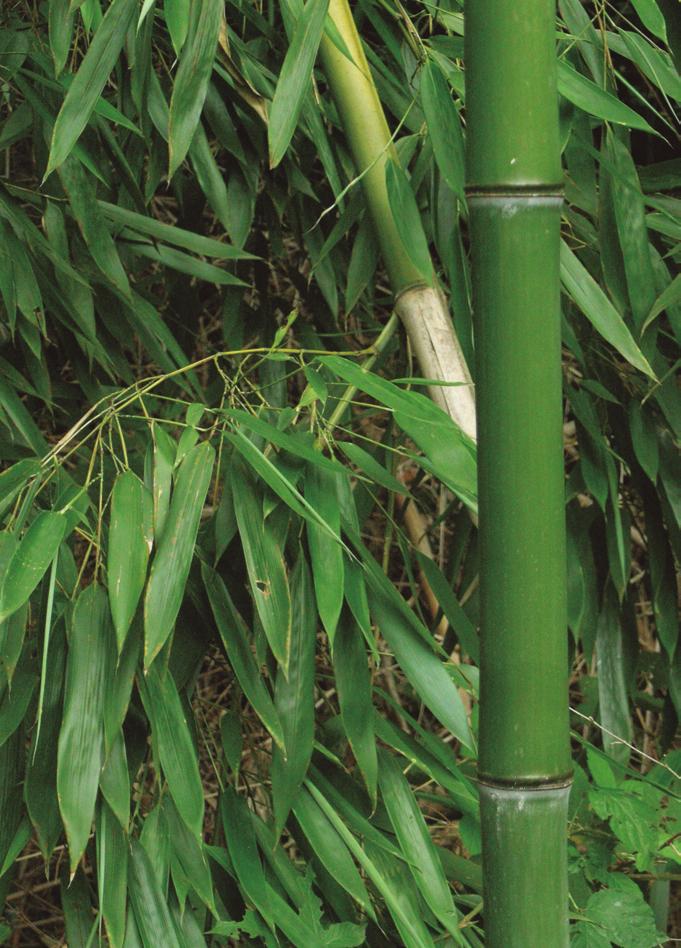
Plastic Free • Carbon Footprint • Vegan & Cruelty Free Why Bamboo • Kind to Skin FOR MORE INFORMATION CLICK ON EACH SECTION PRODUCT RANGE Toilet Roll, Kitchen Roll, Facial Tissue, Pocket Tissue, Baby Wipes, Anti-Bacterial Handy Wipes, Anti-Bacterial Surface Wipes, Make-Up Cleansing Wipes, Straws, Shaker Straws, Baby Nappies.
www.bamboopanda.gi Shop via our new website now live! Discounted Products, Monthly Subscription Services and more! The Future is Cheeky 8 George’s Lane, Gibraltar / info@spiritoftherock.gi / +350 540 67487 / www.spiritoftherock.gi 140,000 Trees Saved We use super speedy, renewable Bamboo instead GIBRALTAR GIN EXPERIENCE NOW AVAILABLE ABOARD THE SUNBORN CALL PETER 54067487 TO BOOK
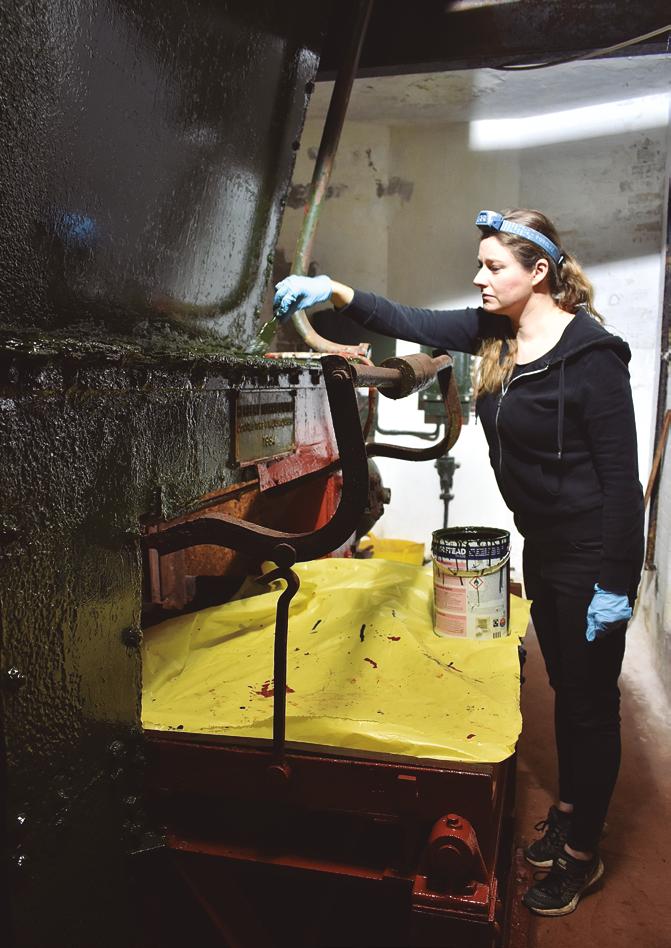
Restoration of Lord Airey’s
Restauración de Lord Airey’s
Author: Sarah Birch - OTWO
Photographer: Sarah Birch
With nearly 100 military batteries, plus barracks, bastions, defensive walls and kilometres of tunnels, Gibraltar is one of the most remarkable and heavily fortified cities in the world. Its military history and structures, which span over a millennium, are embedded into almost every part of the Rock. Many of these sites have been carefully maintained or restored over the years, preserved for both locals and tourists to visit and enjoy. However, there are many more that have unfortunately fallen into ruin. Thankfully, some individuals are dedicating their time and energy to help preserve Gibraltar’s unique history.
Pete Jackson, a Trustee on the Board of the Gibraltar Heritage Trust and a member of the Fortress of Gibraltar Group, along with several Heritage Trust volunteers, have recently been working tirelessly to restore Lord Airey’s Battery, found just north of O’Hara’s Battery on the Rocks highest point.
Named after the Governor of Gibraltar, General Sir Richard Airey, the artillery battery is home to one of three remaining 9.2-inch Mark X BL guns, last fired in the 1970s during a training exercise. The other two guns are at Breakneck Battery and next door at
Con casi 100 baterías militares, además de cuarteles, bastiones, murallas defensivas y kilómetros de túneles, Gibraltar es una de las ciudades más notables y fuertemente fortificadas del mundo. Su historia y estructuras militares, que abarcan más de un milenio, están incrustadas en casi todas las partes del Peñón. Muchos de estos lugares han sido cuidadosamente mantenidos o restaurados a lo largo de los años, conservados para que tanto los lugareños como los turistas los visiten y disfruten. Sin embargo, hay muchos más que lamentablemente han caído en la ruina. Afortunadamente, algunas personas dedican su tiempo y energía a ayudar a preservar la historia única de Gibraltar.
Pete Jackson, miembro del Consejo de Administración del Gibraltar Heritage Trust y del Grupo Fortaleza de Gibraltar, junto con varios voluntarios del Heritage Trust, han trabajado recientemente de forma incansable para restaurar la Batería de Lord Airey, que se encuentra justo al norte de la Batería de O’Hara, en el punto más alto del Peñón. Esta batería de artillería, que lleva el nombre del gobernador de Gibraltar, el general Sir Richard
OTWO 23 / JUNE 2021 39 38 OTWO 23 / JUNE 2021
O’Hara’s Battery. Initial construction of Lord Airey’s Battery was completed in 1891 with modifications made to its interior and exterior during World War I and World War II.
Previously in the Royal Artillery and the Royal Gibraltar Regiment, Pete has been working in Gibraltar for the last thirty years and has assisted with other restoration projects and has led many tours of Gibraltar’s sites, such as Lower St Michaels Cave and the WWII Tunnels. Over the last six months, together with volunteers, he has been restoring the subterranean rooms of the battery after discovering just how dilapidated it had become when he went to investigate an apparent act of vandalism.
During a weekend in October last year, just as Pete had reached the top of the Med Steps, he noticed something unusual as he approached the battery. On closer inspection, he realised someone had broken through the door leading into the interior, and for some inexplicable reason, opened the oil drain tap to the variable speed gear causing the oil to spill out across the Pump Room floor. After quickly turning it back off, two bags of sawdust were brought up to the battery and used to soak up and then remove the mess.
As part of the restoration and to address other minor leaks in the system, Pete has begun removing the remaining oil from the engine. He has already drained 168 litres but moving 25-litre drums out of the engine room and down the hill without much assistance is a slow and arduous job.
Several improvements and refurbishments of the gun have taken place over the years (in 2009, soldiers refurbished the guns at Lord Airey’s and O’Hara’s Battery), the rest of the battery had been neglected and allowed to fall into total disrepair over the last five decades. But thanks to the hours of hard work put in by Pete and a few dedicated volunteers, Lord Airey’s Battery is slowly but surely being restored to its former glory. However, there are structural issues to the battery that requires more funding to ensure that all their hard work does not go in vain.
The first chamber is the workshop and store for the restoration project. Following decades of neglect, the walls were saturated with mould and the workbench drawers filled with rat nesting materials.
The room is now clean, the mould removed, and
Airey, alberga uno de los tres cañones Mark X BL de 9,2 pulgadas que quedan, disparados por última vez en la década de 1970 durante un ejercicio de entrenamiento. Los otros dos cañones están en la Batería Breakneck y al lado en la Batería O’Hara. La construcción inicial de la Batería de Lord Airey se completó en 1891 con modificaciones realizadas en su interior y exterior durante la Primera y la Segunda Guerra Mundial.
Pete, que anteriormente formó parte de la Artillería Real y del Regimiento Real de Gibraltar, ha trabajado en Gibraltar durante los últimos treinta años y ha colaborado en otros proyectos de restauración y ha dirigido muchas visitas a lugares de Gibraltar, como la Cueva Baja de San Miguel y los Túneles de la Segunda Guerra Mundial. Durante los últimos seis meses, junto con voluntarios, ha estado restaurando las salas subterráneas de la batería tras descubrir lo deteriorada que estaba cuando fue a investigar un aparente acto de vandalismo.
Durante un fin de semana de octubre del año pasado, justo cuando Pete había llegado a la cima de la Escalera Med, notó algo inusual al acercarse a la batería. Al inspeccionarla más de cerca, se dio cuenta de que alguien había forzado la puerta que conduce al interior y, por alguna razón inexplicable, había abierto el grifo de drenaje de aceite del engranaje de velocidad variable, haciendo que el aceite se derramara por el suelo de la sala de bombas. Después de cerrarlo rápidamente, se llevaron dos bolsas de serrín a la batería y se utilizaron para absorber y eliminar la suciedad.
Como parte de la restauración y para solucionar otras fugas menores en el sistema, Pete ha empezado a extraer el aceite restante del motor. Ya ha vaciado 168 litros, pero sacar los bidones de 25 litros de la sala de máquinas y bajarlos sin mucha ayuda es un trabajo lento y arduo.
A lo largo de los años se han llevado a cabo varias mejoras y renovaciones del cañón (en 2009, los soldados renovaron los cañones de la batería de Lord Airey y O’Hara), pero el resto de la batería se había descuidado y se había dejado caer en un total deterioro durante las últimas cinco décadas. Sin embargo, gracias a las horas de trabajo de Pete y de algunos voluntarios, la Batería de Lord Airey está recuperando su antiguo esplendor de forma lenta pero
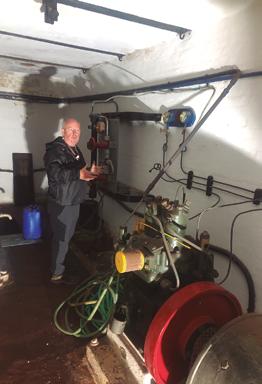
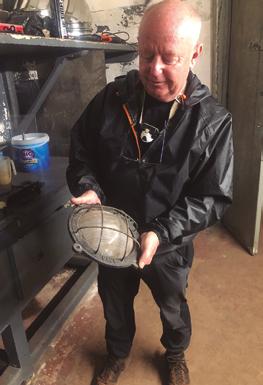
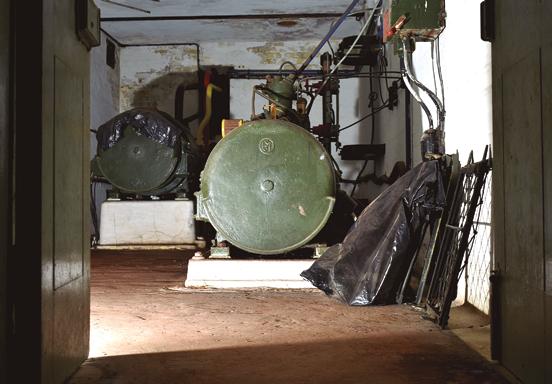
OTWO 23 / JUNE 2021 41 40 OTWO 23 / JUNE 2021
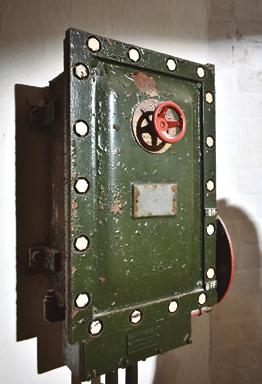
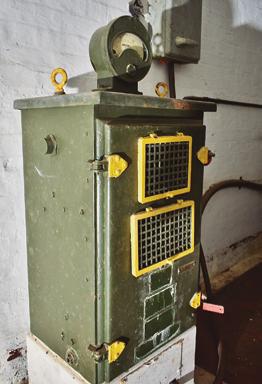
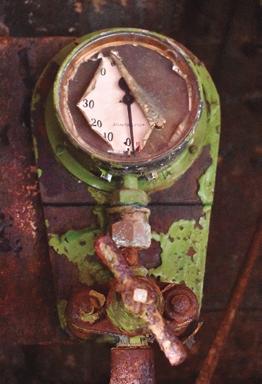
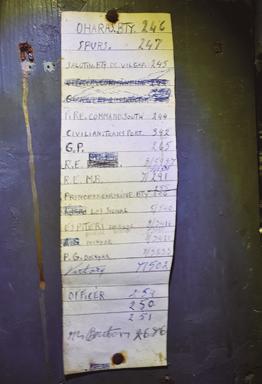
the walls prepared for painting. Items found in the room are now being restored, such as handmade handles, hooks and lamp covers. Light switches and other original features salvaged from derelict gun battery’s will be used to replace missing parts.
The centrifuge, which purifies oil and returns it to the system, has been completely restored. The system, which dates to World War II, looks brand new, thanks to the help of Carl Alecio, who took time during his lunch breaks to restore it piece by piece.
The signals board is also being rebuilt, used originally to communicate with O’Hara’s Battery, Fire Control South, Breakneck Battery and other observation posts and positions.
In the Pump Room the variable speed gear used to regulate and adjust motor speed is under restoration. The interior magazine windows used to safely illuminate rooms with lanterns in the days before electricity are also being restored.
The Shifting Lobby and the Cartridge Store, both of which pre-date electricity, are being cleaned and repainted. The Shell Store pulley system used to transfer heavy shells to the magazine was cleaned up and is now functioning again. The Ammunition Lift manufactured by Herbert Morris Ltd in 1934, found damaged as a result of decades of water damage and rust, has been stripped of ruined metal, rust treated and repainted.
Lastly, through a dark tunnel, the battery office has also been cleaned out. Inside, the remnants of the old telephone system are still hanging on the wall, as well as an amusing telephone list written by an on-duty clerk in ‘llanito’.
Recently, soldiers from the Household Cavalry D Squadron also aided in some refurbishment tasks such as cleaning up the external areas and preparing internal walls for redecoration.
But poor circulation, leaks and issues with the drainage above means that all the work Pete and the volunteers have put in to cleaning the rooms of mould, repainting, and repairing mechanisms could all be for nothing. A small amount of funding has gratefully been received from the Heritage Ministry Board, The Gibraltar Heritage Trust and the MoD WWII Tunnel Guides has helped with initial restorations, but much more is needed to preserve and restore the site.
segura. Sin embargo, hay problemas estructurales en la batería que requieren más financiación para garantizar que todo su duro trabajo no sea en vano.
La primera cámara es el taller y almacén del proyecto de restauración. Tras décadas de abandono, las paredes estaban saturadas de moho y los cajones del banco de trabajo llenos de materiales para anidar ratas.
Ahora la sala está limpia, se ha eliminado el moho y se han preparado las paredes para pintarlas. Se están restaurando los objetos encontrados en la habitación, como los tiradores, los ganchos y las tapas de las lámparas hechas a mano. Se utilizarán interruptores de luz y otros elementos originales rescatados de baterías de armas abandonadas para sustituir las piezas que faltan.
La centrifugadora, que purifica el aceite y lo devuelve al sistema, ha sido completamente restaurada. El sistema, que data de la Segunda Guerra Mundial, parece totalmente nuevo gracias a la ayuda de Carl Alecio, que dedicó tiempo durante sus descansos para restaurarlo pieza a pieza.
También se está reconstruyendo el tablero de señales, utilizado originalmente para comunicarse con la Batería de O’Hara, el Control de Fuego Sur, la Batería de Rompimiento y otros puestos y posiciones de observación.
En la Sala de Bombas se está restaurando el engranaje de velocidad variable utilizado para regular y ajustar la velocidad del motor. También se están restaurando las ventanas interiores de los polvorines que se utilizaban para iluminar con seguridad las habitaciones con linternas en los días anteriores a la electricidad.
El Vestíbulo de Cambios y el Almacén de Cartuchos, ambos anteriores a la electricidad, están siendo limpiados y repintados. El sistema de poleas del Almacén de Cartuchos utilizado para transferir los cartuchos pesados al almacén se ha limpiado y vuelve a funcionar. El elevador de municiones fabricado por Herbert Morris Ltd en 1934, que se encontró dañado como resultado de décadas de daños por agua y óxido, ha sido despojado del metal arruinado, tratado contra el óxido y repintado.
Por último, a través de un oscuro túnel, también se ha limpiado la oficina de la batería. En el interior, los restos del antiguo sistema telefónico aún cuelgan de
OTWO 23 / JUNE 2021 43 42 OTWO 23 / JUNE 2021
Several historical locations across Gibraltar have seen much-needed investment and TLC over recent years, such as the recent clean-up and future planned restoration works of the magnificent Northern Defences. However, just like Lord Airey’s Battery, there are many more sites that have succumbed to years of neglect and vandalism. The saddest part is that there are very few places around the world where sites such as these have been allowed to fall into such a state of disrepair.
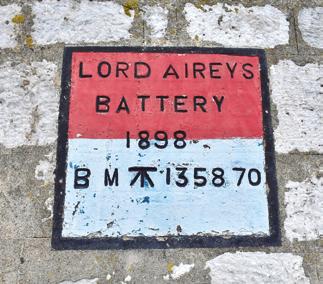
Our unique location and topography mean that our historical military sites are equally remarkable, some of which have stood here over centuries, through multiple occupations and significant periods in history. More investment and resources are needed to preserve our one-of-a-kind landmarks for future generations and following more than a year in which tourism everywhere has taken a complete nosedive, investing in our multitude of historical sites will undoubtedly attract old and new visitors alike. Pete would like to see the battery restored to a level that it may be opened to the public for pre-arranged visits. Thanks to Pete, the volunteers and the Gibraltar Heritage Trust, the project is well on its way, but with some more assistance and funding, the restoration could be completed in 18 months. Pete and the Gibraltar Heritage Trust are always looking for more volunteers to help. If you would like to get involved, please contact the Heritage Trust here.
la pared, así como una divertida lista de teléfonos escrita por un empleado de guardia en “llanito”.
Recientemente, los soldados del Escuadrón D de Caballería de la Armada también ayudaron en algunas tareas de acondicionamiento, como la limpieza de las zonas exteriores y la preparación de las paredes interiores para su redecoración.
Pero la mala circulación, las filtraciones y los problemas con el drenaje de arriba significan que todo el trabajo que Pete y los voluntarios han realizado para limpiar las habitaciones de moho, repintar y reparar los mecanismos podría ser en vano. Se ha recibido una pequeña cantidad de fondos de la Junta del Ministerio de Patrimonio, el Gibraltar Heritage Trust y las Guías del Túnel de la Segunda Guerra Mundial del Ministerio de Defensa, que han ayudado a las restauraciones iniciales, pero se necesita mucho más para preservar y restaurar el lugar.
En los últimos años, varios lugares históricos de Gibraltar han recibido una inversión y un cuidado muy necesarios, como la reciente limpieza y los futuros trabajos de restauración previstos para las magníficas Defensas del Norte. Sin embargo, al igual que la Batería de Lord Airey, hay muchos más lugares que han sucumbido a años de abandono y vandalismo. Lo más triste es que hay muy pocos lugares en el mundo en los que se haya permitido que sitios como estos caigan en tal estado de deterioro.
Nuestra ubicación y topografía únicas hacen que nuestros emplazamientos militares históricos sean igualmente notables, algunos de los cuales han permanecido aquí durante siglos, a través de múltiples ocupaciones y períodos significativos de la historia. Tras más de un año en el que el turismo ha caído en picado en todas partes, invertir en nuestra multitud de lugares históricos atraerá sin duda a antiguos y nuevos visitantes.
A Pete le gustaría ver la batería restaurada hasta un nivel en el que pudiera abrirse al público para visitas concertadas. Gracias a Pete, los voluntarios y el Gibraltar Heritage Trust, el proyecto está bien encaminado, pero con algo más de ayuda y financiación, la restauración podría estar terminada en 18 meses. Pete y el Gibraltar Heritage Trust siempre están buscando más voluntarios para ayudar. Si desea participar, póngase en contacto con el Heritage Trust aquí.
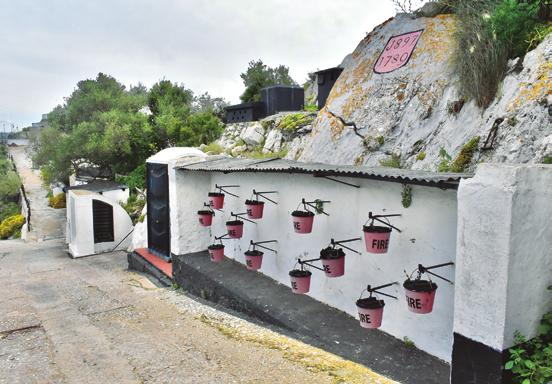
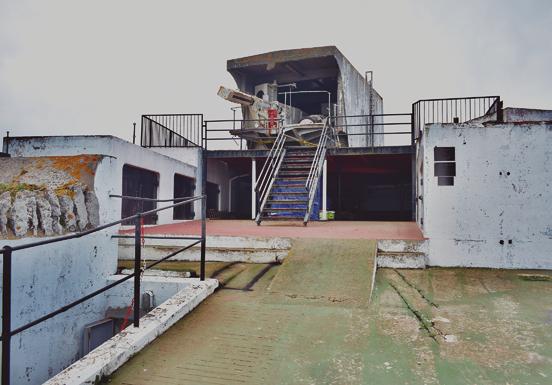
OTWO 23 / JUNE 2021 45 44 OTWO 23 / JUNE 2021

“Several historical locations across Gibraltar have seen much-needed investment and TLC over recent years, such as the recent clean-up and future planned restoration works of the magnificent Northern Defences.”
«En los últimos años, varios lugares históricos de Gibraltar han recibido una inversión y un cuidado muy necesarios, como la reciente limpieza y los futuros trabajos de restauración previstos para las magníficas Defensas del Norte.»
OTWO 23 / JUNE 2021 47 46 OTWO 23 / JUNE 2021
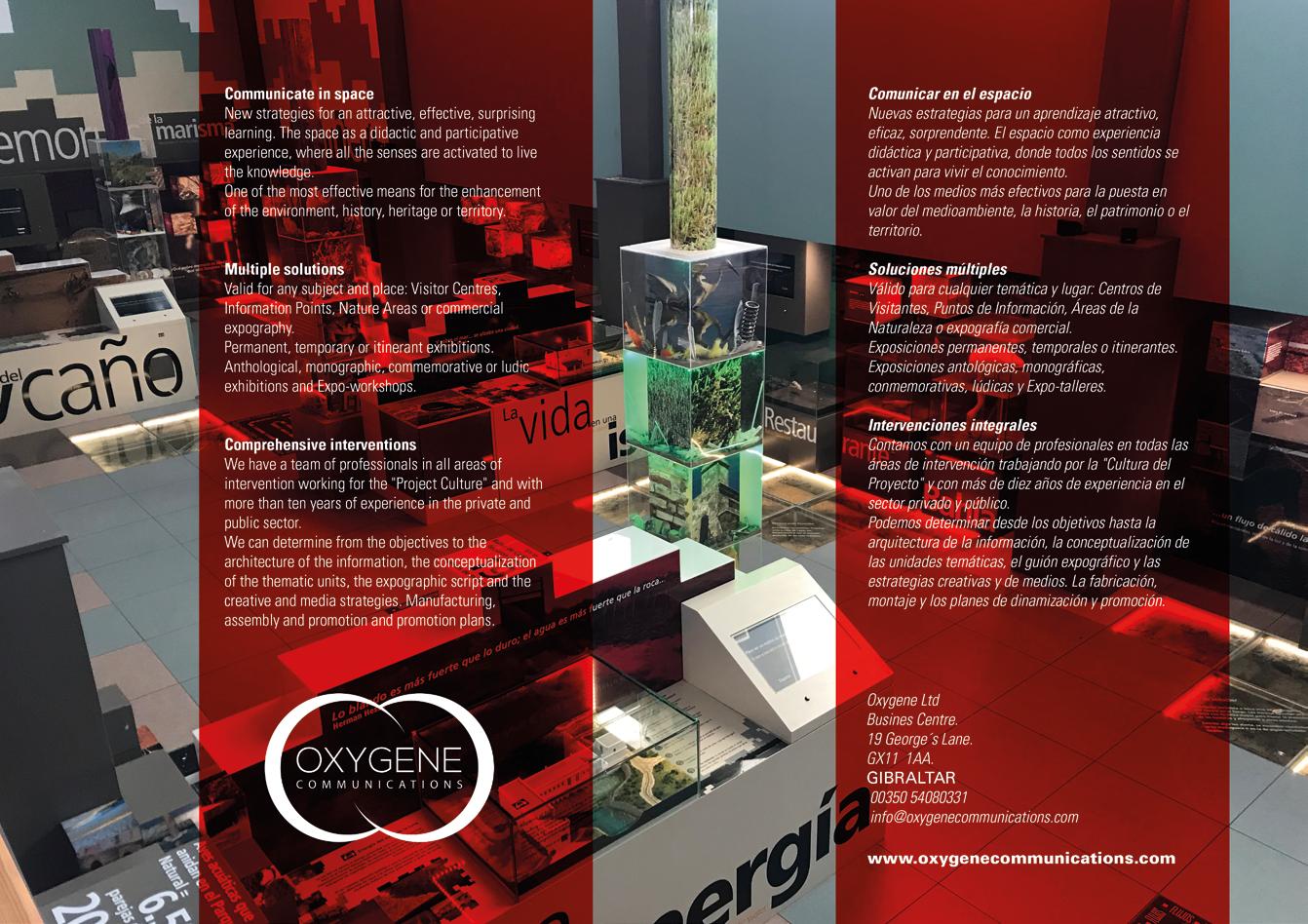
Boats on the walls
The rupestre cave of “La Laja Alta”, and the unique vessels represented on its walls, Jimena de la Frontera (Cádiz)
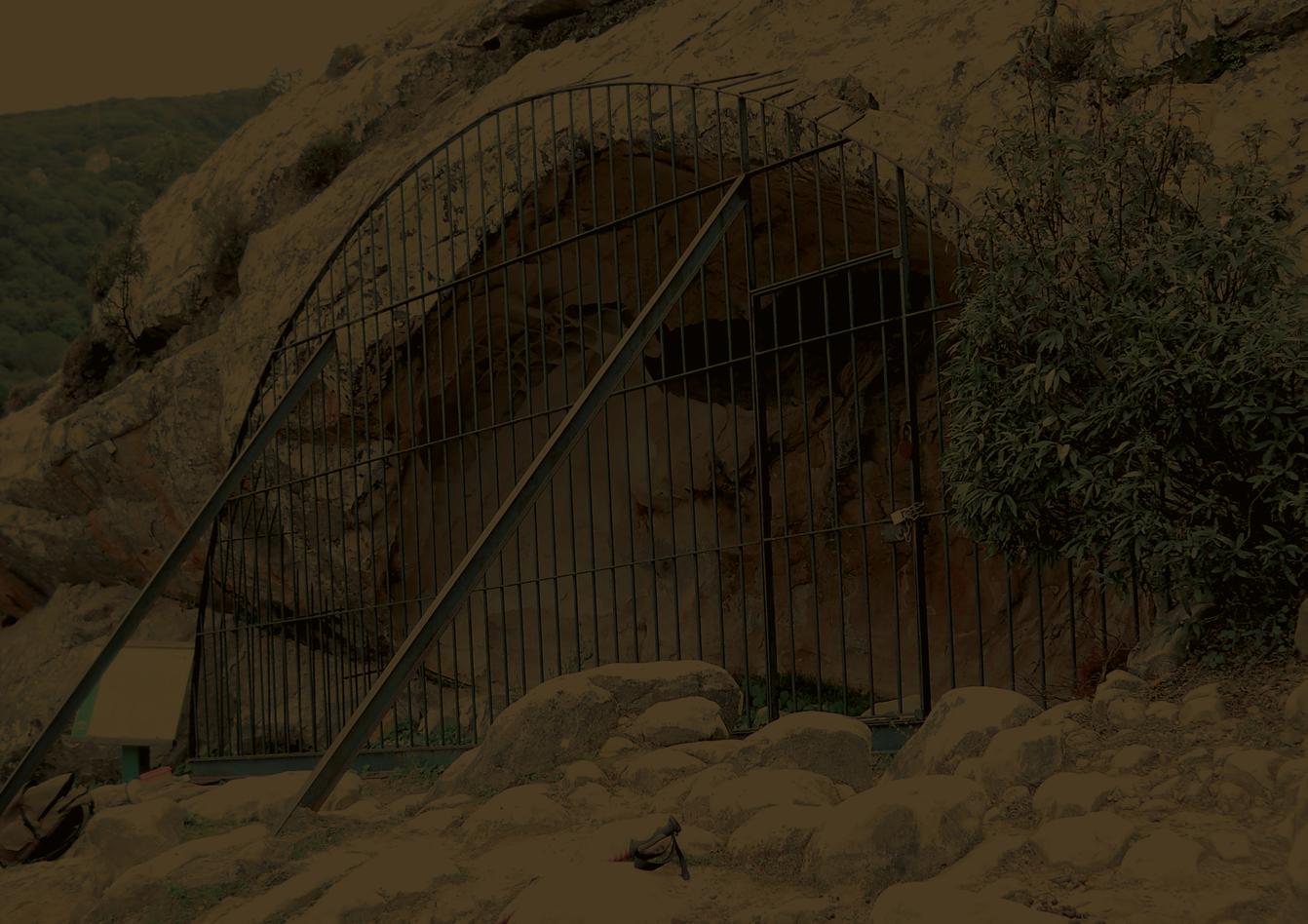
La cueva rupestre de “La Laja Alta”, y las singulares embarcaciones representadas en sus paredes, Jimena de la Frontera (Cádiz).
Hugo A. Mira Perales
OTWO 23 / JUNE 2021 51 50 OTWO 23 / JUNE 2021
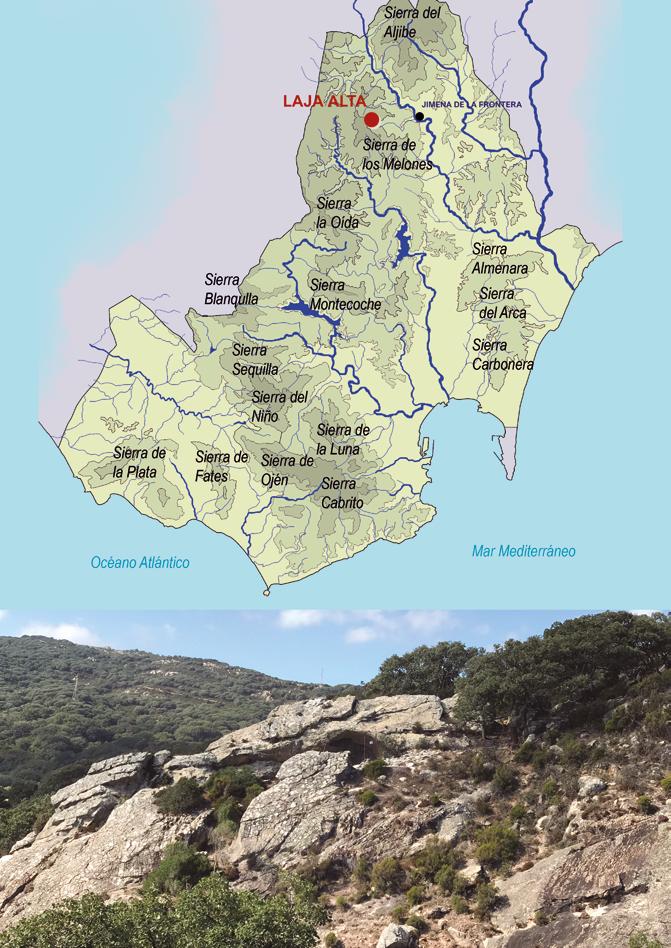
This beautiful enclave is located in the southwestern region of the Baetic System in the heart of Los Alcornocales Natural Park and within the municipality of Jimena de la Frontera (Cadiz). It is situated at the Gamero gorge, near the Hozgarganta river, at an altitude of 380 metres above sea level. Although the coastline is not visible from the rock shelter, it can be seen from the nearby rocky ridges. If we draw a straight line from the enclave to the coast, the distance is approximately 25 kilometres. This rocky shelter, where humans recreated depictions of the boats that sailed through the Strait of Gibraltar, has the same geological characteristics as most of the rock enclaves in the province of Cádiz. The structure is made up of very pure siliceous sandstones (>90% quartz), and with very rounded grains. Appearing in stratified banks with alternate clayey levels, these formations form an important part of the mountainous landscape of the province of Cádiz such as in: The Sierras del Aljibe, Bujéo, Retín, La Plata, Ojén, Blanquilla and others. These rock formations contain few fossils and were formed during the Aquitaine period (Gutiérrez-Mas, J. M. Gracia Prieto, J. Luján Martínez, M. Sánchez Bellón, Á. Geology of Campo de Gibraltar 16). (Figure 1).
This cavity was formed by wind erosion and at present easterly winds continue to affect the sandstone walls, mainly on the left side of the shelter. At first glance, this side of the shelter is most affected, with its supporting foundation losing the top layer of sandstone from the continuous wind. It is assumed that this part of the cave could also have been covered with painted motifs, although at present they have disappeared. (Figure 2).
Historically speaking, H. Breuil and M.C. Burkitt in 1929, visited and located several post-Palaeolithic enclaves with schematic art in the vicinity of this rock shelter. They later published their finding in their book “Rock paintings of southern Andalusia: a description of a Neolithic and copper age art group”, without actually locating the rock shelter in Laja Alta. One of the most representative prehistoric art enclaves in the municipality of Jimena de la Frontera is the Chinchilla Cave Complex, due to its hunting scenes. Additionally, the shelter of Risco de Tajo Gordo also stands out for its claviform and dot art motifs forming parallel lines. We cannot fail either to
Este bonito enclave se ubica en la región suroccidental de la Cordillera Bética, en pleno Parque Natural «Los Alcornocales», dentro del término municipal de Jimena de la Frontera (Cádiz), situado en la garganta del Gamero, próximo al rio Hozgarganta, a una altitud de 380 metros sobre el nivel del mar. Aunque desde el abrigo no se divisa la línea de costa, si se puede ver desde las crestas rocosas próximas. Si trazamos una línea recta, encontramos la costa a una distancia de aproximadamente 25 kilómetros. Este abrigo rocoso, donde el hombre recreo las manifestaciones rupestres de las embarcaciones que surcaban por el estrecho de Gibraltar, es de las mismas características geológicas, que la mayoría de los enclaves rupestres de la provincia de Cádiz. Con una estructura constituida por areniscas silíceas muy puras (>90% de cuarzo), y con los granos muy redondeados. Apareciendo estratificadas en bancos que alternan niveles arcillosos, formando importantes relieves en las sierras de la provincia de Cádiz como: las Sierras del Aljibe, Bujéo, Retín, la Plata, Ojén, Blanquilla y otras. Estas formaciones rocosas contienen pocos fósiles, su formación está adscrita al periodo Aquitaniense (Gutiérrez-Mas, J. M. Gracia Prieto, J. Luján Martínez, M. Sánchez Bellón, Á. Geología del Campo de Gibraltar 16). (Figura 1).
Esta cavidad se forma por erosión eólica, en la actualidad el viento de levante sigue afectado a la arenisca de las paredes, principalmente a la parte izquierda del abrigo, zona que a simple vista se observa más castigada y donde el soporte está perdiendo la primera capa de arenisca, por el continuo golpe del viento. Como es de suponer, esta parte posiblemente también estaría cubierta de motivos pintados, aunque en la actualidad han desaparecido. (Figura 2).
Históricamente hablando, en las proximidades de esta cavidad, H. Breuil y M.C. Burkitt en 1929, visitaron y localizaron varios enclaves postpaleolíticos con arte esquemático, que más tarde publicaron en su libro «Rock paintings of southern Andalusia: a description of a neolithic and copper age art group», sin llegar a localizar en de la Laja Alta. Uno de los más representativos en el término municipal de Jimena de la Frontera, es el Conjunto de Chinchilla, por sus escenas de caza. Además del abrigo denominado Risco de Tajo Gordo que destaca por sus motivos claviformes y puntiformes, formando líneas paralelas, y no pode-
OTWO 23 / JUNE 2021 53 52 OTWO 23 / JUNE 2021
Figure 1. Location of the Cueva de la Laja (Heritage Report in the Management Plan of the Territory of Andalucía).
Figura 1. Ubicación Cueva de la Laja Alta (Reseñas patrimoniales en el plan de ordenación del Territorio de Andalucía)
Figure 2. View of the rock shelter of la Laja Alta, Jimena de la Frontera.
Figura 2. Vista del abrigo de la Laja Alta, Jimena de la Frontera.
mention another incredibly beautiful shelter called the Chorreón del Salado, with its anthropomorphic groupings in anchor type forms (Breuil, H. Burkitt, MC 1929). The Laja Alta cavity was discovered in 1968 by Salvador Corbacho Rey but did not appear in a published work until 1978, which is when the enclave began to attract attention due to its unique nautical motifs. In 1980, the Topper couple published their book “Rock art in the province of Cádiz”, which included tracings done by Uwe and Uta of the boat symbols painted on the caves’ walls by our ancestors. In these first publications, all the boat symbols were ascribed to the first millennium B.C, due to the Phoenician colonisation of the Iberian Mediterranean area (Corzo and Giles 1978) with some even placing them chronologically to the Late Bronze Age (Mas Cornellá 1993). Several authors separate the nautical motifs from the schematic figures stating that they are not related, but rather that the caves’ wall was reused during different time periods (Pilar Acosta 1994). According to the latest regarded dates, the paintings could confirm the existence of vessels sailing through the Strait of Gibraltar as early as the 4th-3rd millennium B.C, similar to those sailing through the Central Mediterranean at around the same time. (Morgado, A. García-Alfonso, E. García del Moral, L. Benavides, JA. Rodríguez-Tovar, FJ. Equivel, JA. Prehistoric sailing vessels and rock representations. New data from the Laja Alta shelter (Jimena de la Frontera, Cádiz). 2018).
On an important note, initial works to document the enclave, which were carried out in 1989, located a total of 34 motifs. These were grouped according to their typology: anthropomorphs, zoomorphs, idols, stelliforms, lines, petroglyphs, boats and some lines difficult to identify. Years later, and thanks to technological advances that have occurred in the last decade in all things related to image processing software, digital cameras etc, the number of new cave painting discoveries have increased, and the number of symbols found in already known enclaves has also increased. In the enclave of Laja Alta specifically, the latest works carried out there has brought to light 25 more motifs, which brings the total number of symbols found throughout the entire enclave to 59. All of these new motifs were discovered and documented thanks to the extraordinary work of Jon Harman,
mos dejar de mencionar otro abrigo de gran belleza, el denominado Chorreón del Salado, con sus grafias de agrupaciones de antropomorfos del tipo ancoriforme (Breuil, H. Burkitt, M.C. 1929). La cavidad de la Laja Alta no fue descubierta hasta 1968 por Salvador Corbacho Rey, y no apareció publicada hasta 1978, siendo entonces cuando llamo la atención por la singularidad de sus motivos náuticos. Siendo en 1980 cuando el matrimonio Topper público su libro «Arte rupestre en la provincia de Cádiz», donde se plasmó, los calcos que Uwe y Uta realizaron de las grafias de embarcaciones, que nuestros antepasados representaron en sus paredes. En estas primeras publicaciones todos los motivos de navíos fueron adscritos al primer milenio a.C. por la vinculación, con la colonización fenicia en el área mediterránea Ibérica (Corzo y Giles 1978), incluso algunos situándolos cronológicamente en un Bronce final (Mas Cornellá 1993). Varios autores separan los motivos náuticos de las figuras esquemáticas, afirmando la no relación entre ellos, si no que el abrigo se reutilizo en épocas diferentes (Pilar Acosta 1994). Según las últimas dataciones realizadas, podrían confirmar la existencia de embarcaciones a vela, ya surcando el Estrecho de Gibraltar, en el IV-III milenio a.C., similares a las embarcaciones que ya surcaban el Mediterráneo Central por las mismas fechas. (Morgado, A. García-Alfonso, E. García del Moral, L. Benavides, J.A. Rodríguez-Tovar, F.J. Equivel, J.A. Embarcaciones prehistóricas y representaciones rupestres. Nuevos datos del abrigo de Laja Alta (Jimena de la Frontera, Cádiz). 2018).
Como dato importante, los primero trabajos sobre documentación del enclave, que se realizaron en 1989, localizaron un total de 34 motivos, los cuales fueron agrupados, según su tipología en: antropomorfos, zoomorfos, ídolos, esteliformes, trazos, petroglifoides, embarcaciones y algunos trazos de difícil identificación. Años después y gracias al avance tecnológico que se ha producido en esta última década, con todo lo relacionado a los software de tratamiento de imágenes, cámaras digitales, etc. Se ha incrementado el número de nuevos hallazgos de enclaves con pinturas rupestres, y aumentado el número de grafias en los enclaves ya conocidos. En el caso concreto de la Laja Alta, los últimos trabajos de documentación realizado, han sacado a la luz 25 motivos más, sumando hasta la fecha de hoy, un total de 59 grafias en todo el enclave. Todos estos nuevos motivos se han podido descubrir y
who in 2005 launched the free software “Dstretch” for image analysis in plugin form, which is able to highlight faint tones that are invisible to the naked eye (https://www.dstretch.com/). The appearance of new motifs in this cavity can be extrapolated to many of the cave enclaves that are distributed throughout the Campo de Gibraltar region, which now require new research and documentation work to update the symbols represented on their walls. The pictorial motifs represented in this cavity are all post-Palaeolithic and of a schematic typology. To simplify, we can divide them into two groups based on their characteristics. The first group would be those framed in a “nautical or naval” category, which includes boats, a painted enclosure that mimics a port and even some fine lines that represent possible fishing nets which appear next to some of the boats. The second group is made up of a category that includes the rest of the schematic motifs, such as anthropomorphic, zoomorphic, masked idols, stelliforms, petroglyphs, lines, etc. In the following figure, you can see the distribution of the two groups painted on the walls of the cavity. (Figure 3. Prehistoric sailing vessels and rock representations. New data from the Laja Alta shelter (Jimena de la Frontera, Cádiz) A. Morgado; E. García-Alfonso; LF García del Mora; JA Benavides; FJ Rodríguez-Tovar; JA Esquivel).
documentar, debido al extraordinario trabajo de Jon Harman, que en el año 2005, lanzo el software libre «Dstretch», para el análisis de la imagen en forma de plugin, resaltando las tonalidades tenues que son invisibles a simple vista (https://www.dstretch.com/). Lo que ha pasado con la aparición de nuevos motivos en esta cavidad, es extrapolable a muchos de los enclaves rupestres que se reparten por la comarca del Campo de Gibraltar, siendo necesario un nuevo trabajo de documentación para actualizar las grafias representadas en sus paredes.
Los motivos pictóricos representados en esta cavidad, son todos postpaleolíticos, y de tipología esquemática, por simplificar podemos dividirlos en dos grupos por sus características. El primer grupo sería los enmarcados en una categoría “náutica o naval”, donde se incluyen las embarcaciones, el recinto que simula un puerto e incluso unos trazos finos que representan posibles redes, que aparecen trazadas junto a algunas de las embarcaciones. El segundo grupo estaría formado por una categoría donde se englobarían el resto de motivos esquemáticos, como los antropomorfos, zoomorfos, ídolos máscaras, esteliformes, petroglifoides, trazos, etc. En la siguiente figura se puede ver la distribución de los dos grupos pintados en la pared de la cavidad. (Figura 3. Embarcaciones prehistóricas y representaciones rupestres. Nuevos datos
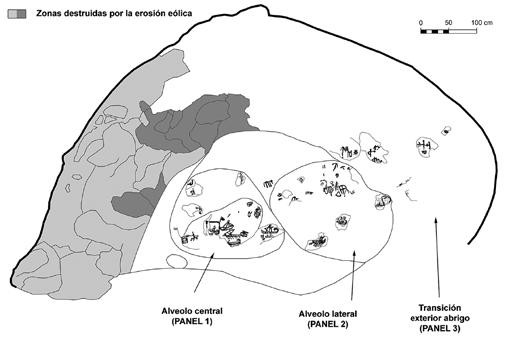
54 OTWO 23 / JUNE 2021
Figure 3. Schematic diagram of the motifs (Morgado et al., 2018).
Figura 3. Esquema grafico de la ubicación de los motivos (Morgado et al., 2018).
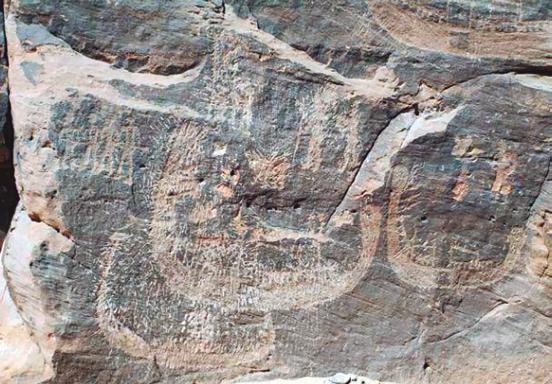
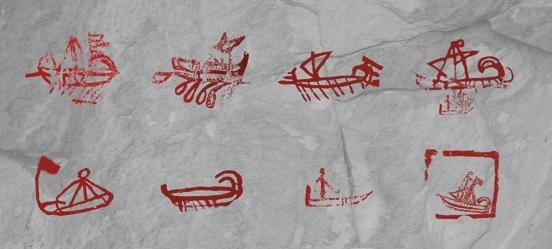
We shall continue by describing the first group of symbols, all of which are related to nautical or naval representations. All the symbols that represent boats or nautical-themed motifs were produced in the form of schematic drawings. The dimensions the creator or creators used to draw the vessels are not proportional to that of a scaled down drawing of a boat, which leads us to believe that it is possible that the creator or creators did not depict these motifs to scale because they had not had any direct contact with ships. It is noteworthy however, that the drawings do have some well-represented elements and some other parts of the drawings do not have enough detail. The latest study carried out on the cave’s symbols, published in the article (Complutum 29 (2) 2018: pp. 239-265), counted a total of eight vessels, six of which have sails and two do not. However, if we look closely at one of the vessels, it has another small boat at its side, and just between the larger vessel and the boat, there appears to be yet another small boat, which would make a total of nine, three of which without sails. The results obtained from this research, brought to light some of the ships details. Following the application of several image treatments, it is now possible to observe details of the hulls of some of the boats, including characteristics of the way they were built and primarily the materials used. The outlines of the drawings suggest the materials could be bundles of branches and vegetation tied together. Another unusual feature of these boat depictions are a raised bow and stern, with the latter much more elevated and arched, which reinforces the theory that these boats were built with very fibrous plant materials with their ends tied together. When we compare these depictions to other ships, we can easily recognise the similar characteristics they have to ceramic and petroglyphs depictions of boats in Nag-el-Hamdulab (Egypt) of the III millennium BC, in the eastern Mediterranean area. (Figure 4).
Another standout detail on four of the boats is that they are equipped with oars, which are perfectly represented on the side of the ships. In one of the depictions, the creator even highlights the oars paddles in great detail, giving the impression that these were large ships due to the number of oars painted to the side of each of them. In addition to
del abrigo de Laja Alta (Jimena de la Frontera, Cádiz) A. Morgado; E. García-Alfonso; L.F. García del Mora; J. A. Benavides; F.J. Rodríguez-Tovar; J. A. Esquivel). A continuación se va a describir el primer conjunto de grafias, donde se han agrupado todas las relacionadas con representaciones náuticas o navales. Todas las grafias que representan embarcaciones o motivos relacionados con la náutica, se realizaron mediante dibujos esquematizados. Si tenemos en cuenta las medidas, que el autor o autores, de las grafias utilizo para el trazado de las embarcaciones, no se obtiene una proporcionalidad con un dibujo escalado aproximado de una embarcación, lo que nos da a entender que el autor o autores de las mismas, no representaron a escala estos motivos, posiblemente porque no se tuvo un contacto directo con los navíos, aunque también es de destacar que los dibujos cuentan con algunos elementos bien representados, y en algunas de las partes que forman las nave, no se representaron con los suficientes detalles. En el último estudio realizado sobre las grafias de la cavidad y publicado en el artículo (Complutum 29(2) 2018: pp. 239-265), se han contabilizado un total de ocho embarcaciones, de las cuales seis son a vela y dos de ellas sin ningún tipo de velamen, aunque si observamos bien una de las embarcaciones, tiene al costado un pequeño bote, y justo entre el navío y el bote, parece que posiblemente haya otra pequeña embarcación, lo que sumaría al total nueve embarcaciones, siendo tres de ellas sin velas. Los resultados obtenidos a raíz de este trabajo de investigación, sacan a la luz algunos de los detalles que se pueden reconocer en los navíos, después de la aplicación de varios tratamientos de imágenes, se ha conseguido poder observar varios detalles del casco de alguna de las embarcaciones, donde se identifican las características con las que estos fueron construidos, principalmente los materiales con los que fueron realizados. Por el trazado se podría estar hablando de haces de tallos vegetales anudados entre sí. Otra particularidad que presentan estas embarcaciones, es tener levantado la proa y la popa, estando esta última mucho más levantada y más arqueada, Siendo esta una de las razones por la cual se refuerza la teoría de que estas embarcaciones fueron construidas con material vegetal y muy fibroso, donde sus extremos estaban atados. Si establecemos una similitud con otros navíos, podemos reconocer este tipo de nave
56 OTWO 23 / JUNE 2021 OTWO 23 / JUNE 2021 57
Figure 4. Petroglyphs of boats in Nag-el-Hamdulab (Egypt).
Figura 4. Petroglifos de embarcaciones en Nag-el-Hamdulab (Egipto).
Figure 5. Table displaying all of the vessels depicted in the cave.
Figura 5. Cuadro donde se representan todas las embarcaciones de la Cavidad.
being propelled by oars, on some of the ships are representations of masts and unfolded triangular shaped sails. Another of the nautical representations shows a square enclosure or a temporary port shelter which contains a flag and a boat. It is striking that the creator of this painting was able to observe the entirety of this port enclosure in detail and then later recreate the image on the walls of the cave (Figure 5). It should be noted that this type of rock art is extremely rare in the Iberian Peninsula, meaning that the cave complex of Laja Alta is a reference point for the study of this type of post-Paleolithic pictorial art due to its proximity to the coast and the sea. (Figures 6-7).
The second rock art grouping in this cave is comprised of typical and conventional motifs from the schematic post-Paleolithic era, which were painted within the cavities and shelters of the Campo de Gibraltar region by our ancestors. We begin by describing several of the more significant motifs, which unlike the rest of the motifs painted in a reddish tone, are painted using black pigment. These two black symbols are schematic, one represents an ocular motif formed by two concentric circles with a line across the top simulating eyebrows, as well as several other lines below (1), the second motif is an abstract figure formed by a straight line and a curved line as well as a cloud like form made up of tiny dots painted within and to the left of the two lines (2). A highlight of the red pigmented motifs is the ocular idol, shaped like a mask with two eyes easily observable (3), this motif is slightly more sophisticated than some of the other basic schematic motifs. There is much more detail in its execution, possibly placing it to time period prior to the other schematic motifs (Figure 8). The rest of the schematic representations found in this cavity are very varied, from various types of anthropomorphic symbols, some of which are painted alone, and others in groups of several individual motifs, such as anchor-type symbols, or swallow-like symbols, figures with arms akimbo, or the anthropomorphic figure with weapons in hand raised up on a pedestal (Figure 9). There are also several pectiforms, ramiforms, a solarforms, in addition to several other symbols that are difficult to interpret (Figure 10). As an especially important note, there are just a few representations of zoomorphic motifs, two of which are highly schematized and one that is
con iguales características en las cerámicas y algunos petroglifos en Nag-el-Hamdulab (Egipto) del III milenio a.C., en la zona del Mediterráneo oriental. (Figura 4).
Otro detalle bien marcado en cuatro de las embarcaciones, es que se dotaron con remos, viéndose perfectamente representado en el costado de los navíos, incluso en una de ellas, el autor remarco con gran detalle la pala del remo, dando la sensación de ser naves de grandes dimensiones, por la cantidad de remos que se pintaron en el costado de las mismas. Además de la propulsión por remo, se presenta en los navíos, el mástil y el velamen desplegado y con una forma triangular, en algunas de las embarcaciones. Otra de las representaciones náuticas, es un recinto cuadrado o puerto temporal de abrigo, con una bandera y una embarcación en su interior, llama la atención como el autor de esta pintura, pudo ver el conjunto del recinto con detalle, para después poder plasmarlo en la pared de la cavidad (Figura 5). Destacar que este tipo de representaciones rupestres son muy escazas en la península ibérica, siendo este enclave de la Laja Alta, un referente para el estudio de este tipo de manifestaciones pictóricas postpaleolíticas, con su entorno más cercano, en este caso la costa y el mar. (Figuras 6-7).
El segundo grupo de manifestaciones rupestre que forma esta cavidad, son los motivos más convencionales de cronología postpaleolítica esquemática, que nuestros antepasados representaron en las cavidades y abrigos de la comarca del Campo de Gibraltar. Empezamos describiendo varios de los motivos más significativos, por ser los realizados con pigmento de color negro, a diferencia con el resto de motivos de la cavidad que son todos realizados con pigmentos con tonos rojizos. Estas dos grafias en color negro son esquemáticas, representan, la primera uno motivo oculado, formado por dos círculos concéntricos y un trazo en la parte superior simulando la ceja, además de varios trazos en la parte inferior (1), el segundo motivo una figura abstracta, formada por un trazo recto y otro curvo, además de una nube de puntuaciones diminutas dentro de los dos trazos y situada en la parte izquierda (2). Destacar de los motivos realizados con pigmentos rojos, el ídolo oculado, con forma de mascara, donde se observan los dos ojos de la figura (3), este motivo tiene un grado de más sofisticación que algunos de los motivos básicos esquemáticos, denota más detalle en la ejecución del mismo, enmarcándolo posiblemente
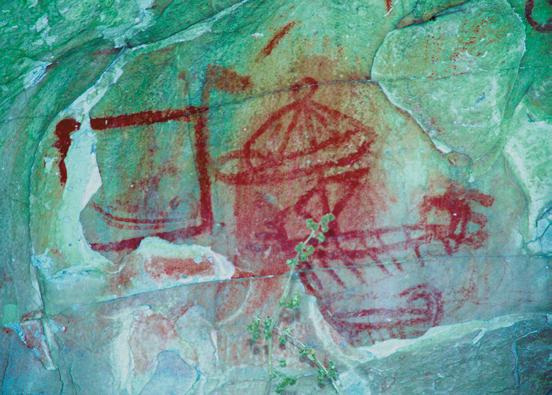

58 OTWO 23 / JUNE 2021 OTWO 23 / JUNE 2021 59
Figure 6. Panel with ships and port.
Figura 6. Panel con embarcaciones y recinto marítimo.
Figure 7. Vessel with sails extended. Figura 7. Embarcación con velamen extendido.
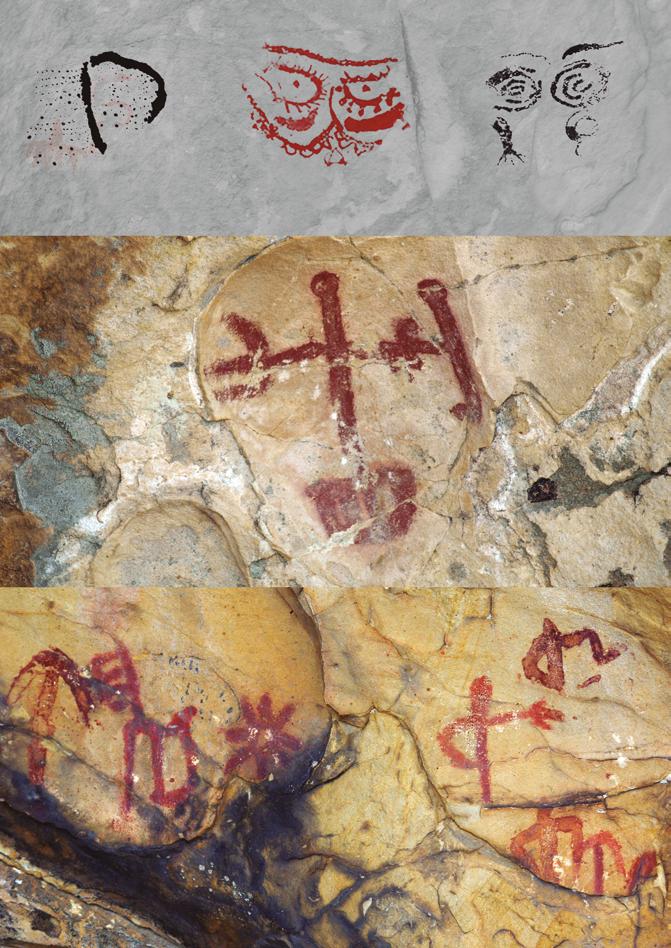
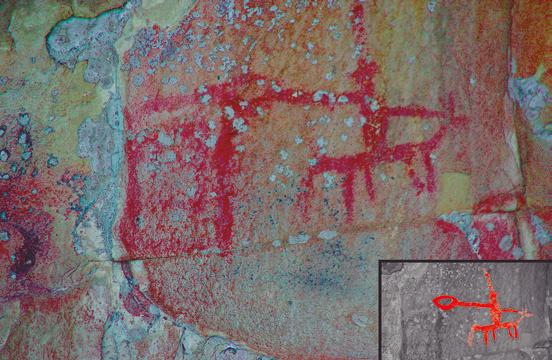
well defined. The latter shows a figure of an equid mounted by a rider who is possibly out shooting, just behind the figure there is an undefined quadrangular shape which the rider is possibly dragging (Figure 11). What is clear about the ensemble of symbols represented in this cavity is that the depictions of anthropomorphs and boats stand out. Laja Alta is the only cave shelter where such a large number of nautical representations are preserved. Fortunately, the cave is gated, this protects its paintings from acts of vandalism, which unfortunately has occurred in some of the unprotected enclaves in the region. Valuing and protecting these enclaves and promoting all our discovered cave art heritage would be a giant step towards creating awareness and respect for it.
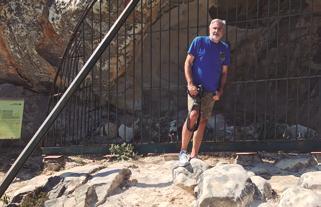
en un periodo anterior a los motivos esquemáticos (Figura 8). El resto de representaciones esquemáticas, que encontramos en esta cavidad, es de lo más variada, desde antropomorfos de varios tipos, algunos pintados en solitario, y otros formando agrupaciones de varios individuos, como los ancoriformes, o los de tipo golondrina, brazos en jarra, o el gran antropomorfo con armas en sus manos y subido en un pedestal (Figura 9). También se localizan varios pectiniformes, ramiformes, un soliforme, además de varios signos de difícil interpretación (Figura 10). Como dato muy importante, solo se representaron varias representaciones de motivos zoomorfos, dos muy esquematizados, y uno bien definido, que muestra a una figura de un équido montado por un jinete, posiblemente realizando alguna labor de tiro, pues se observa justo detrás de él, un motivo sin definir cuadrangular, que posiblemente sea un objeto que está arrastrando (Figura 11). Como se aprecia en el elenco de grafias representadas en esta cavidad, destacan las representaciones de antropomorfos y embarcaciones. Siendo la Laja Alta el único abrigo donde se han conservado este gran número de representaciones náuticas. Por suerte la cavidad cuenta con una reja, que protege sus pinturas de los típicos actos vandálicos, que suelen sufrir algunos enclaves no protegidos de la comarca. La puesta en valor de todos estos enclaves, dar a conocer todo nuestro patrimonio rupestre, es dar pasos agigantados para el conocimiento y el respeto del mismo.
OTWO 23 / JUNE 2021 61
Figure 8. Motifs in black pigment and eyes in red.
Figura 8. Motivos en pigmento negros y Oculado en rojo.
Figure 9. Anthropomorph with weapons in arm.
Figura 9. Antropomorfo con armas en las manos.
Figure 10. Anthropomorph and sun-form.
1 2 3
Figura 10. Antropomorfos y soliforme.
Figure 11. Motivo de Jinete y équido.
Figura 11. Motivo de Jinete y équido.
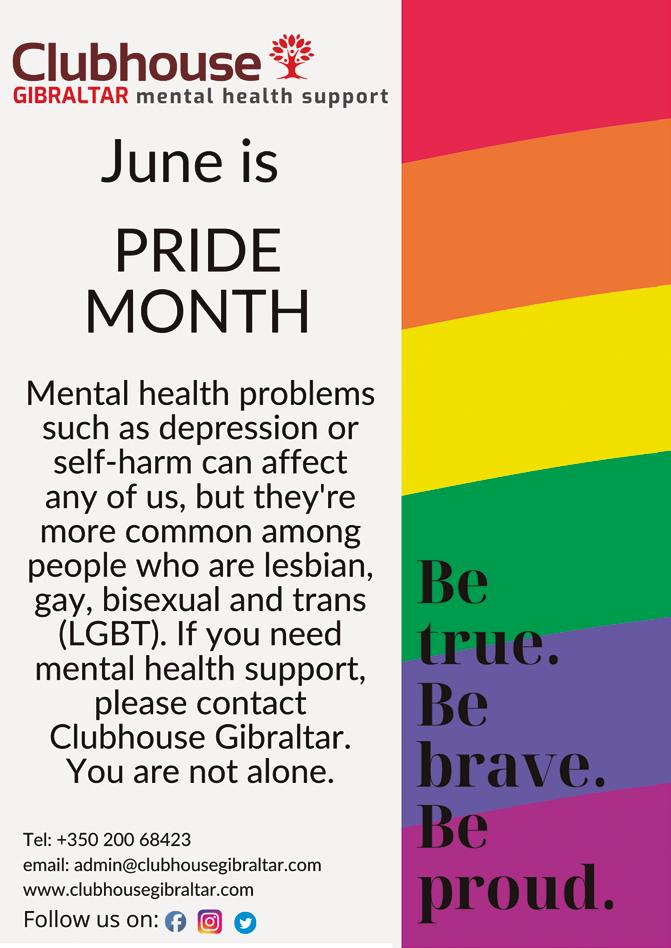

Promotion of aromatic crops for pollinators. Promoción de cultivos de aromáticas para polinizadores.
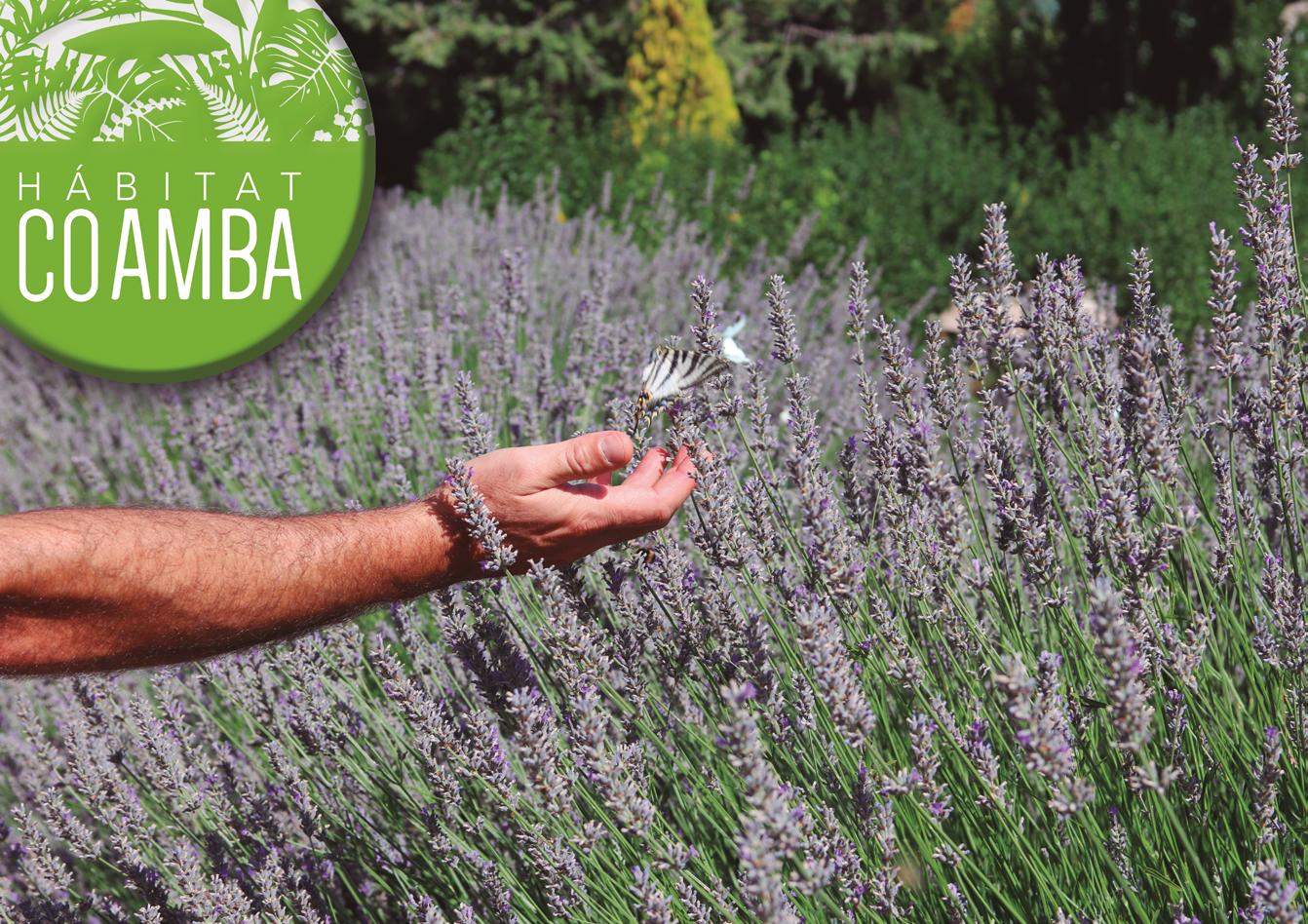
An innovative initiative for large-scale landscape restoration
AlVelAl works for the environmental, social and economic restoration of its territory.
AlVelAl trabaja por la restauración ambiental, social y económica de su territorio.
Text: AlVelAl
Photographs: Marina López, Communication Manager of the AlVelAl Association.
Faced with climate change and depopulation, the main challenges of the rural world, the restoration and maintenance of ecosystems, sustainable production, carbon dioxide sequestration and the creation of opportunities for present and future generations are tools that we have as a society.
The AlVelAl association has been working since 2016 on a holistic project for large-scale landscape restoration in its area of action; a territory that covers around 1,000,000 hectares between the regions of the Altiplano de Granada and Guadix, in the province of Granada; Los Vélez and Alto Almanzora, in Almería; and the Northwest of Murcia; in the Region of Murcia.
Under the philosophy of 4 Returns, 3 Zones, 20 Years; promoted by the Commonland Foundation, which promotes large-scale restoration projects around the world. AlVelAl’s vision is to build a prosperous territory with opportunities, for which it relies on organic and regenerative agriculture as a pillar, and carries out projects of landscape restoration and creation of business cases for the commercialization of healthy products with the added value of being regenerators of soil and landscape.
To achieve its goals, AlVelAl promotes regenerative agriculture through advice, training and financial support for the implementation of soil and landscape restoration techniques on farms. An agricultural management based on an integrated productive ecosystem that, in addition to having a restorative potential through the implementation and management of vegetation cover and water corrections; promotes the
Frente al cambio climático y el despoblamiento, principales retos del mundo rural, la restauración y mantenimiento de ecosistemas, la producción sostenible, la captación de dióxido de carbono y la creación de oportunidades para las presentes y futuras generaciones; son herramientas con las que contamos como sociedad.
La asociación AlVelAl trabaja desde 2016 en un proyecto holístico para la restauración del paisaje a gran escala de su área de actuación; un territorio que abarca alrededor de 1.000.000 de hectáreas entre las comarcas del Altiplano de Granada y Guadix, en la provincia de Granada; Los Vélez y Alto Almanzora, en Almería; y el Noroeste de Murcia; en la Región de Murcia.
Bajo la filosofía de los 4 Retornos, 3 Zonas, 20 Años; promovida por la Fundación Commonland, que promueve proyectos de restauración a gran escala en todo el mundo. La visión de AlVelAl es construir un territorio próspero y con oportunidades, para lo que se apoya en la agricultura ecológica y regenerativa como pilar, y lleva a cabo proyectos de restauración del paisaje y creación de casos de negocio para la comercialización de productos saludables con el valor añadido de ser regeneradores de suelo y paisaje.
Para conseguir sus fines, AlVelAl promueve la agricultura regenerativa a través del asesoramiento, la formación y el apoyo económico para la implementación de técnicas restauradoras de suelo y paisaje en las fincas agrícolas. Un manejo agrícola
65 64
OTWO 22 / MAY 2021 OTWO 22 / MAY 2021
incorporation of livestock and crop diversification, diversifying in parallel the economy of producers.
Promoting restoration in productive areas, but also in natural areas. AlVelAl aims at restoring and connecting public and private natural areas through a green corridor for biodiversity, which provides the backbone of the territory and the wide variety of ecosystems and landscapes it has; public forests, four Natural Parks (Sierra María - Los Vélez, Sierra de Castril, Sierra de Baza and Sierra Nevada), farms with natural areas and 330,000 hectares of Red Natura 2000.
In this regard, since its inception and up to the present, AlVelAl has restored an area of 137 hectares, planted 140,000 trees and shrubs, sown 204,000 seeds, developed 60 kilometers of hedges and built 109 rainwater retention ponds.
Another noteworthy aspect of this association is the support for entrepreneurship and the creation of business cases 4 Retornos for the commercialization of sustainable products with the added value of being from organic agriculture and regenerative soil and landscape. Short marketing channels that increase the income of farmers who are committed to sustainable production that respects their environment.
For the development of all this restorative work, the AlVelAl association has more than 300 members, farmers, ranchers, entrepreneurs, researchers, among other profiles. And a multidisciplinary team that works for the good development of this ambitious project. Among the wide human capital that this association has, we find two environmentalists, who belong to the College of Environmentalists of Andalusia. Elvira Marín Irigaray, coordinator of the large-scale restoration project of the AlVelAl Association since 2016; and Belén Sánchez, partner of AlVelAl who has been the coordinator of one of the projects carried out by this association, AlVelAl 8000: Sculptures with life.
Art, nature and society united through restoration
AlVelAl 8000: Sculptures with life is an innovative project of landscape regeneration, a business case based on the enhancement of local resources through reforestation imitating on a large scale the figure of the Indalo, present in the Cave of Los Letreros, declared World Heritage of Humanity by UNESCO.
basado en un ecosistema productivo integrado que, además de tener un potencial restaurativo a través de la implementación y gestión de cubierta vegetal y correcciones hídricas; promueve la incorporación del ganado y la diversificación de cultivos, diversificando de manera paralela la economía de los productores.
Fomento de la restauración en zonas productivas, pero también en áreas naturales. AlVelAl pretende la restauración y conexión de zonas naturales públicas y privadas a través de un corredor verde para la biodiversidad que vertebre el territorio y la amplia variedad ecosistemas y paisajes con los que cuenta; monte público, cuatro Parques Naturales (Sierra María – Los Vélez, Sierra de Castril, Sierra de Baza y Sierra Nevada), fincas con zona natural y 330.000 hectáreas de Red Natura 2000.
En este sentido, desde sus inicios y hasta la actualidad, AlVelAl ha restaurado una superficie de 137 hectáreas, plantando 140.000 árboles y arbustos, sembrado 204.000 semillas, desarrollado 60 kilómetros de setos y construido 109 charcas de retención de agua de lluvia.
Otro aspecto que cabe destacar de esta asociación es el apoyo al emprendimiento y la creación de casos de negocio 4 Retornos para la comercialización de productos sostenibles con el valor añadido de ser procedentes de agricultura ecológica y regenerativa de suelo y paisaje. Canales cortos de comercialización que incrementen los ingresos de los agricultores que apuestan por una producción sostenible y respetuosa con su entorno.
Para el desarrollo de toda esta labor restaurativa, la asociación AlVelAl cuenta con más de 300 socios, agricultores, ganaderos, empresarios, investigadores; entre otros perfiles. Y un equipo multidisciplinar que trabaja por el buen desarrollo de este ambicioso proyecto. Entre el amplio capital humano con el que cuenta esta asociación, encontramos dos ambientólogas, que pertenecen al Colegio de Ambientólogos de Andalucía. Elvira Marín Irigaray, coordinadora del proyecto de restauración a gran escala de la Asociación AlVelAl desde 2016; y Belén Sánchez, socia de AlVelAl que ha sido la coordinadora de uno de los proyectos que lleva a cabo esta asociación, AlVelAl 8000: Esculturas con vida.
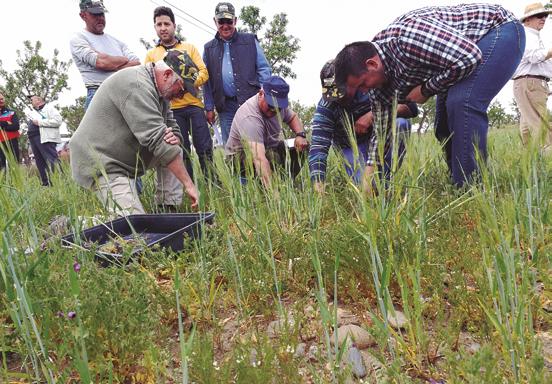
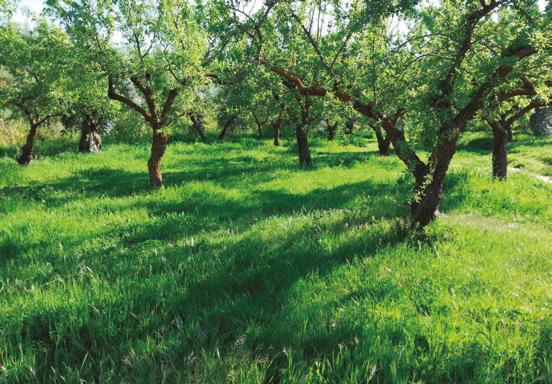
66 OTWO 23 / JUNE 2021 OTWO 23 / JUNE 2021 67
Farmer training in regenerative agriculture. Formación de agricultores en materia de agricultura regenerativa.
Vegetable cover in almond crops. Cubierta vegetal en cultivos de almendros.
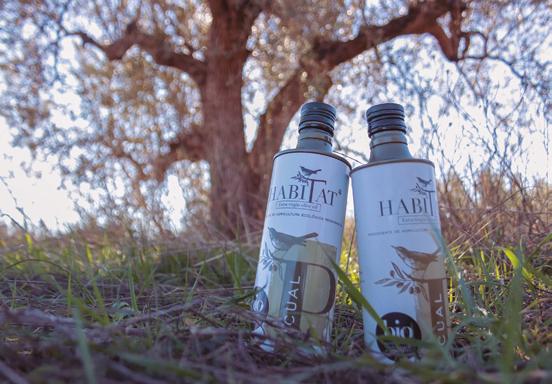
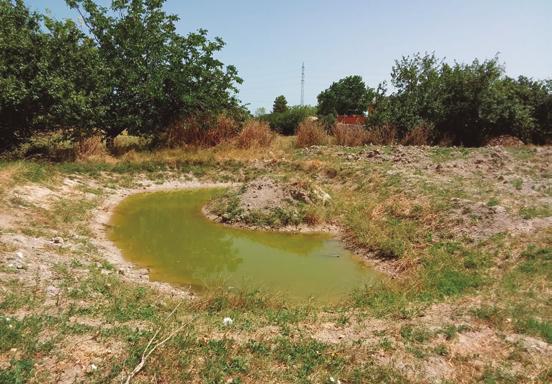
And with which it is intended to obtain the 4 Returns on which the philosophy of AlVelAl is based.
Return of natural capital through the repopulation with selected native species that will bring numerous environmental benefits to the area. The reduction and mitigation of erosion processes, the improvement of soil conditions, increase the capacity of the soil as a carbon sink, the increase of water infiltration and reduction of surface runoff; as well as favoring the populations of the large community of species that are part of the biodiversity of this territory such as birds, butterflies, bees, small mammals and reptiles; among others.
Return of social capital through the participation of APAFA - Association of Parents, Relatives and Friends of people with intellectual disabilities, creating jobs; the participation in some jobs of young students of IES José Marín de Vélez Rubio and citizen participation.
Return of economic capital, through the collection and transformation into products derived from the species used, mainly aromatic herbs. A work that is expected to be managed by APAFA in the coming years; maintaining, viability and marketing of products derived from aromatic plants such as essential oils and natural cosmetic products, among others. And as a tourist resource of nature, currently booming, and is that, due to its size, three hectares, will be a tourist attraction for the territory, being able to be enjoyed the different phases of flowering from viewpoints miles away.
Return of Inspiration, being a spectacle for all the senses that aims to be an environment of environmental disclosure and local heritage and culture, promoting knowledge of the culture of esparto grass in the territory, being located next to a prominent esparto grove with great ecological and cultural value. Awakening local pride through the connection with the origins of the territory and the sounds of nature; and presenting a model to follow for environmental, social and economic regeneration based on the enhancement of local resources.
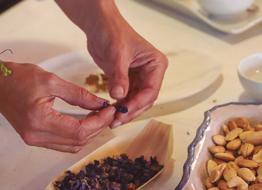
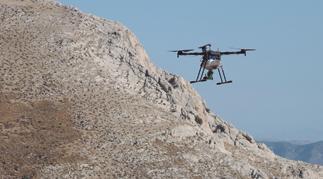
Semillado inteligente con drone de especies endémicas en el P.N. Sª María Los Vélez Smart seed drone of endemic species in the P.N. Sª María Los Vélez.
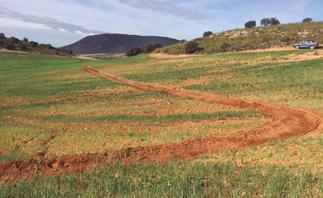
Arte, naturaleza y sociedad unidas a través de la restauración
AlVelAl 8000: Esculturas con vida es un proyecto innovador de regeneración paisajística un caso de negocio basado en la puesta en valor de los recursos locales a través de la repoblación forestal imitando a gran escala la figura del Indalo, presente en la Cueva de Los Letreros, declarada Patrimonio Mundial de la Humanidad por la UNESCO. Y con el que se pretenden obtener los 4 Retornos en los que se basa la filosofía de AlVelAl.
Retorno del capital natural a través de la repoblación con especies autóctonas seleccionadas que aportarán numerosos beneficios ambientales a la zona como la reducción y mitigación de los proce-
68 OTWO 23 / JUNE 2021 OTWO 23 69
Business example driven by AlVelAl. Ejemplo de negocio impulsados por AlVelAl.
Highest pond. Charca taller.
Infiltration trenches to prevent erosion. Zanjas de infiltración para prevenir la erosión.
sos erosivos, la mejora de las condiciones del suelo, incrementar la capacidad del suelo como sumidero de carbono, el aumento de la infiltración del agua y reducción de escorrentía superficial; así como favorecer las poblaciones de la gran comunidad de especies que forman parte de la biodiversidad de este territorio como son las aves, mariposas, abejas, pequeños mamíferos y reptiles; entre otros.
Retorno del capital social a través de la participación de APAFA - Asociación de Padres, Familiares y Amigos de personas con discapacidad intelectual, creando puestos de trabajo; la participación en algunos trabajos de jóvenes estudiantes del IES José Marín de Vélez Rubio y la participación ciudadana.

Retorno del capital económico, a través de la recolección y transformación en productos derivados de las especies utilizadas, principalmente hierbas aromáticas. Una labor que se espera en los próximos años gestione APAFA; llevando su manteniendo, viabilidad y comercialización de los productos derivados de las plantas aromáticas como aceites esenciales y productos de cosmética natural, entre otros. Y como recurso turístico de naturaleza, en la actualidad en auge; y es que, debido a sus dimensiones, tres hectáreas, supondrá un atractivo turístico para el territorio, pudiendo ser disfrutadas las distintas fases de su floración desde miradores a kilómetros de distancia.
Retorno de la Inspiración, siendo un espectáculo para todos los sentidos que pretende ser un entorno de divulgación ambiental y del patrimonio y cultura local, promocionando el conocimiento de la cultura del esparto en el territorio, al ubicarse junto a un prominente espartal con gran valor ecológico y cultural. Despertando el orgullo local a través de la conexión con los orígenes del territorio y los sonidos de la naturaleza; y presentando un modelo a seguir para la regeneración ambiental, social y económica basada en la puesta en valor de los recursos locales.
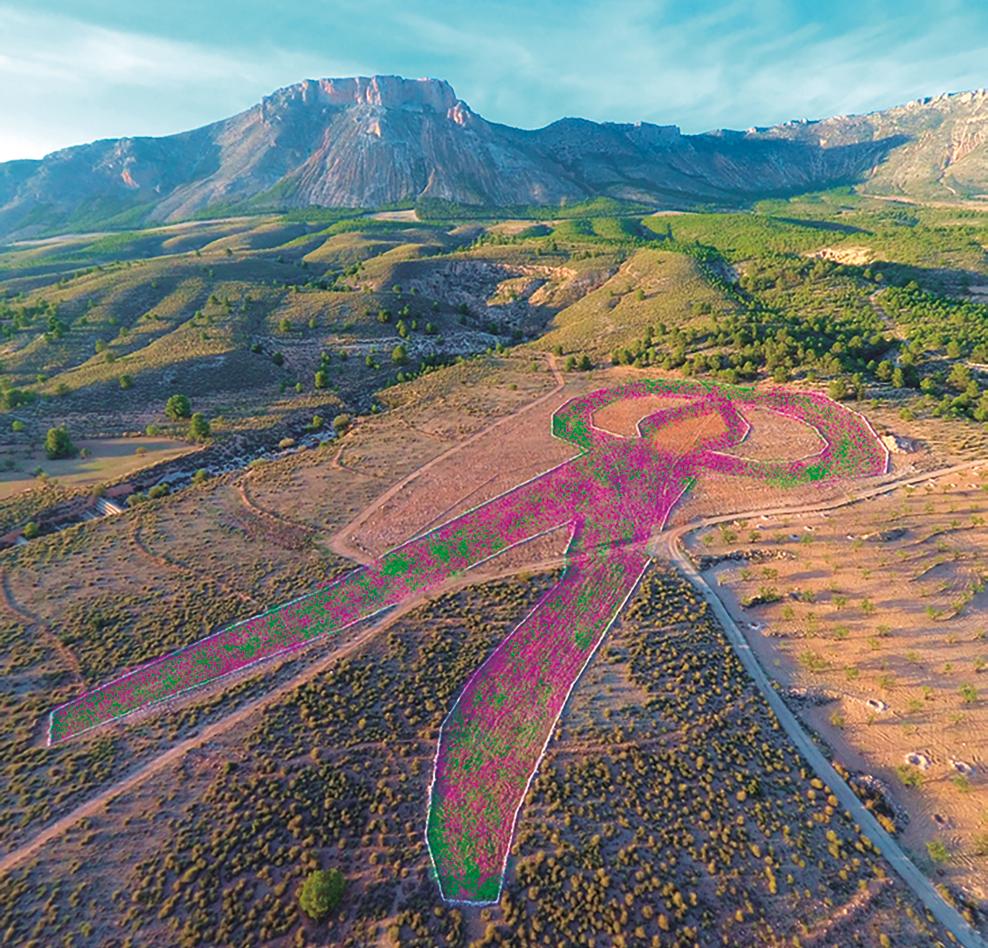
OTWO 23 / JUNE 2021 71 70 OTWO 23 / JUNE 2021
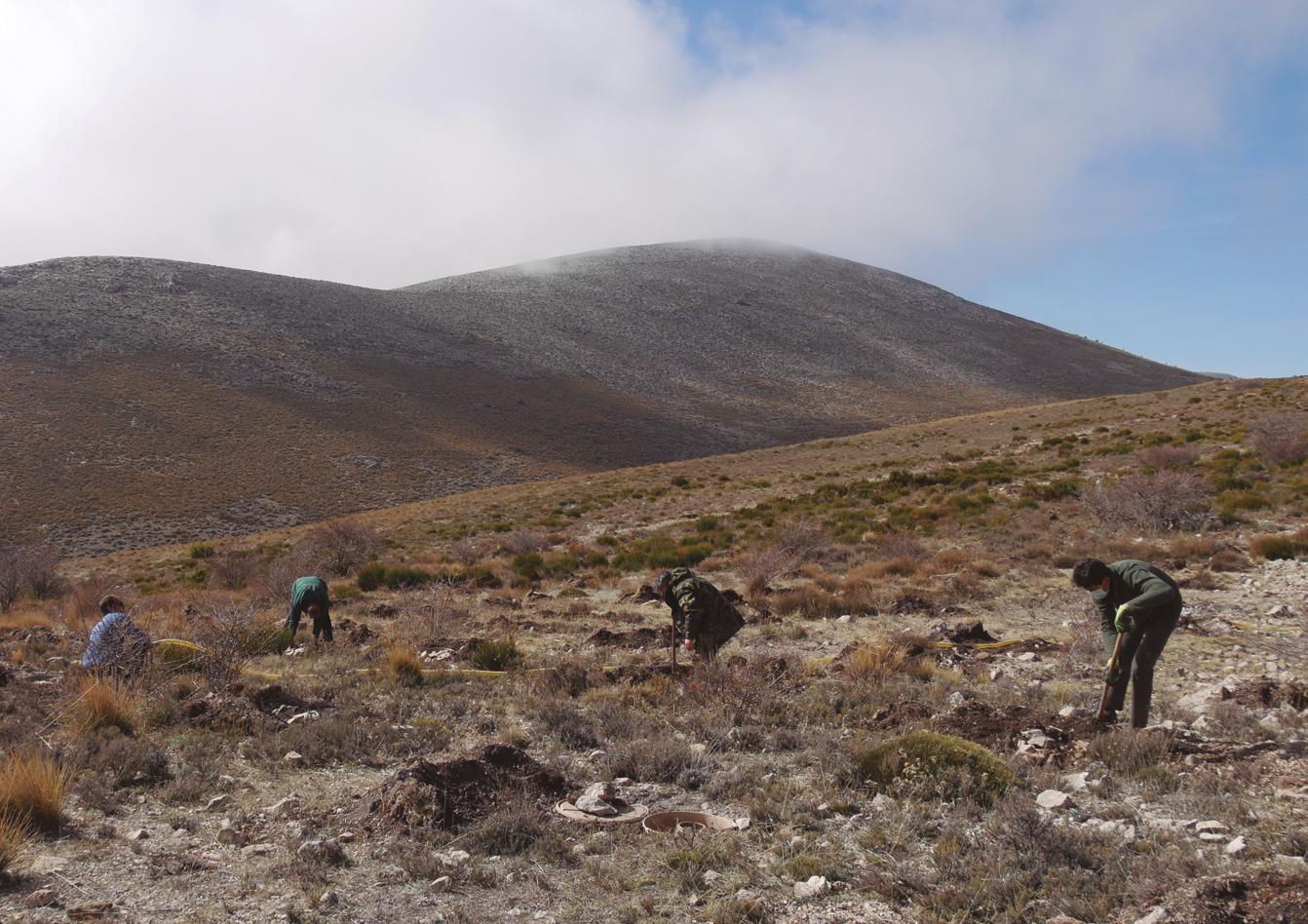
OTWO 23 / JUNE 2021 73 72 OTWO 23 / JUNE 2021

VOLUME 2 / VOLUMEN 2
Marijuana, kif, hashish and other herbs from the Rif
Marihuana, kif, hachís y otras yerbas del Rif
Juanlu González
Article and images


The dictionary of the Royal Spanish Academy says that kif comes from kayf, which in Arabic means “good mood”, such is the main effect that cannabis causes in those who consume it. However, marijuana is the term most commonly used in the West to designate this variety of hemp, while the word hashish, from the Arabic hashish -weed-, is used to designate the commercial product obtained from pressing the plant’s resin.
The effects of cannabis on the human psyche have been known for millennia, however, massive plantations for commercial use and export are very recent, specifically from the second half of the last century. Indeed, Morocco became in the sixties the largest producer of marijuana in the world and, since then, its image has been forever associated with that of this plant, especially the areas of Ketama and Chefchaouen. We all remember the funny film “Bajarse al Moro” by Fernando Colomo, which masterfully portrays the relationships that were established between both sides of the Strait of Gibraltar around the production and consumption of hashish.
Many argue that the word assassin actually comes from hashshashin, hashish consumer in Arabic. During the Middle Ages, at the time of the Crusades, a feared religious sect originated in the lands of present-day Iran. They occupied the castle of Alamut, the eagle’s nest, and that of Masyaf (yes, yes, that of Assasin Creed), impregnable fortresses where their faithful were trained in the arts of fighting and stealth to kill nobles, leaders and powerful people
Dice el diccionario de la Real Academia Española que kif proviene de kayf, que en árabe significa «buen humor», tal es el principal efecto que el cannabis provoca en quienes lo consumen. Sin embargo, marihuana es el término más empleado en Occidente para designar a esta variedad de cáñamo, mientras que el vocablo hachís, del árabe hashish —hierba—, se usa para designar al producto comercial obtenido del prensado de la resina de la planta.
Los efectos del cannabis en la psique humana se conocen desde hace milenios, sin embargo, las plantaciones masivas para uso comercial y la exportación son muy recientes, concretamente de la segunda mitad del siglo pasado. En efecto, Marruecos se convirtió en los años sesenta en el mayor productor de marihuana del mundo y, desde entonces, se asoció para siempre su imagen con la de esta planta, especialmente las zona de Ketama y Chefchaouen. Todos recordamos la divertida película “Bajarse al Moro” de Fernando Colomo, que retrata magistralmente las relaciones que se establecían entre ambas orillas del Estrecho de Gibraltar alrededor de la producción y el consumo de hachís.
Muchos defienden que la palabra asesino en realidad proviene de hashshashin, consumidor de hachís en árabe. Durante el medievo, en la época de las cruzadas se originó una temida secta religiosa en tierras de la actual Irán. Ocupaban el castillo de Alamut, el nido de águilas, y el de Masyaf (sí, sí, el de Assasin Creed), fortalezas inexpugnables donde se entrenaba a sus fieles en las artes de la lucha y el
76
OTWO 23 / JUNE 2021 OTWO 23 / JUNE 2021
of the region. While dwelling in the castles, the life of the assassins of the “Old Man of the Mountain”, as their spiritual leader was called, was a kind of paradise on earth. They did not work, had a great intellectual formation and refinement, ate pork, drank wine, enjoyed sexual liberties unknown at the time... and smoked a lot of hashish. When they had to leave the safety of their walls to face a mission, they could not return without having fulfilled it satisfactorily. Therefore, by their own account and by their special training, they had a high success rate. In fact, the word assassin in English has been immortalized to designate especially the magnicides. However, it seems that it was a false medieval attribution to the consumption of drugs made by their political rivals, by the prevailing religious orthodoxy, or by the references in the book “The Travels of Marco Polo”. However, the fact is that the two terms will remain forever linked.
The variety of hemp grown in the Maghreb country is obtained from a registered seed named “Morocco Beldia Kif”, which means more or less indigenous marijuana of Morocco, whose psychotropic effect is intoxicating and expansive, especially if we compare it with those cultivated in Asia, usually more of the introspective or relaxing. This cannabis is so adapted to the conditions environmental factors in the region that practically it is grown alone, hardly without care. In fact, it is possible to find small marijuana seedlings being born by the gutters, the roads or on the walls of the houses, without any problems, in the vicinity of the producing areas of the entire Rif.
Marijuana plantations are illegal in Morocco, but no one is unaware that it is a lucrative business in which the entire society of the region and of the Maghreb country is involved, absolutely all of it. It is not in vain that it is one of the fundamental pillars of the national Gross Domestic Product. Traveling from Chefchaouen to Alhoceima through the interior means crossing literally endless fields of “pot” that are lost on the horizon. It is hard to believe that they are outlawed by the authorities. In the aduares -mountain villages- it is increasingly common to find crops in the vicinity of houses, on roads or in any flat area deforested with an axe to obtain for a few years a saving crop to ensure the livelihood or to be able to move from living in a primitive hut to a brick house
sigilo para matar a nobles, líderes y gente poderosa de la región. Mientras moraban en los castillos, la vida de los asesinos del «Viejo de la Montaña», que es cómo se denominaba a su líder espiritual, era una especie de paraíso en la tierra. No trabajaban, tenían una gran formación intelectual y refinamiento, comían cerdo, bebían vino, gozaban de libertades sexuales desconocidas para la época… y fumaban mucho hachís. Cuando tenían que abandonar la seguridad de sus murallas para enfrentar una misión, no podían volver de nuevo sin haberla cumplido satisfactoriamente. Así que, por la cuenta que les traía y por su especial formación, tenían un alto porcentaje de éxito. De hecho, la palabra assassin en inglés ha quedado inmortalizada para designar especialmente a los magnicidios. No obstante, parece que fue una falsa atribución medieval al consumo de drogas hecha por sus rivales políticos, por la ortodoxia religiosa imperante, o por las referencias aparecidas en el libro «Los Viajes de Marco Polo». Pero el hecho es que ambos términos quedarán por siempre ligados. La variedad de cáñamo cultivada en el país magrebí se obtiene de una semilla registrada denominada «Marruecos Beldia Kif», que significa más o menos marihuana autóctona de Marruecos, cuyo efecto psicotrópico es de tipo embriagador y expansivo, sobre todo si lo comparamos con las cultivadas en Asia, por lo general más de tipo introspectivo o relajante. Este cannabis está tan adaptado a las condiciones ambientales de la región que prácticamente se cultiva solo, apenas sin cuidados. De hecho es posible encontrar pequeñas plántulas de marihuana naciendo por las cunetas, los caminos o sobre los muros de las viviendas, sin ningún tipo de problemas, en las inmediaciones de las zonas productoras de todo el Rif.
Las plantaciones de marihuana son ilegales en Marruecos, pero a nadie se le escapa que es un lucrativo negocio en el que está implicada toda la sociedad, absolutamente toda, de la región y del país magrebí. No en vano es uno de los pilares fundamentales del Producto Interior Bruto patrio. Viajar de Chefchaouen a Alhoceima por el interior significa atravesar literalmente campos interminables de “maría” que se pierden en el horizonte. Es difícil creer que estén proscritos por las autoridades. En los aduares —aldeas de montaña— cada vez es más
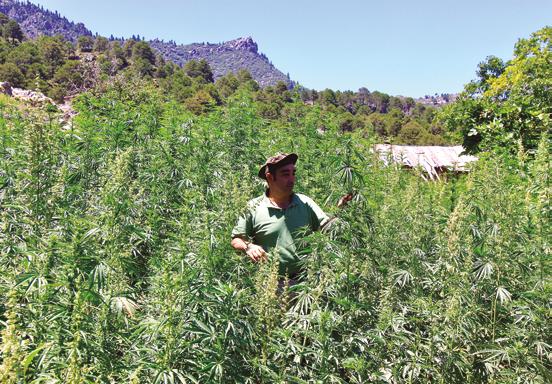
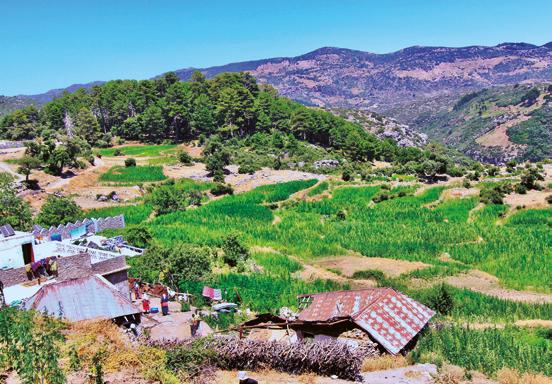
78 OTWO 23 / JUNE 2021 OTWO 23 / JUNE 2021 79
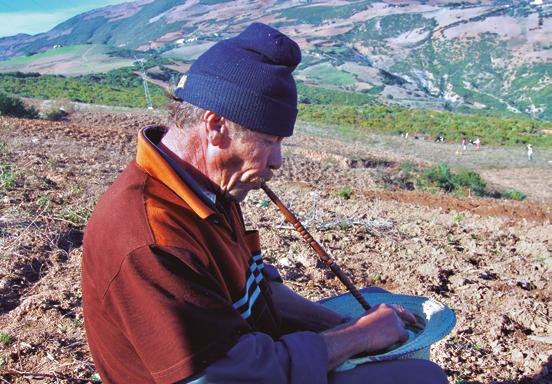
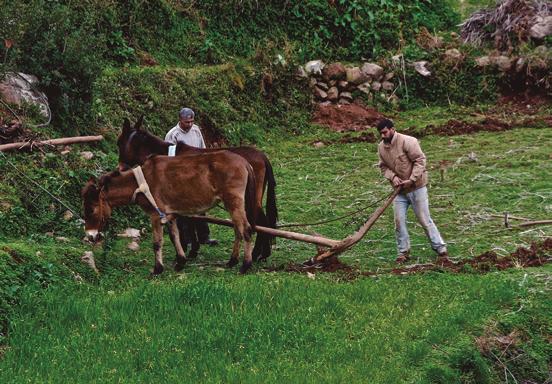
with XXI century standards. The degradation caused in cork oak or pinsapar forests is obvious and takes its toll in terms of loss of biodiversity and erosion, even in the interior of natural or national parks.
But, at the end of the day, Rifian farmers bear the brunt of the business. The lion’s share of the profits generated are left in the hands of middlemen and traffickers on both sides of the border. The fact that it is considered an illegal drug, even though its effects may be less harmful socially and in terms of health than, for example, those caused by alcohol, leads to the existence of a criminal network with undesirable consequences throughout the Strait region.
However, two recent developments could change this situation in the medium term. On the one hand, the UN, more specifically its Commission on Narcotic Drugs, reclassified cannabis at the end of last year, finally removing it from Schedule IV of the 1961 Single Convention on Narcotic Drugs, where it appeared sharing space with such lethal drugs as heroin. The reason for this drastic decision was the recognition of the therapeutic properties of cannabis, already fully accepted by the World Health Organization, which will open the doors to its medicinal use and to scientific research to adapt it to different treatments. Well, the first effect caused by this change in the classification of marijuana -which does not mean the general decriminalization of its cultivation or consumption-, is a hopeful announcement for the Rifian people, although not so much for the traffickers. The government’s intention is to legalize the cultivation and control the commercialization channels of cannabis for medicinal, cosmetic and industrial uses, which will allow a legal livelihood for more than one hundred thousand Rifian families and even increase their number, by allowing the planting on agricultural land in full view of everyone, leaving in peace the native forests that already have their share of logging, fires and overgrazing.
However, not all growers agree with the measure, many think that their already meager income will be reduced even further and that the regulatory change will be the final straw that will put an end to their way of life. The most normal scenario is that both markets will coexist for some time, since the demand for recreational hashish is not going to cease in Europe, even if the need for new, well-paid
frecuente encontrar cultivos en las cercanías de viviendas, en caminos o en cualquier zona llana deforestada a golpe de hacha para obtener durante unos años una cosecha salvadora que asegure el sustento o poder pasar de vivir en una primitiva cabaña a una casa de ladrillo con estándares del siglo XXI. La degradación provocada en alcornocales o pinsapares es manifiesta y se cobra su precio en pérdidas de biodiversidad y erosión, incluso en el interior de parques naturales o nacionales.
Pero, al fin y al cabo, los agricultores rifeños se llevan la peor parte del negocio. La mayor tajada de las plusvalías generadas, se quedan en manos de los intermediarios y los traficantes de ambas orillas. La consideración de droga ilegal, a pesar de que sus efectos puedan ser menos nocivos social y sanitariamente que, por ejemplo que los ocasionados por el alcohol, provoca la existencia de un entramado delictivo con consecuencias indeseables en toda la región del Estrecho.
Sin embargo, dos hechos recientes podrían cambiar esta situación a medio plazo. Por un lado, la ONU, más concretamente su Comisión de Estupefacientes, reclasificó a finales del pasado año al cannabis, sacándolo al fin de la Lista IV de la Convención Única de Estupefacientes de 1961, donde aparecía compartiendo espacio con drogas tan letales como la heroína. El motivo para esta drástica decisión fue el reconocimiento de las propiedades terapéuticas del cannabis, ya asumidas plenamente por la Organización Mundial de la Salud, que abrirá las puertas a su consumo medicinal y a la investigación científica para adaptarlo a distintos tratamientos. Pues bien, el primer efecto que ha provocado este cambio de clasificación de la marihuana —que tampoco significa la despenalización general de su cultivo o consumo—, es un anuncio esperanzador para el pueblo rifeño, aunque no tanto para los traficantes. La intención del gobierno es legalizar el cultivo y controlar los canales de comercialización del cannabis para usos medicinales, cosméticos e industriales, lo que permitirá un medio de vida legal para más de cien mil familias rifeñas e incluso incrementará su número, al permitir la siembra en terrenos agrícolas a la vista de todos, dejando en paz a los bosques originarios que ya tienen lo suyo con las talas, los incendios y el sobrepastoreo.
80 OTWO 23 / JUNE 2021 OTWO 23 / JUNE 2021 81
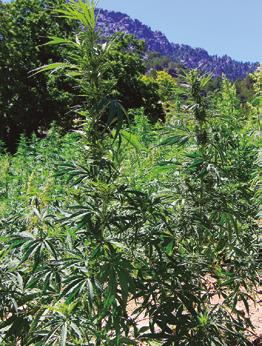
uses for hemp increases. Nor can it be expected that domestic consumption, not permitted but tolerated, will disappear in the Maghreb country, where it is customary to smoke hashish among the young and, above all, traditional kif among the elderly.
Kif is administered by mixing finely chopped cannabis with an extremely strong tobacco (taba). It is smoked in long wooden pipes, called sebsi, and a tiny clay bowl-very recognized and appreciated as a souvenir throughout northern Morocco-whose artisan production center is located in the medina of the city of Ouezzane, where all kinds of pipes are made, from the simplest and cheapest to more elaborate ones that mix various types of hardwoods and metal inlays and ornaments.
It was the brilliant Ramon Maria del Valle Inclán who glossed the effects of kifi in a brilliant and unforgettable poem, called La Pipa de Kif, with almost mystical overtones, with a style halfway between the currents of modernism and the purest avant-garde, written in the early twentieth century. One of its stanzas reads as follows: Divine plume of the sad forehead / in my pipe, the smoke gives its blue cry / my blood joyful clarity attends / if I burn the Green Grass of Istanbul.
No law can ever separate the Rifian from his sebsi, which is part of his culture and even his identity. It is something consubstantial to their culture and even to their identity. How can anyone renounce the eternal enjoyment of good humor?
No obstante, no todos los cultivadores están de acuerdo con la medida, muchos piensan que van a reducirse —aún más— sus ya exiguos ingresos y que el cambio normativo va a ser la puntilla final que acabe con su forma de vida. Lo más normal es que ambos mercados convivan durante un tiempo, ya que la demanda de hachís recreativo no va a cesar en Europa, por mucho que aumente la necesidad de nuevos usos bien remunerados para el cáñamo. Tampoco cabe esperar que el consumo interno, no permitido pero tolerado, desaparezca el país magrebí, donde es costumbre fumar hachís entre los jóvenes y, sobre todo, el kif tradicional entre los mayores. El kif se administra mezclando el cannabis muy picado con un tabaco extremadamente fuerte «el taba». Se fuma en largas pipas de madera, llamadas sebsi, y una minúscula cazoleta de barro—muy reconocidas y apreciadas como souvenir en todo el norte de Marruecos— cuyo centro de producción artesana se encuentra en la medina de la ciudad de Ouezzane, donde se fabrican todo tipo de pipas, desde las más simples y baratas a otras más elaboradas que mezclan varios tipos de maderas nobles e incrustaciones y adornos de metal.
Fue el genial Ramón María del Valle Inclán quien glosó los efectos del kifi en una genial e inolvidable poesía, denominada La Pipa de Kif, de tintes casi místicos, con un estilo a caballo entre las corrientes del modernismo y la más pura vanguardia, escrita a principios del siglo XX. Una de sus estrofas dice así: Divino penacho de la frente triste / en mi pipa el humo da su grito azul / mi sangre gozosa claridad asiste / si quemo la Verde Yerba de Estambul. Y es que ninguna ley podrá separar al rifeño de su sebsi. Es algo consustancial a su cultura e incluso a su identidad. ¿Cómo va a renunciar nadie a disfrutar eternamente del buen humor?
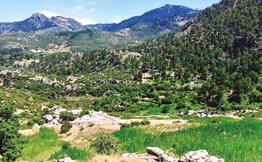
“Divine plume of the sad forehead in my pipe, the smoke gives its blue cry my blood joyful clarity attends if I burn the Green Grass of Istanbul”.
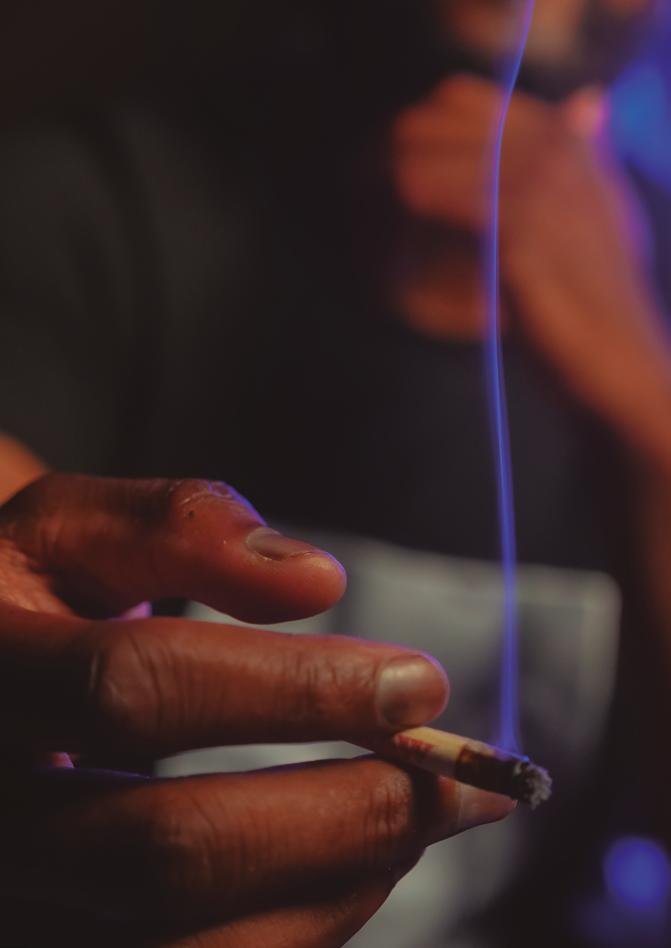
«Divino penacho de la frente triste en mi pipa el humo da su grito azul mi sangre gozosa claridad asiste si quemo la Verde Yerba de Estambul».
Ramón María del Valle Inclán
82 OTWO 23 / JUNE 2021
Photography: Pexels
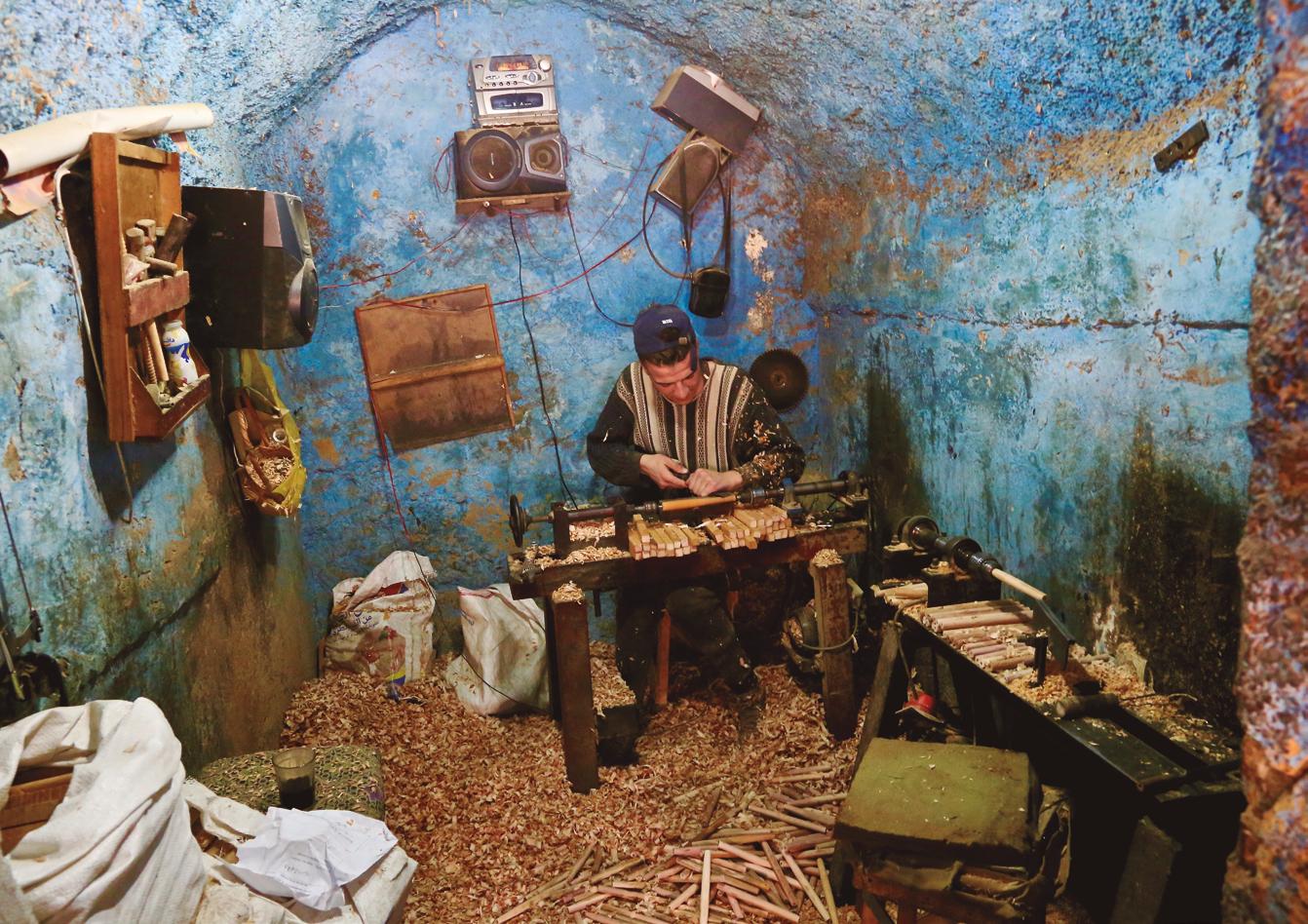
“On the one hand, the UN, more specificallyits Commission on Narcotic Drugs, reclassified cannabis at the end of last year, finally removing it from Schedule IV of the 1961 Single Convention on Narcotic Drugs, where it appeared sharing space with such lethal drugs as heroin.”
«Por un lado, la ONU, más concretamente su Comisión de Estupefacientes, reclasificó a finales del pasado año al cannabis, sacándolo al fin de la Lista IV de la Convención Única de Estupefacientes de 1961, donde aparecía compartiendo espacio con drogas tan letales como la heroína.»
OTWO 23 / JUNE 2021 85 84 OTWO 23 / JUNE 2021

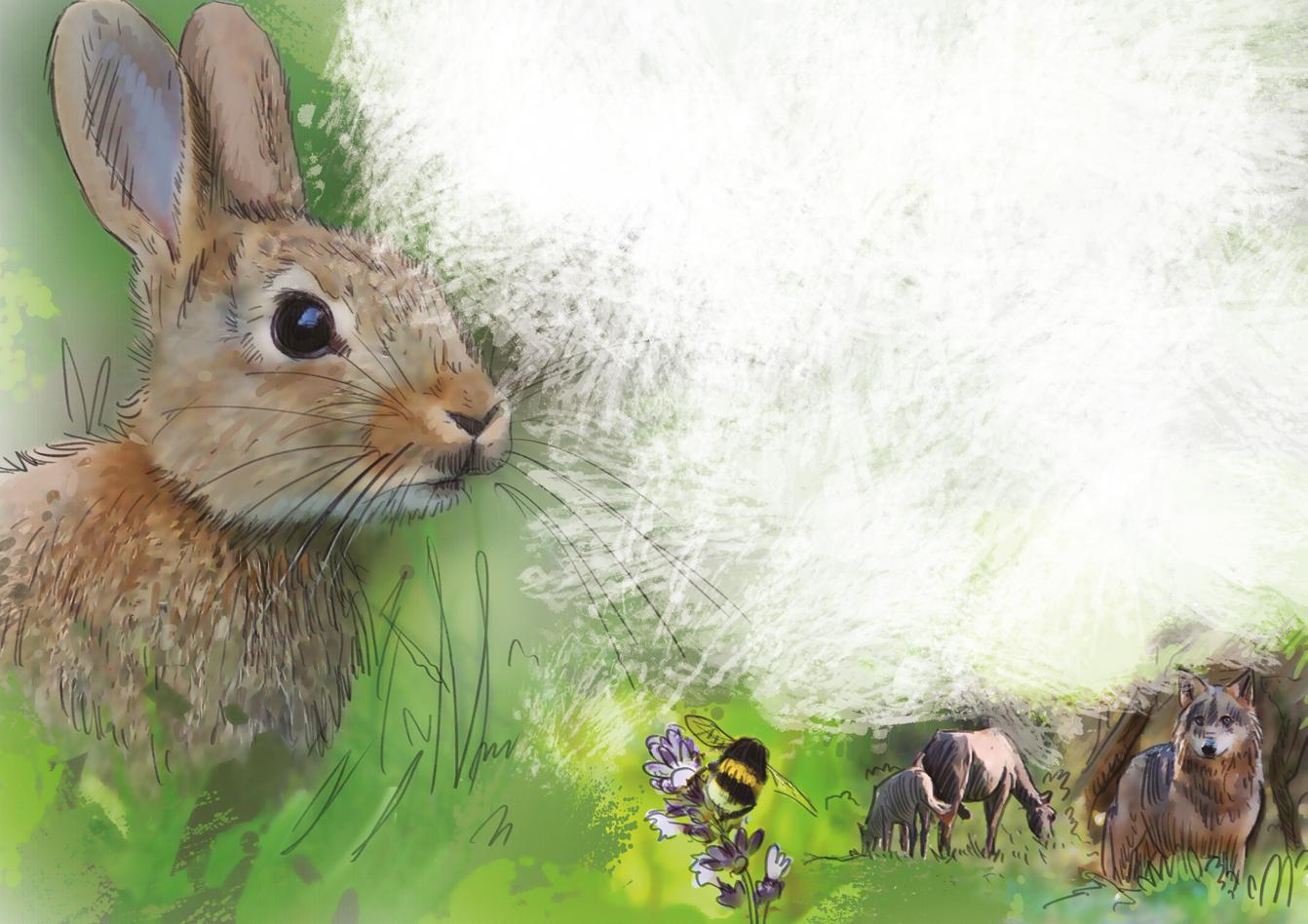
https://letsrewild.org/campaigns/whole-wild-world-rewild-the-algarve/
https://www.wholewildworld.org/support-us
WHO WE ARE WHAT WE DO
We are a group of passionate, dedicated individuals who want to make a difference.
Whole Wild World is an organization working to make the world wilder. Climate change, deforestation and habitat destruction are increasing at an alarming rate. The solution to this is easy, stop the destruction and work together to revive and restore the wild. Habitat restoration through rewilding is one of the most effective ways to undo the damage already done to our environment.
Habitats are the umbrella under which all species thrive. We need to act now to protect and revive habitats, save species and ultimately, ourselves.
Making the World Whole & Wild again...
We help facilitate projects to restore nature by raising the funds required to do this, supporting and developing land restoration, sustainable and nature-based tourism and species conservation projects to create symbiotic, self-sustaining eco-systems.
HOW YOU CAN HELP
Our foundation site is in the Algarve, a region of Portugal famed more for its stunning beaches and coastal life, than for its wildlife. Iberian species in Portugal have been in decline for most of the past century, farming is now also in decline and degraded farmlands are now derelict and at risk of wild fires and drought. Waterways are at risk from pollution and drought. Communities inland, that do not benefit from the tourism of the coast, are also in decline. Rewilding can help revive all of this, protecting biodiversity and nature. With the pandemic adding to the problem, nature-based tourism can be a solution. A solution that helps not just communities, but also wildlife; individual species and habitats. Visit our website: www.wholewildworld.org/support_us and find out how you can get involved, be it safeguarding a patch of Wild by becoming a Wild Guardian, or joining one of our upcoming fundraising events: ‘Running Wild’ or ‘Drive to Walk’. Contact us at info@wholewildworld.org for more information.
ILLUSTRATION: JUANJO TRUJILLO
El camino de la naturaleza
Nature’s Way
Owen Wiseman
Healing spaces. How does greenery benefit our healthcare facilities?
Espacios curativos. ¿Cómo beneficia la vegetación a nuestros centros sanitarios?

Hospitals evoke a variety of emotions. To some, they are the pinnacle of healing where incredible surgeons and medical staff perform miraculous procedures. To others, they are a cold place associated with grief, death and trauma. What if there were small ways to ensure all felt comfortable while in these centres of healing?
Our study of the month is focused on one lead by researchers from The Design Partnership and Plantree Alliance. They wanted to see what kinds of design elements in healthcare facilities, like hospitals, helped promote the patient and staff experience. Did nature have its way?
Of course! There were a lot of interesting findings such as the fact that sounds of nature, like the waves of an ocean, improve the quality of patients sleep in a healthcare setting. Rooms with more natural light help to reduce the sensation of pain, use of pain medications light opioids and even reduce the incidence of jaundice in babies. Views of nature in a variety of forms including art pieces and actual window views helped patients recover faster and report higher satisfaction with the presiding healthcare team. As we can see, adding in some natural elements is well-worth the investment to support everyone. Join us next month to learn how getting children into nature helps develop pro-environmental behaviours in later life. In the meantime, follow Science & Nature for weekly research bites and to connect with our author.
Schweitzer, Marc, Laura Gilpin, and Susan Frampton. “Healing spaces: elements of environmental design that make an impact on health.” Journal of Alternative & Complementary Medicine 10.Supplement 1 (2004): S-71.
Los hospitales evocan diversas emociones. Para algunos, son la cúspide de la curación, donde increíbles cirujanos y personal médico realizan procedimientos milagrosos. Para otros, son un lugar frío asociado al dolor, la muerte y el trauma. ¿Y si hubiera pequeñas formas de garantizar que todos se sientan cómodos mientras están en estos centros de curación?
Nuestro estudio del mes se centra en uno dirigido por investigadores de The Design Partnership y Plantree Alliance. Querían ver qué tipo de elementos de diseño en las instalaciones sanitarias, como los hospitales, ayudaban a promover la experiencia del paciente y del personal.
¿La naturaleza se salió con la suya?
Por supuesto. Hubo muchos hallazgos interesantes, como el hecho de que los sonidos de la naturaleza, como las olas de un océano, mejoran la calidad del sueño de los pacientes en un entorno sanitario. Las habitaciones con más luz natural ayudan a reducir la sensación de dolor, el uso de analgésicos opiáceos ligeros e incluso reducen la incidencia de ictericia en los bebés. Las vistas de la naturaleza en una variedad de formas, incluyendo piezas de arte y vistas reales de las ventanas, ayudaron a los pacientes a recuperarse más rápidamente y a informar de una mayor satisfacción con el equipo sanitario que los presidía. Como vemos, añadir algunos elementos naturales merece la pena la inversión para apoyar a todos.
Acompáñanos el mes que viene para saber cómo llevar a los niños a la naturaleza ayuda a desarrollar comportamientos pro ambientales en la vida posterior. Mientras tanto, sigue a Ciencia y Naturaleza para conocer las investigaciones semanales y conectar con nuestro autor.
Schweitzer, Marc, Laura Gilpin, and Susan Frampton. “Healing spaces: elements of environmental design that make an impact on health.” Journal of Alternative & Complementary Medicine 10.Supplement 1 (2004): S-71.
89 88
OTWO 23 / JUNE 2021 OTWO 23 / JUNE 2021

Nosha’s Savory Quesadillas
Las Quesadillas Sabrosas de Nosha´s
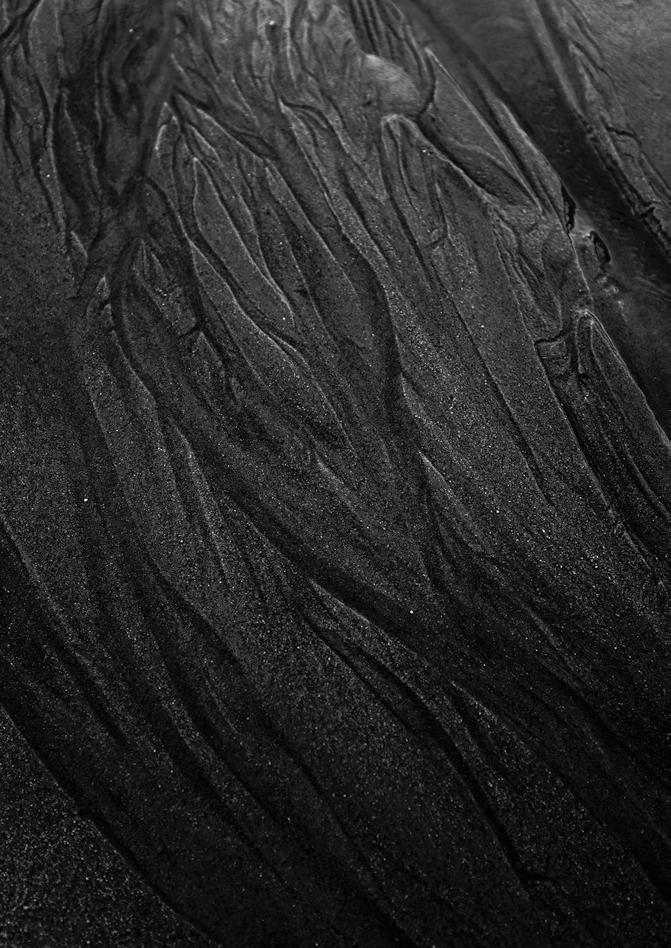
DESCRIPTION
You can make so many different variations and add sweet or savory dips of your choice... great for parties!!
INGREDIENTS
2 large quesadilla wraps.
1 cup mushrooms washed and chopped.
2 cloves garlic finely chopped.
1 cup cherry tomatoes halved.
1 cup red onions finely sliced.
1 ripe avocado mashed.
Pinch of salt and peppe.r
1 tea spoon olive oil.
2 teaspoons lime juice.
Press parsley for garnish.
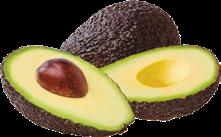
METHOD:
Heat the olive oil in a medium pan.
Sauté the garlic , onions, and mushrooms.
Add the tomatoes salt, pepper and lime juice and cook for a further 2 minutes.
Remove from heat and leave it stand . At this point there is too much liquid so let it cool and then drain any excess liquid.
Place the wraps on a flat surface and cut a slit up to the center of the wrap. This will make folding easier.
Spread the quesadilla wraps with the mashed avocado , divide the filling between both wraps and fold making triangles.
Place under the grill and garnish with fresh parsley.
DESCRIPCIÓN
Puedes hacer tantas variaciones diferentes y añadir salsas dulces o Dips sabrosos de tu elección...
¡Estupendo para las fiestas!
INGREDIENTES
2 envoltorios de quesadilla grandes.
1 taza de champiñones lavados y picados.
2 dientes de ajo finamente picados.
1 taza de tomates cherry cortados por la mitad.
1 taza de cebollas rojas cortadas en rodajas finas.
1 aguacate maduro machacado.
Una pizca de sal y pimienta.
1 cucharadita de aceite de oliva.
2 cucharaditas de zumo de lima. Reservar perejil para adornar.
PREPARACIÓN:
Calentar el aceite de oliva en una sartén mediana.
Saltear el ajo, la cebolla y los champiñones.
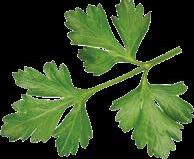
Añadir los tomates, la sal, la pimienta y el zumo de lima y cocinar durante 2 minutos más. Retirar del fuego y dejar reposar . En este punto hay demasiado líquido, así que déjelo enfriar y luego escurra el exceso de líquido.
Coloque los envoltorios en una superficie plana y haga un corte hasta el centro del envoltorio. Esto facilitará el plegado.
Unte los wraps de quesadilla con el puré de aguacate, divida el relleno entre ambos wraps y doble haciendo triángulos.
Colocar bajo la parrilla y adornar con perejil fresco.

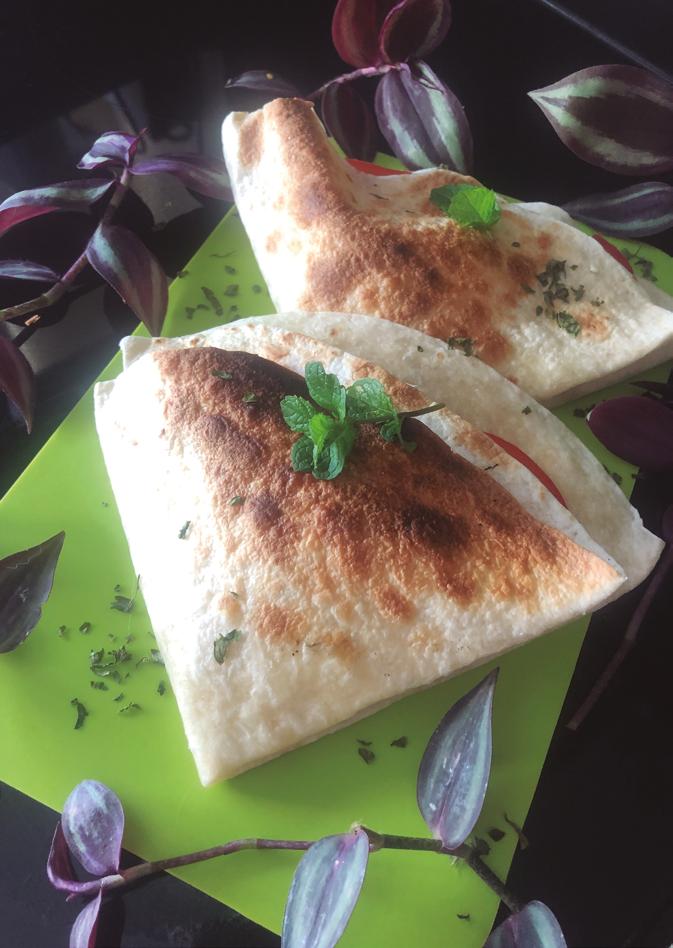
90 91
OTWO 23 / JUNE 2021 OTWO 23 / JUNE 2021
Guía rápida de: Escocia
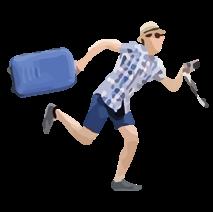
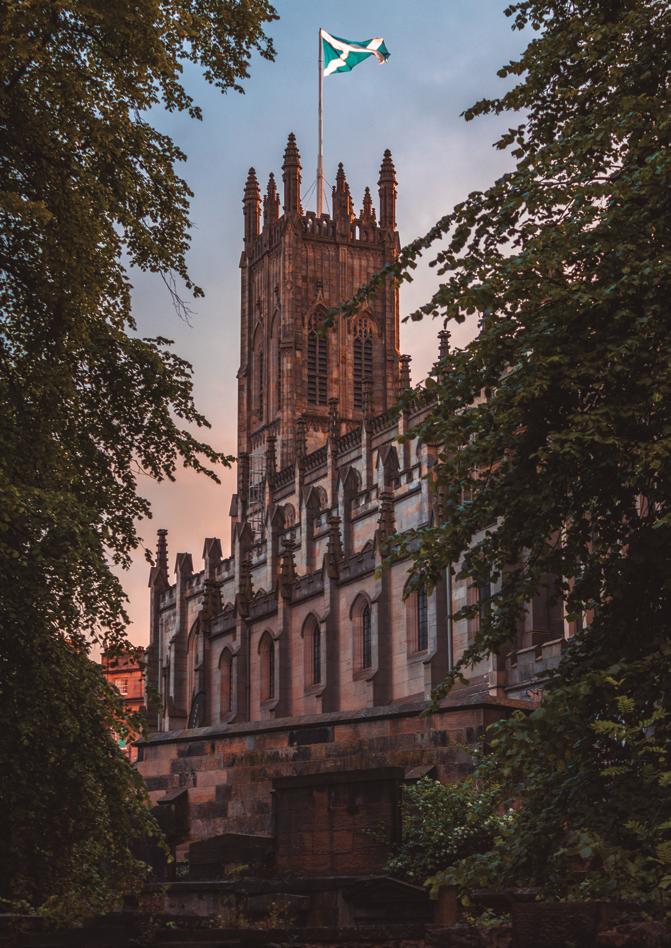
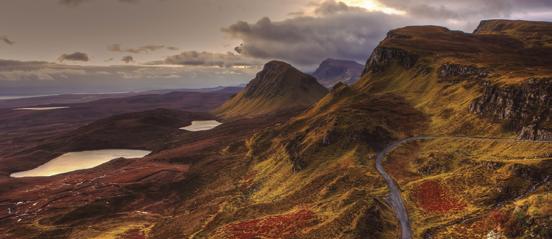
Language: English / Scottish Gaelic.
Currency: GBP.
Capital: Edinburgh.
Famous for: Whisky. The Highlands. Loch Ness.
Some top places: Explore the historical and beautiful capital of Edinburgh. Climb the summit trail of Ben Nevis–Britain’s highest peak. Follow the old routes used by clans’ people in the stunning Glen Coe. Marvel at the Isle of Skye’s natural beauty and wild landscapes. Discover the castles, distilleries and breath-taking nature of Cairngorms National Park. Enjoy great culture, food and shopping in Glasgow. Visit Scotland’s first national park and the scenic Loch Lomond.

Activities: Hiking, water sports, golf, climbing, whale watching, mountain biking, gastronomy, culture.
Weather:
High Season (Jul - Aug) Warmer weather but rainy.
Shoulder (May, Jun & Sep) Cooler but dryer weather.
Low Season (Oct - Apr) Cold weather, snow.
Eco fact: In 2020, the equivalent of 97.4% of Scotland’s gross electricity consumption was from renewable sources.
Eco resorts:
Budget: Best Western Kings Manor from £59 per night (Edinburgh).
Mid: The Lazy Duck from £90 per night (Nethy Bridge - Highlands).
Luxury: Eagle Brae Log Cabins from £215 per night (Struy - Highlands).
Idioma: Inglés / gaélico escocés.
Moneda: GBP.
Capital: Edimburgo.
Famoso por: Whisky. Las Highlands. Lago Ness. Algunos de los mejores lugares: Explorar la histórica y bella capital de Edimburgo. Suba al sendero de la cumbre de Ben Nevis, el pico más alto de Gran Bretaña. Siga las antiguas rutas utilizadas por los clanes en el impresionante Glen Coe. Maravíllese con la belleza natural y los paisajes salvajes de la isla de Skye. Descubra los castillos, las destilerías y la impresionante naturaleza del Parque Nacional de Cairngorms. Disfrute de la gran cultura, la gastronomía y las compras en Glasgow. Visite el primer parque nacional de Escocia y el pintoresco Loch Lomond.
Actividades: Senderismo, deportes acuáticos, golf, escalada, avistamiento de cetáceos, bicicleta de montaña, gastronomía, cultura.
Clima:
Temporada alta (julio-agosto): Tiempo más cálido pero lluvioso.
Temporada media (mayo, junio y septiembre): Tiempo más fresco pero seco.
Temporada baja (octubre-abril): Tiempo frío, nieve.
Hecho ecológico:
En 2020, el equivalente al 97,4% del consumo bruto de electricidad de Escocia procedía de fuentes renovables.
Resorts ecológicos:
Económico: Best Western Kings Manor desde 59 libras por noche (Edimburgo).
Medio: The Lazy Duck desde 90 libras por noche (Nethy Bridge - Highlands).
Lujo: Eagle Brae Log Cabins desde 215 libras por noche (Struy - Highlands).
93 92
OTWO 23 / JUNE 2021 OTWO 23 / JUNE 2021
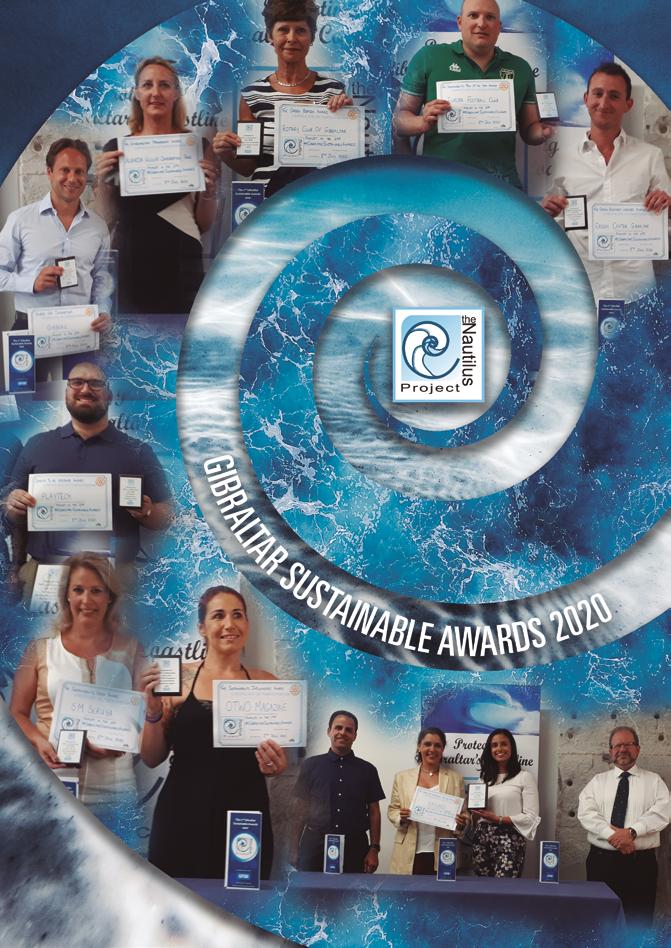
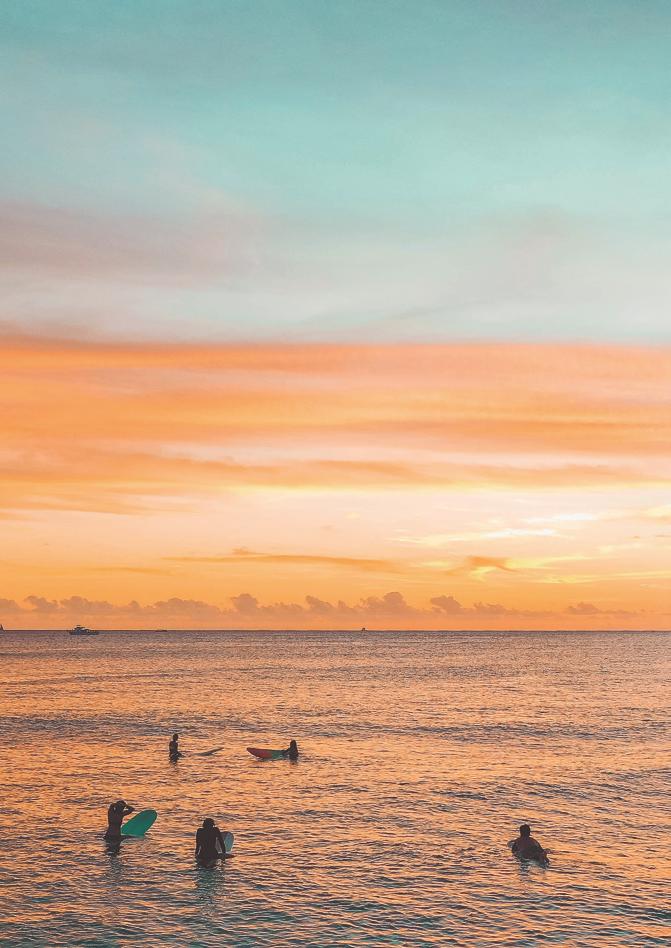
Transport available for groups.Check with us for your requirements. OTWO is a facilitator on these packages. All activities are contracted directly between the respective centre operator and the client.
Prices are for the month of June only, please contact us for other dates.
Transporte disponible para grupos. Consultenos si estás interesado. OTWO es un mediador de estos paquetes. Todas las actividades se contratan directamente entre el operador y el cliente.
Precios válidos solo para el mes de junio, consulte para otras fechas.
95 Catálogo de Experiencias PRIMAVERA / VERANO 21 Organized by: OTWO Magazine
+00350 22500799
Tel.
nfo@otwomag.com
/ SUMMER CATALOG 21 OTWO 23 / JUNE 2021
SPRING
Alameda Wildlife Conservation Park. Environmental Stewardship Award
SM Seruya. Sustainability Vision Award
OTWO. Sustainability Influencers Award
Gibbeau. Award for Innovation
Playtech. Daring To Be Greener Award
Europa FC. Sustainability Team of the Year
Eroski Center Gibraltar. Green Business Leaders Award
Rotary Club of Gibraltar. The Green Beacon Award
2020
Hassans. The Gibraltar Sustainable Business Award
In2Adventures Stand Up Paddle Lessons
In2Adventures Clases de remo de pie (SUP)
We are a Gibraltar based adventure and activity company established in 2013. We promote the importance of a healthy lifestyle through fun-based activities tailored to our clients needs.
Our aim is to respectfully promote the amazing natural features of our environment. We work with a number of local charities and believe in the community. We encourage people to explore Gibraltar and enjoy the outdoors through our activities. Our Core values are based on combining adventure, the outdoors, education and fun.
Gibraltar has a fantastic caring community and at the core of In2adventures culture is an aim to help strengthen our Community. We work closely with charities to raise money for worthy causes and provide a platform for educating and inspiring young people.
“SUP” Lesson
Join us for a beginners SUP session to learn the basics from kneeling and to finally stand up paddle boarding. Once you have completed this session, you are able to join on other more advanced SUP adventures such as the Sunset and the SUP safari around the stunning southerly coastline of Gibraltar. This session is for people who are keen to develop paddling skills, learn the correct techniques and keep safe on the water.
SUP Certificate included for completing the lesson. 2 HOURS
INCLUDES: Board, Paddle & instructor.
MAY WE RECOMMEND:Buoyancy Aid £5 per guest per hour. Wet suit £5 per guest per hour.
£35 PER PERSON

Somos una empresa de aventura y actividades con sede en Gibraltar establecida en 2013. Promovemos la importancia de un estilo de vida saludable a través de actividades basadas en la diversión y adaptadas a las necesidades de nuestros clientes. Nuestro objetivo es promover respetuosamente las increíbles características naturales de nuestro entorno. Trabajamos con varias organizaciones benéficas locales y creemos en la comunidad. Animamos a la gente a explorar Gibraltar y a disfrutar del aire libre a través de nuestras actividades. Nuestros valores fundamentales se basan en la combinación de la aventura, el aire libre, la educación y la diversión. Gibraltar cuenta con una fantástica comunidad solidaria y en el centro de la cultura de In2adventures está el objetivo de ayudar a fortalecer nuestra Comunidad. Trabajamos estrechamente con organizaciones benéficas para recaudar fondos para causas dignas y proporcionamos una plataforma para educar e inspirar a los jóvenes.
Clases de “SUP”
Acompáñanos en nuestras clases de SUP para principiantes, para aprender los fundamentos desde el arrodillamiento hasta el stand up paddle boarding. Una vez que hayas completado esta sesión, podrás unirte a otras aventuras de SUP más avanzadas, como la puesta de sol y el safari de SUP alrededor de la impresionante costa del sur de Gibraltar. Esta sesión es para personas que quieren desarrollar sus habilidades de remo, aprender las técnicas correctas y mantenerse seguras en el agua. Certificado SUP incluido por completar la clase.
2 HORAS
INCLUYE: Tabla, remo e instructor.
PODEMOS RECOMENDAR: Chaleco salvavidas 5 libras por persona y hora. Traje de neopreno £5 por huésped por hora.
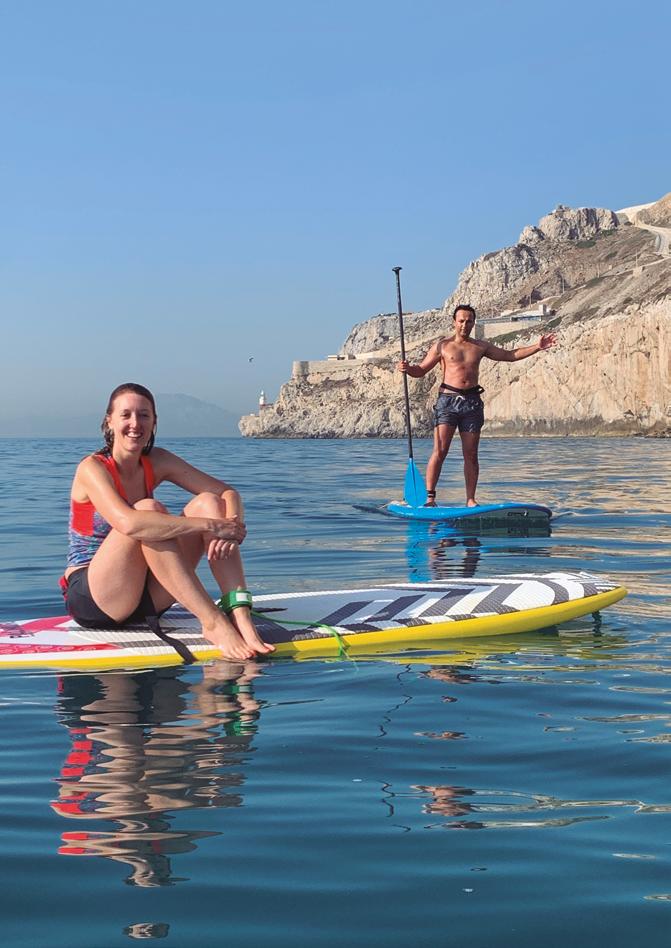
Jimmy Gracia
Jimmy is an outdoors man and is qualified as an instructor in many adventure activities. A keen mountaineer and also a qualified paddle sport coach, his teaching technique is first class. Following a full successful career in the military he developed his outdoor instructor skills and trained in the outdoor industry in Cornwall. He has been on numerous expeditions around the world including high altitude mountaineering in the Himalayas and paddle boarding across the Straights of Gibraltar.
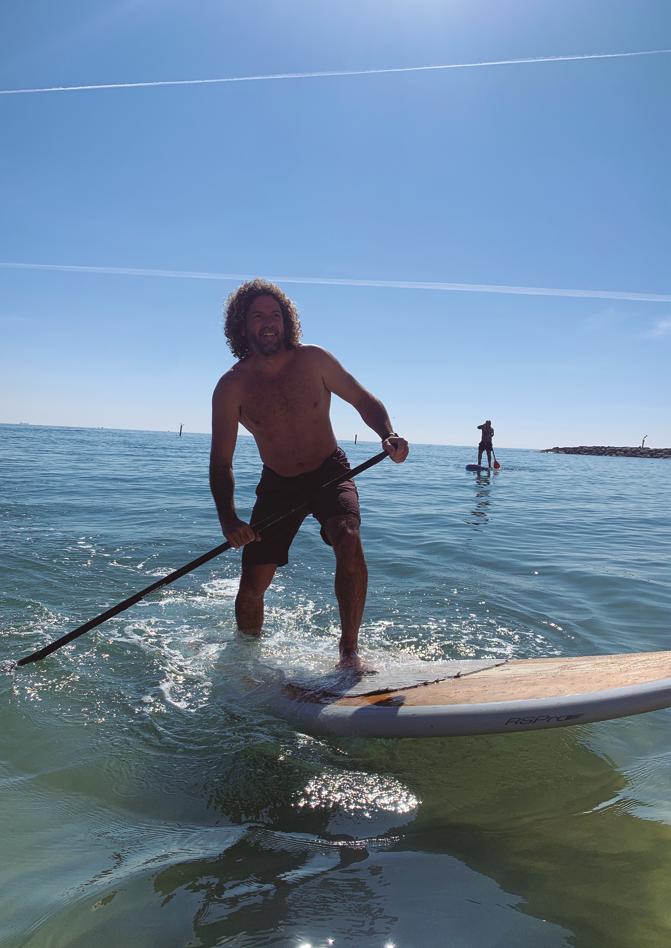
Jimmy Gracia
Jimmy es un hombre del aire libre y está cualificado como instructor en muchas actividades de aventura. Es un montañero entusiasta y también un entrenador cualificado de deportes de remo, su técnica de enseñanza es de primera clase. Tras una exitosa carrera en el ejército, desarrolló sus habilidades como instructor de actividades al aire libre y se formó en la industria de las actividades al aire libre en Cornualles. Ha participado en numerosas expediciones por todo el mundo, incluyendo montañismo de gran altitud en el Himalaya y paddle boarding a través del Estrecho de Gibraltar.
OTWO 23 / JUNE 2021 97 96 OTWO 23 / JUNE 2021
35 LIBRAS POR PERSONA
Rent a EBike and get a FREE entrance to the Alameda Wildlife Conservation Park
Alquile una EBike y obtenga una entrada GRATUITA al Alameda Wildlife Conservation Park.

¿Qué está incluido?
- Moneda de conservación. Esta moneda benéfica de madera se entrega al ingresar al parque, luego se puede depositar para mostrar su apoyo a la organización benéfica de conservación de su elección. - Bicicleta electrónica premium de Riese & Müller. - Casco de bicicleta.
- Instrucción de seguridad.
Recoger y dejar en:
Tienda EBike Experience, Imperial Ocean Plaza, Ocean Village, Gibraltar GX11 1AA
Nuestras bicicletas eléctricas premium no contaminantes de Riese & Müller son adecuadas para todos los que midan más de 155 cm, más de 12 años y sean capaces de montar en bicicleta.
Se aceptan reservas individuales.
What’s Included?
- A Conservation Coin. This sustainable wooden charity coin given as you enter the park, this can then be deposited to show your support on the conservation charity of their choice.
- Premium eBike by Riese&Müller.
- Cycle helmet.
- Safety instruction.
Pick up and drop off: EBike Experience Store, Imperial Ocean Plaza, Ocean Village, Gibraltar GX11 1AA.
Our premium, non-polluting eBikes from Riese&Müller are suitable for everyone who is over 155 cm, over 12 years old and capable of riding a bicycle.
Individual bookings accepted.
To check availability and book your ride please complete the online booking process. If you have any queries please call +350 56004948 or email info@ebike-gibraltar.com.
Full day: 10:00-18:00.
Price: £35 Full day.
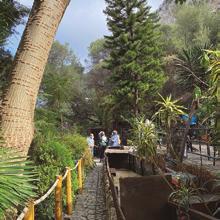
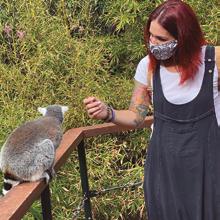
Para verificar la disponibilidad y reservar su viaje, complete el proceso de reserva online. Si tiene alguna pregunta, llame al +350 56004948 o envíe un correo electrónico a info@ebike-gibraltar.com.
Día completo: 10:00 - 18:00.
Precio: £35 Día completo
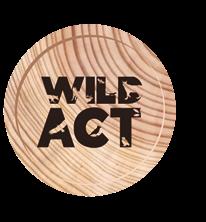
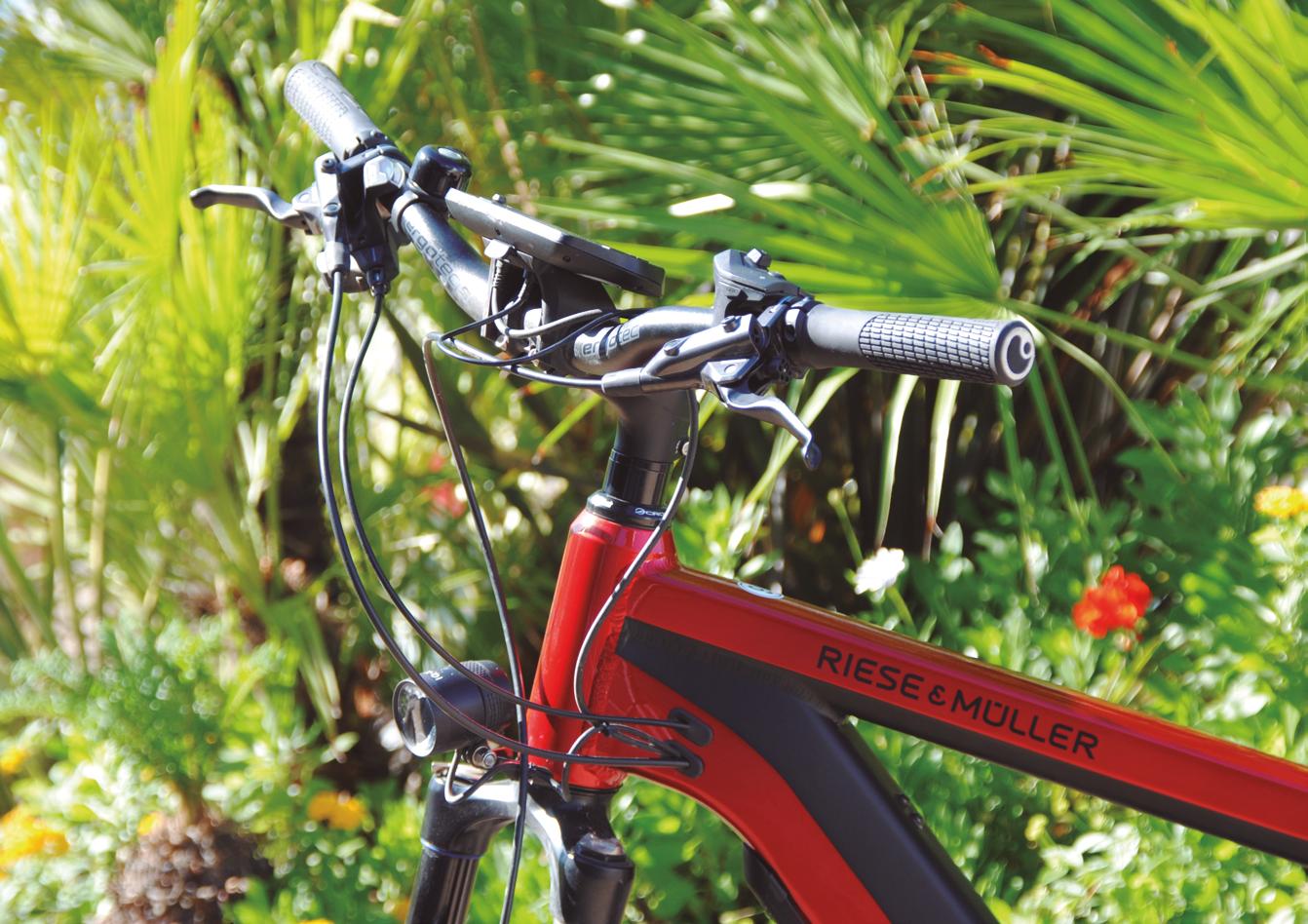
99 98
OTWO 23 / JUNE 2021 OTWO 23 / JUNE 2021
Adventure in the Natural Park Los alcornocales.
Cádiz and Málaga. Canyoning level 2
Canyoning is a very exciting adventure. It consists of descending through the high course of a river, progressing through all the obstacles that nature proposes: jumps into the water, natural slides, rappels, abseiling and much more.
According to the amount of water load, duration and obligatory nature of the obstacles, they are categorized in different levels.
We propose a level 2 canyon, difficult with several stretches that cannot be avoided and quite difficult if you are not in good physical condition. Rappels and jumps are mandatory.
Canyon of The Buitreras.
The Cañón de las Buitreras is considered the cathedral of canyoning. Located in the heart of the Natural Park of Los Alcornocales, it is one of the most beautiful canyons in Spain. The Guadiaro River has excavated over millions of years a gorge in some sections of almost 150 meters high.
After making the transfer of vehicles, we will arrive after a dizzying descent to the railway and the beginning of the ravine. At the beginning, three rappels, not very high but quite technical. After the third rappel we cross the first sections of swimming between the walls of the ravine. We will arrive at the fourth and fifth rappel that we will be able to avoid with a jump of almost 10 meters. It remains to cross more swimming areas to reach some sinks known as washing machines. These are very dangerous siphons when the canyon is full of water. We still have a second stretch of swimming to reach the end of the narrowest part of the gorge.
Here a short break to continue the adventure with different obstacles, finally about 200 meters of swimming to finish the canyon. We still have 30 minutes of hiking to reach our vehicles.
Because the ravine is located in the Natural Park and its danger due to flooding, permission is only granted from June 15 to November 15.
Duration:
6 to 7 hours.
Minimum/Maximum number of participants:
7/10 participants.
Recommended Dates: Summer and autumn only.
Services:
Specialized monitors and equipment.
All technical equipment
First aid kit.
RC and Accident Insurance
Photographic report with video summary
Pricing: Canyoning..........€50
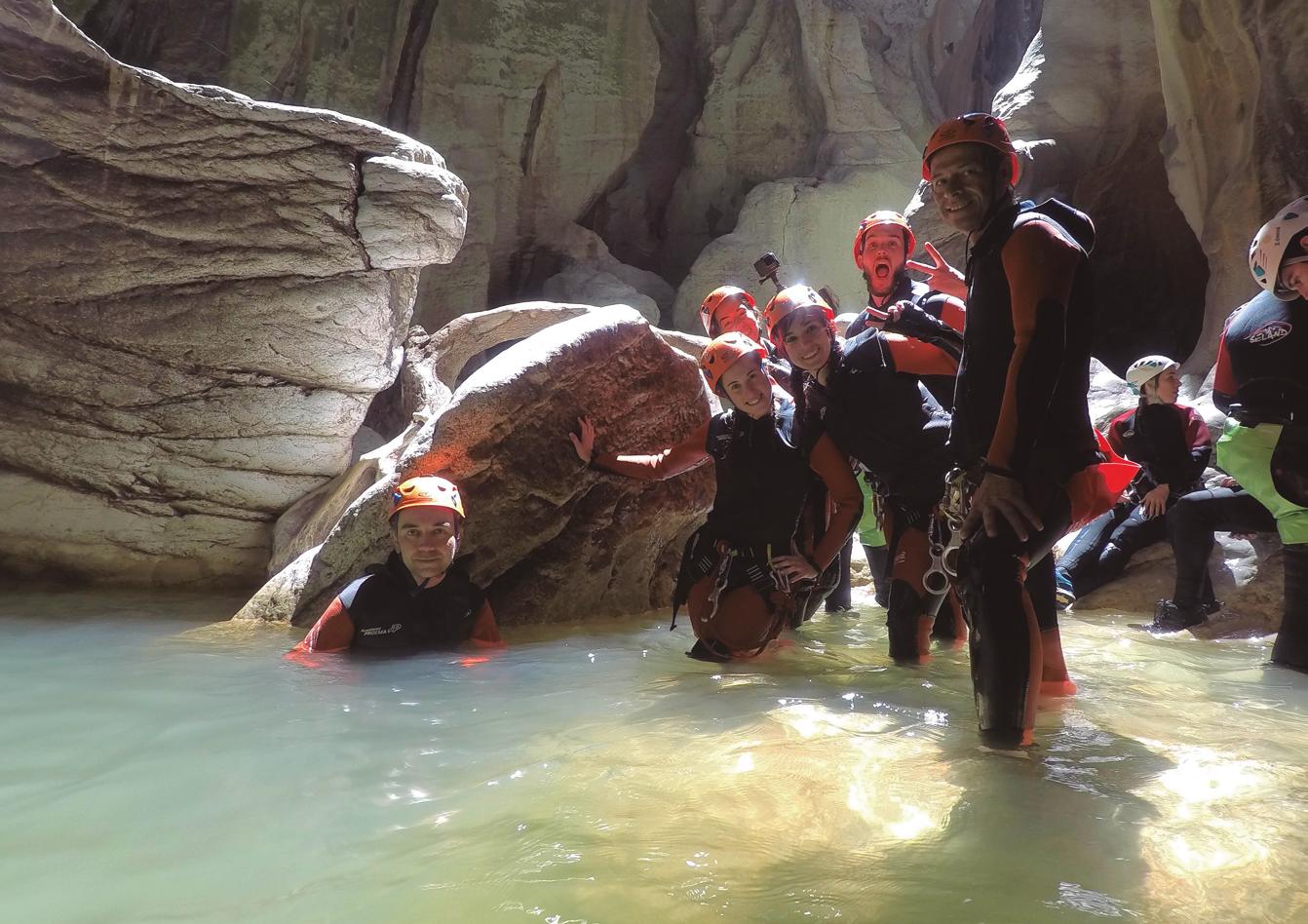
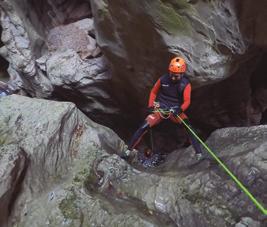
OTWO 23 / JUNE 2021 101
100
Aventura en el Parque Patural Los Alcornocales
Cádiz y Málaga. Barranquismo de nivel 2
El descenso de barrancos o barranquismo es una aventura muy emocionante. Consiste el descender por el curso alto de un río progresando a través de todos los obstáculos que te propone la naturaleza: saltos al agua, toboganes naturales, ráppeles, destrepes y mucho más.
Según la cantidad de carga de agua, duración y obligatoriedad de los obstáculos se categorizan en distintos niveles.
Proponemos un barranco de nivel 2, difícil con varios tramos no evitables y bastante dificultad sino se está en una buena condición física. Ráppeles y saltos obligatorios.
Cañón de Las Buitreras
El Cañón de las Buitreras está considerado como la catedral del barranquismo. Situado en pleno corazón del Parque Natural de Los Alcornocales, es uno de los barrancos más bellos de España. El río Guadiaro ha excavado a lo largo de millones de años una garganta en algunos tramos de casi 150 metros de altura.
Tras hacer el transfer de vehículos, llegaremos tras un vertiginoso descenso hasta la vía del tren y el comienzo del barranco. Al comenzar tres ráppeles, no muy altos pero bastante técnicos. Tras el tercer ráppel atravesamos los primeros tramos de nado entre las paredes del barranco. Llegaremos al cuarto y quinto ráppel que podremos evitar con un salto de casi 10 metros. Queda atravesar más zonas de nado para llegar hasta unas marmitas conocidas como las lavadoras. Son sifones muy peligrosos cuando el barranco va en carga de agua. Todavia nos queda un segundo tramo de nado para llegar al final de la parte más angosta de la garganta. Aquí un pequeño descanso para seguir la aventura con diferentes obstáculos, finalmente unos 200 metros de nada final para acabar el barranco.
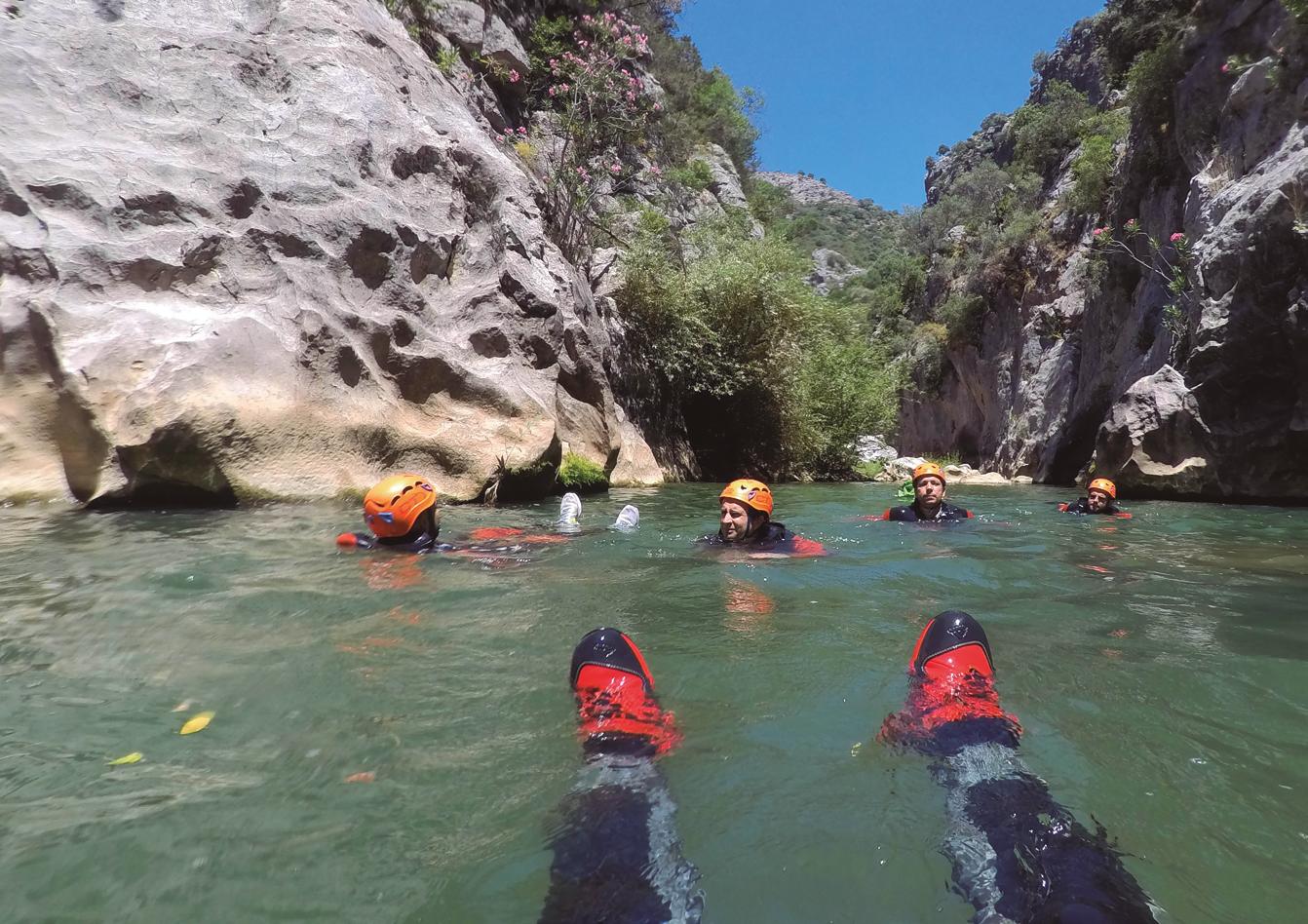
Todavía nos queda 30 minutos de senderismo para llegar a nuestros vehículos.
Debido a que el barranco se encuentra en el Parque Natural y su peligrosidad por las crecidas sólo se concede permiso del 15 de Junio al 15 de Noviembre.
Duración:
De 6 a 7 horas.
Mínimo/Máximo de participantes:
7/10 participantes.
Fechas Recomendadas:
Sólo verano y otoño.
Servicios:
Monitores y equipos especializados.
Todo el material técnico.
Botiquín primeros auxilios.
Seguros RC y Accidentes.
Reportaje fotográfico con vídeo resumen.
Precios: Barranquismo……….50€
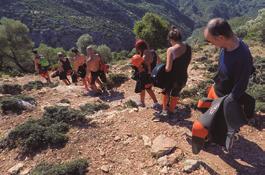
OTWO 23 / JUNE 2021 103 102 OTWO 23 / JUNE 2021
